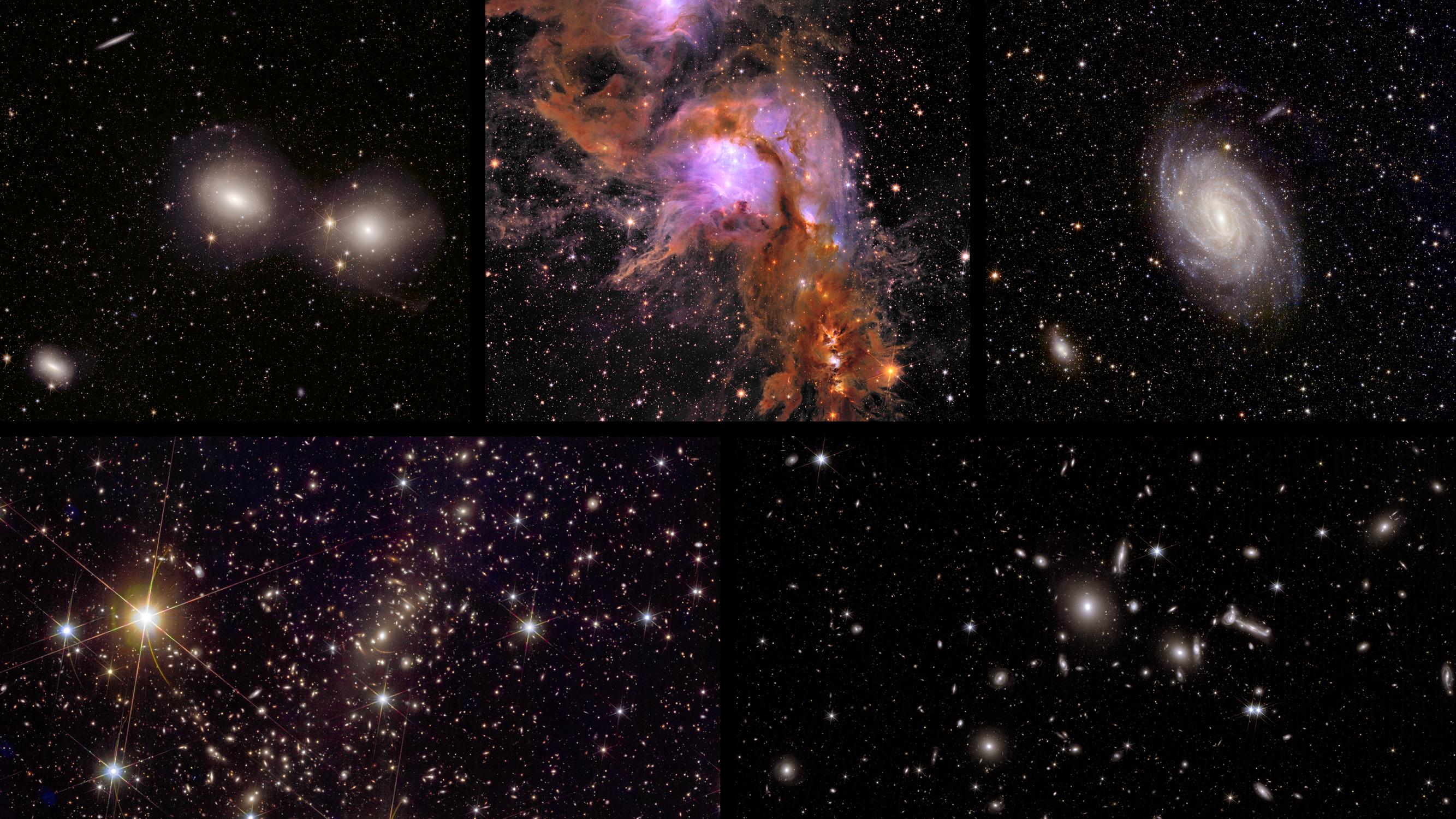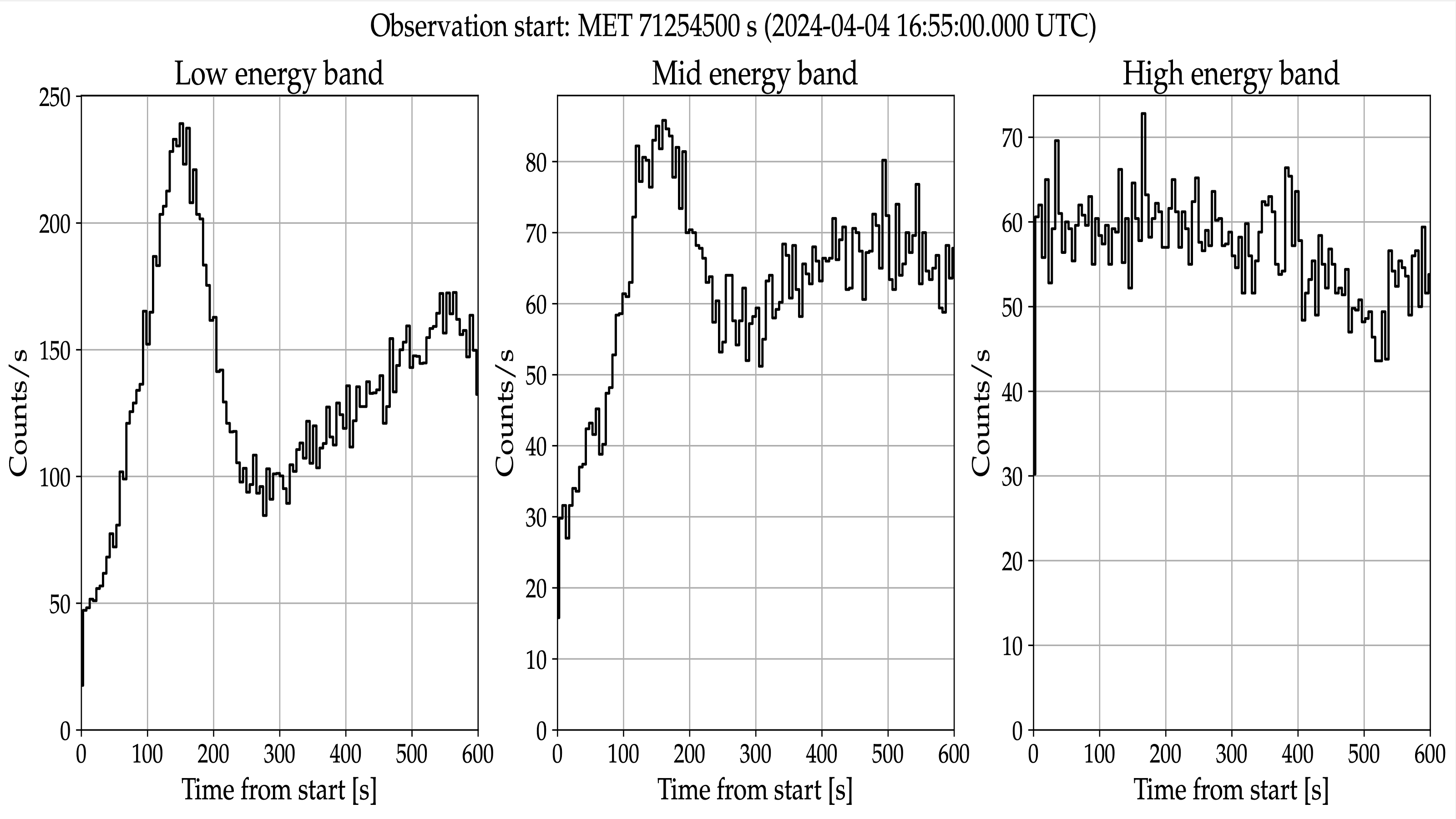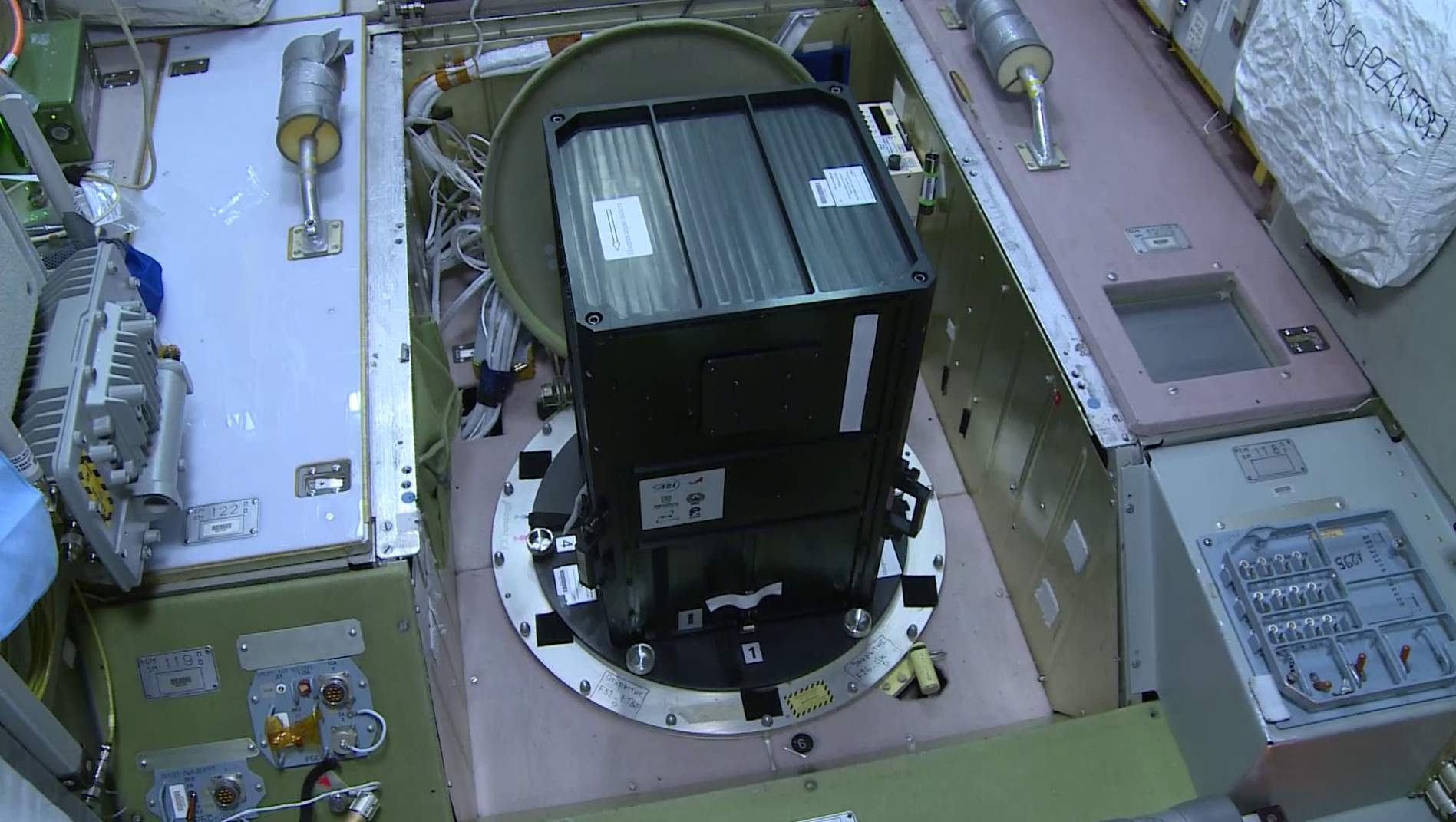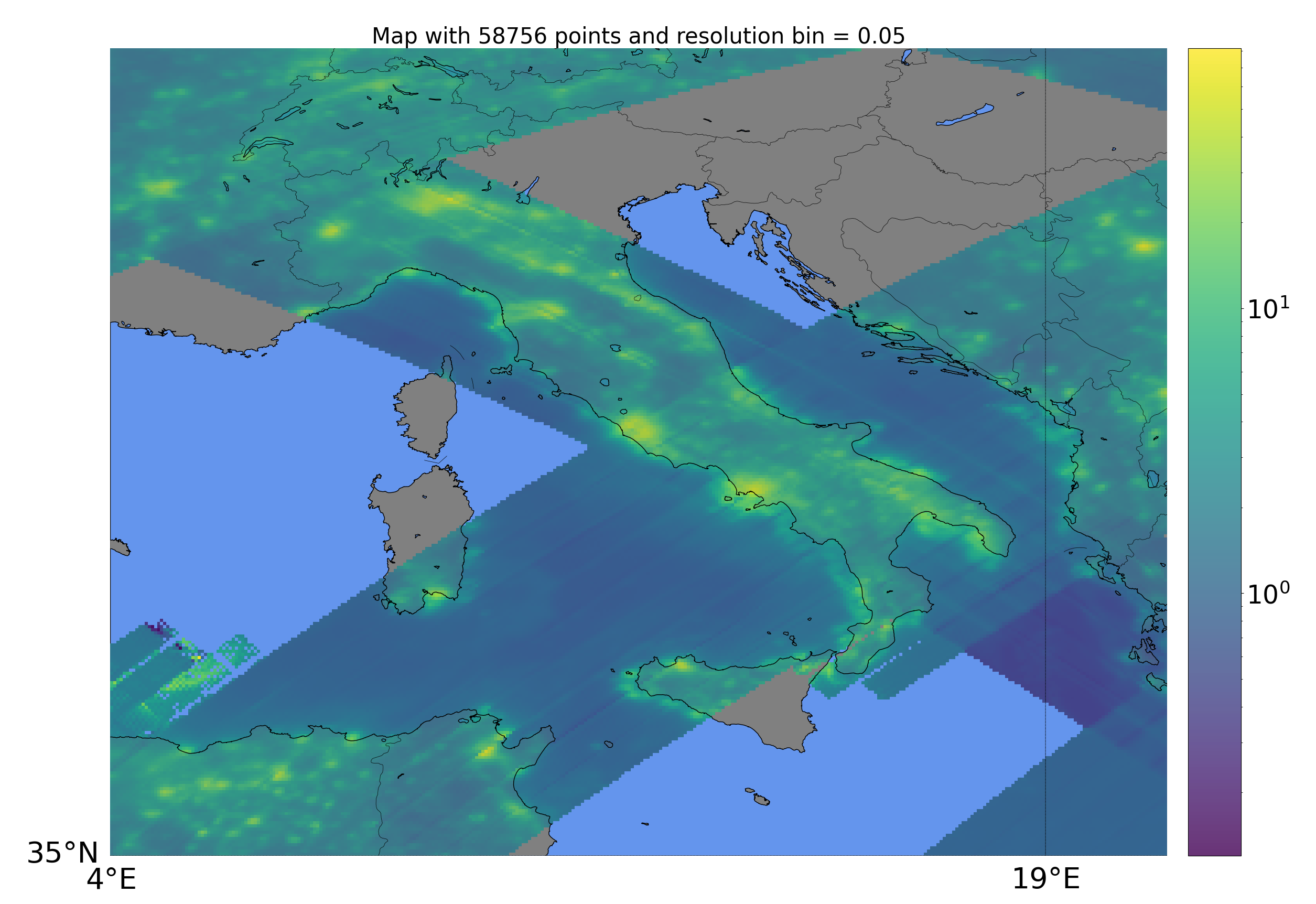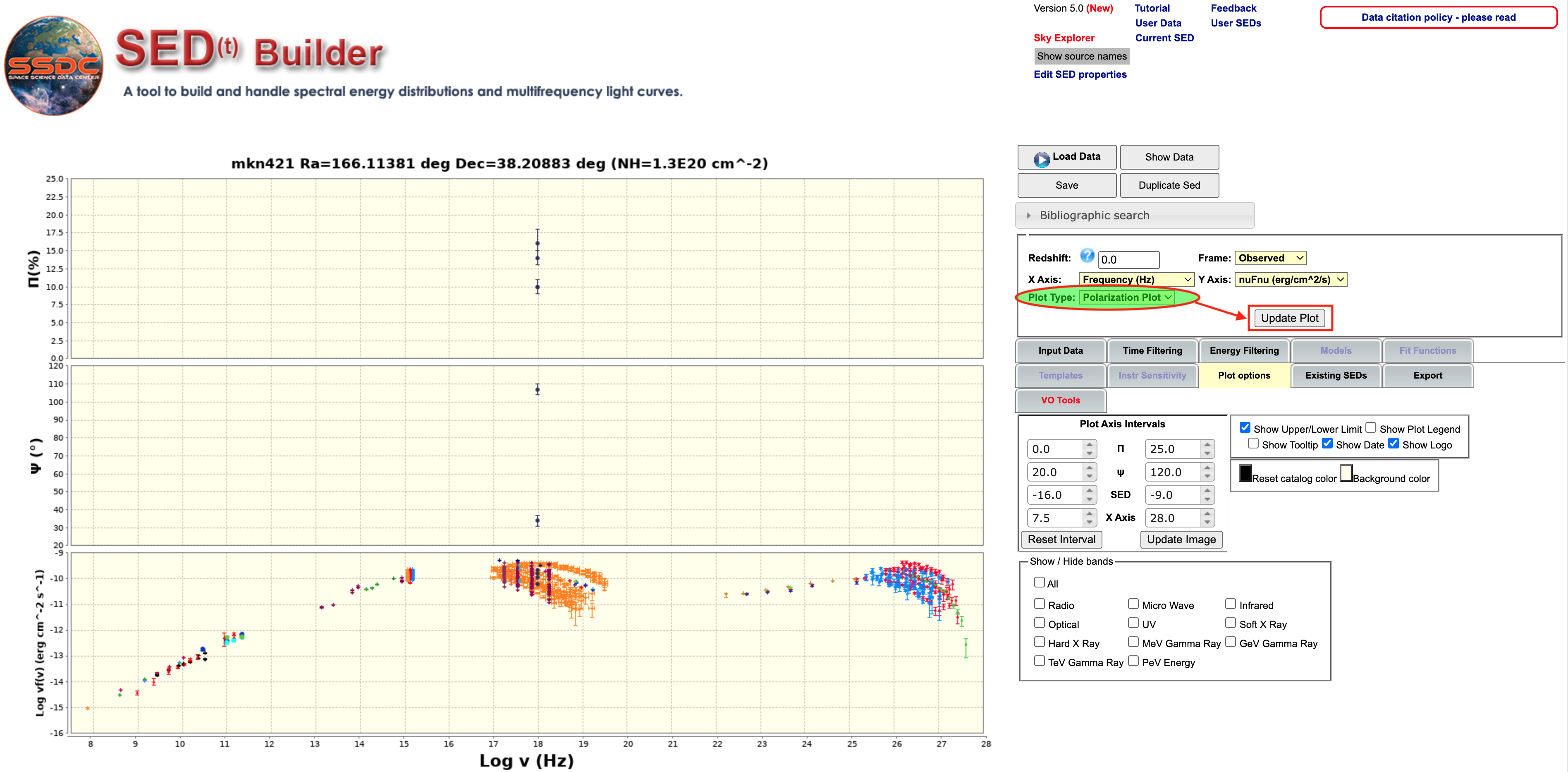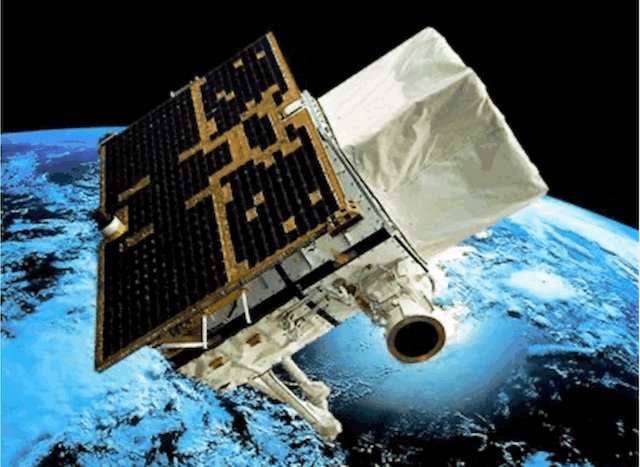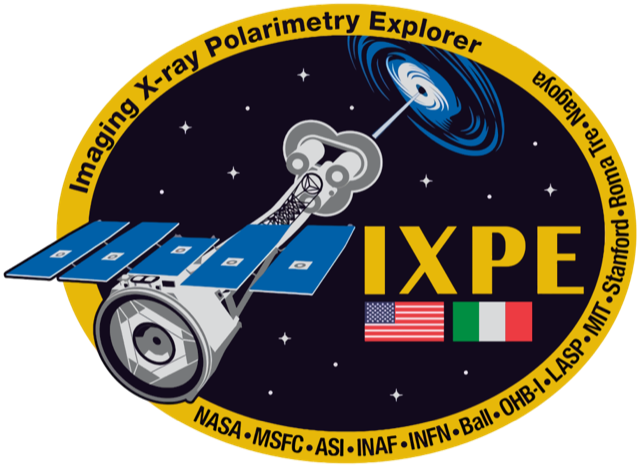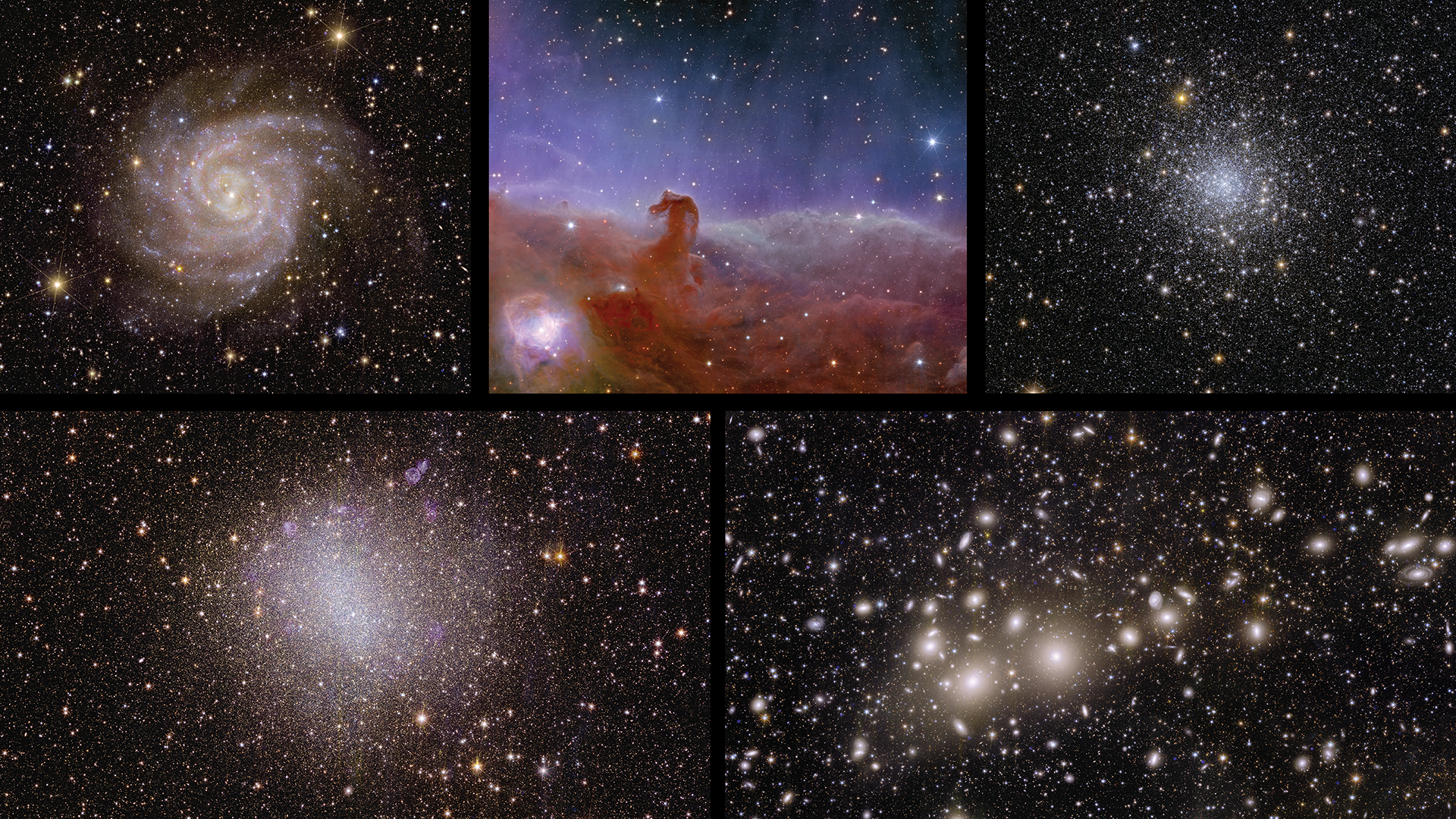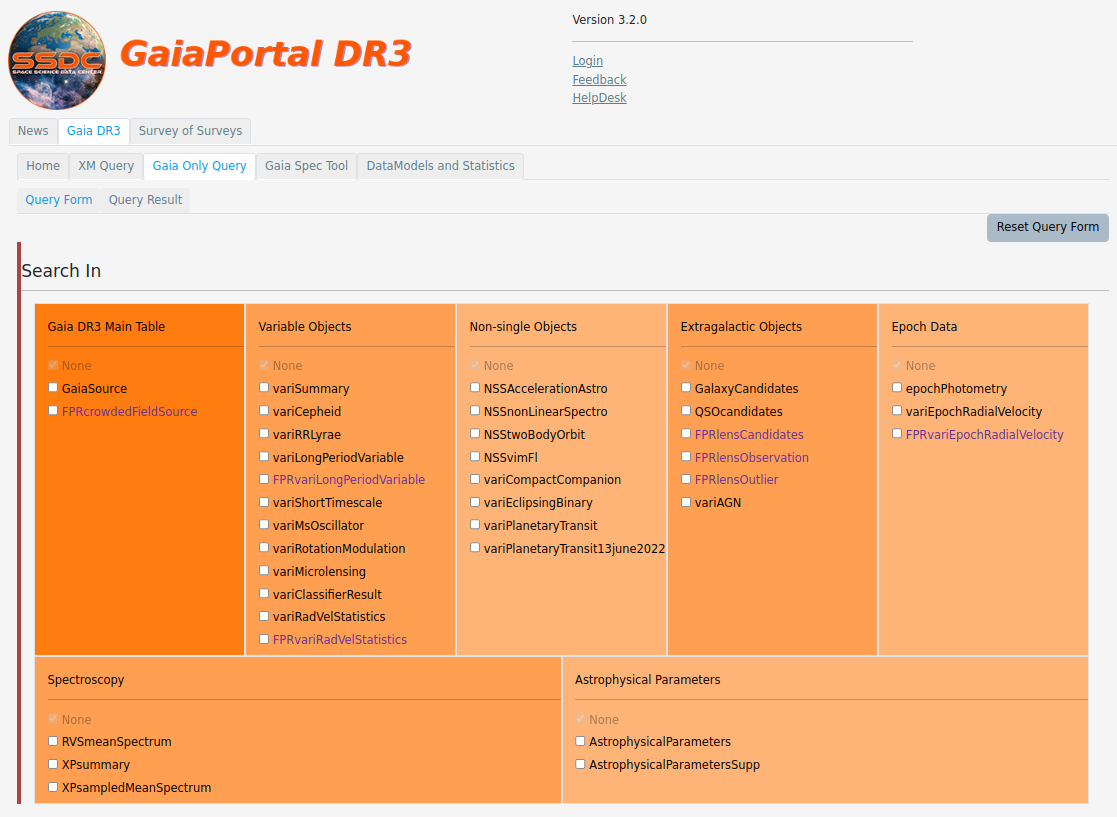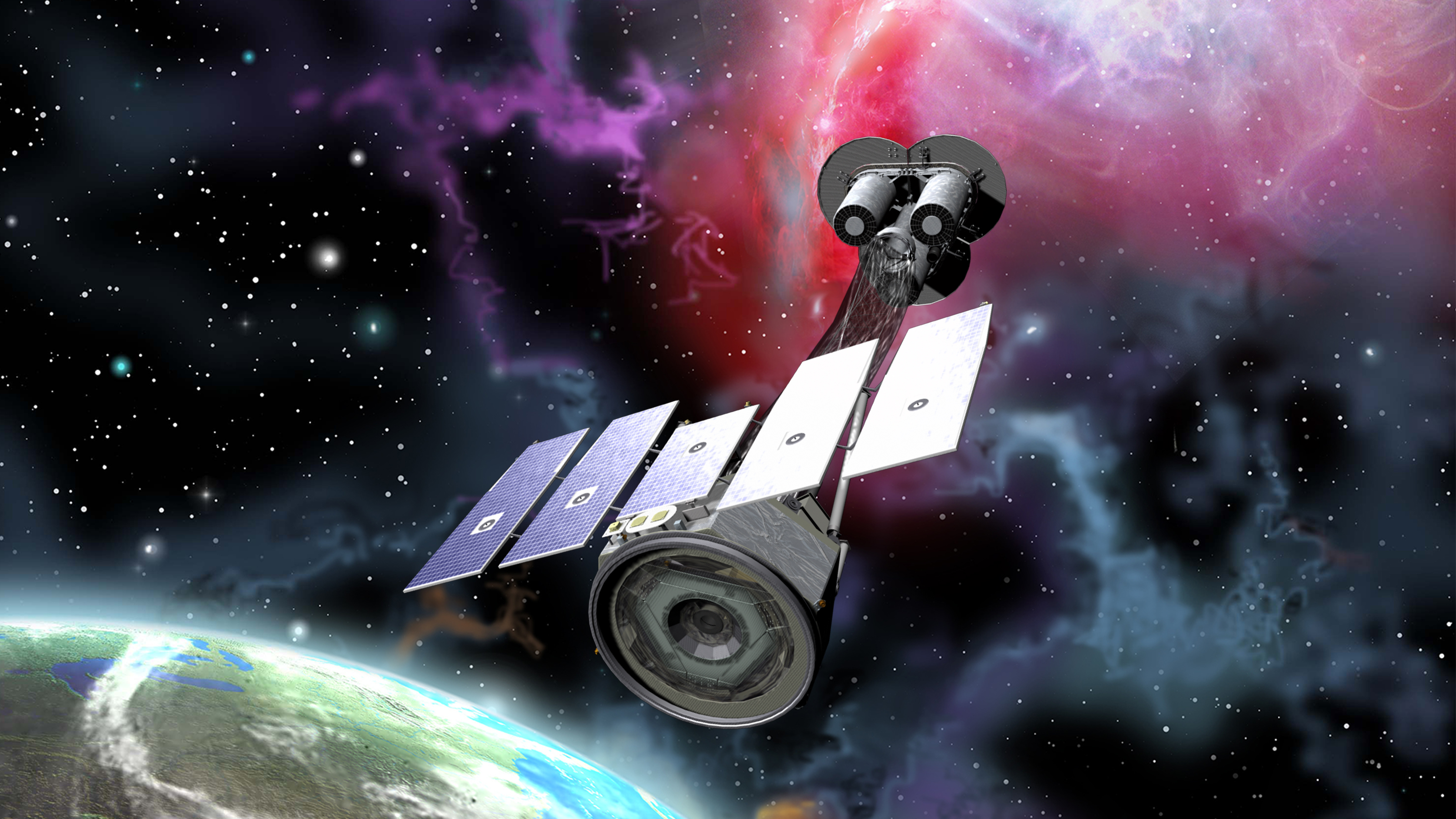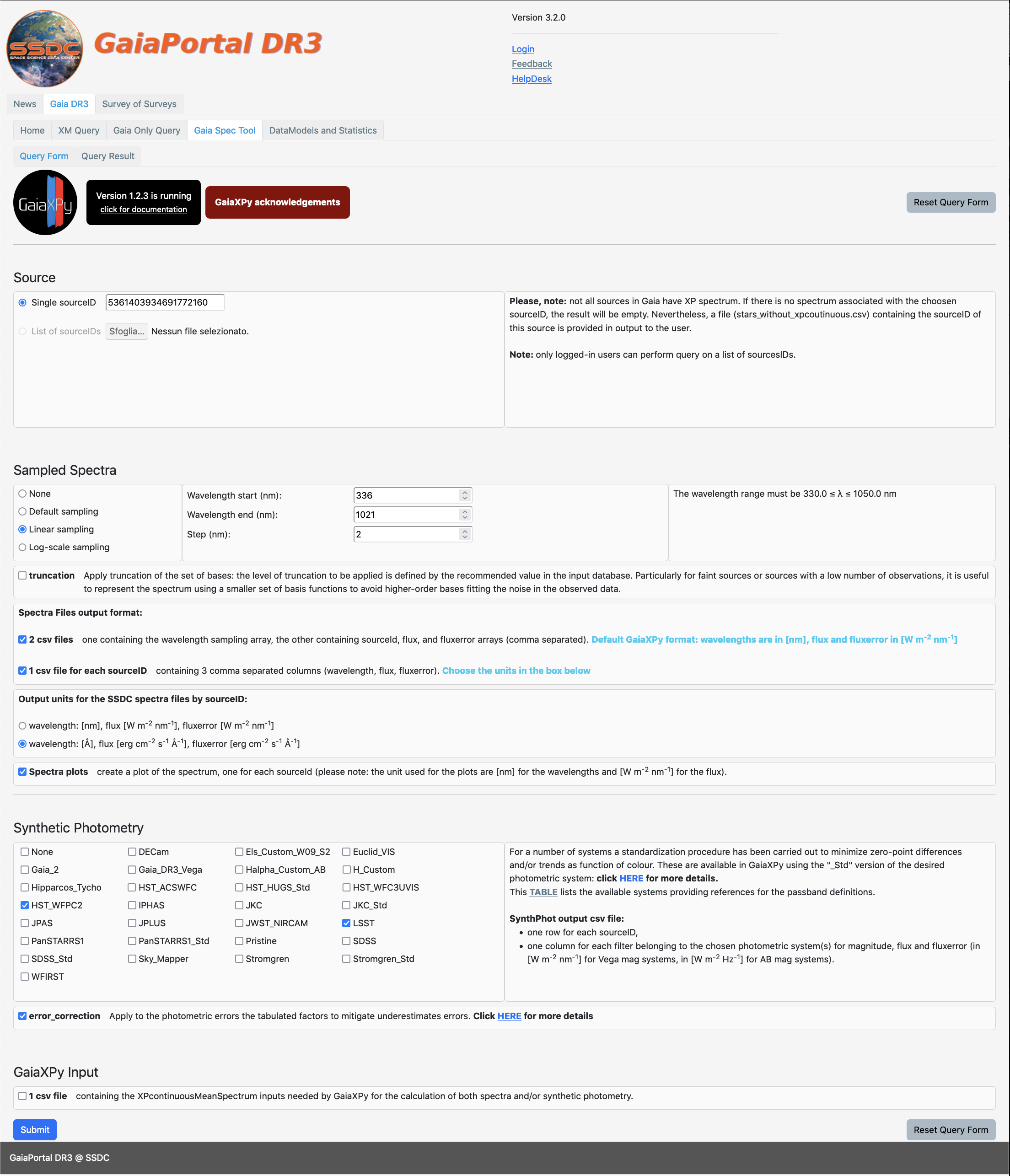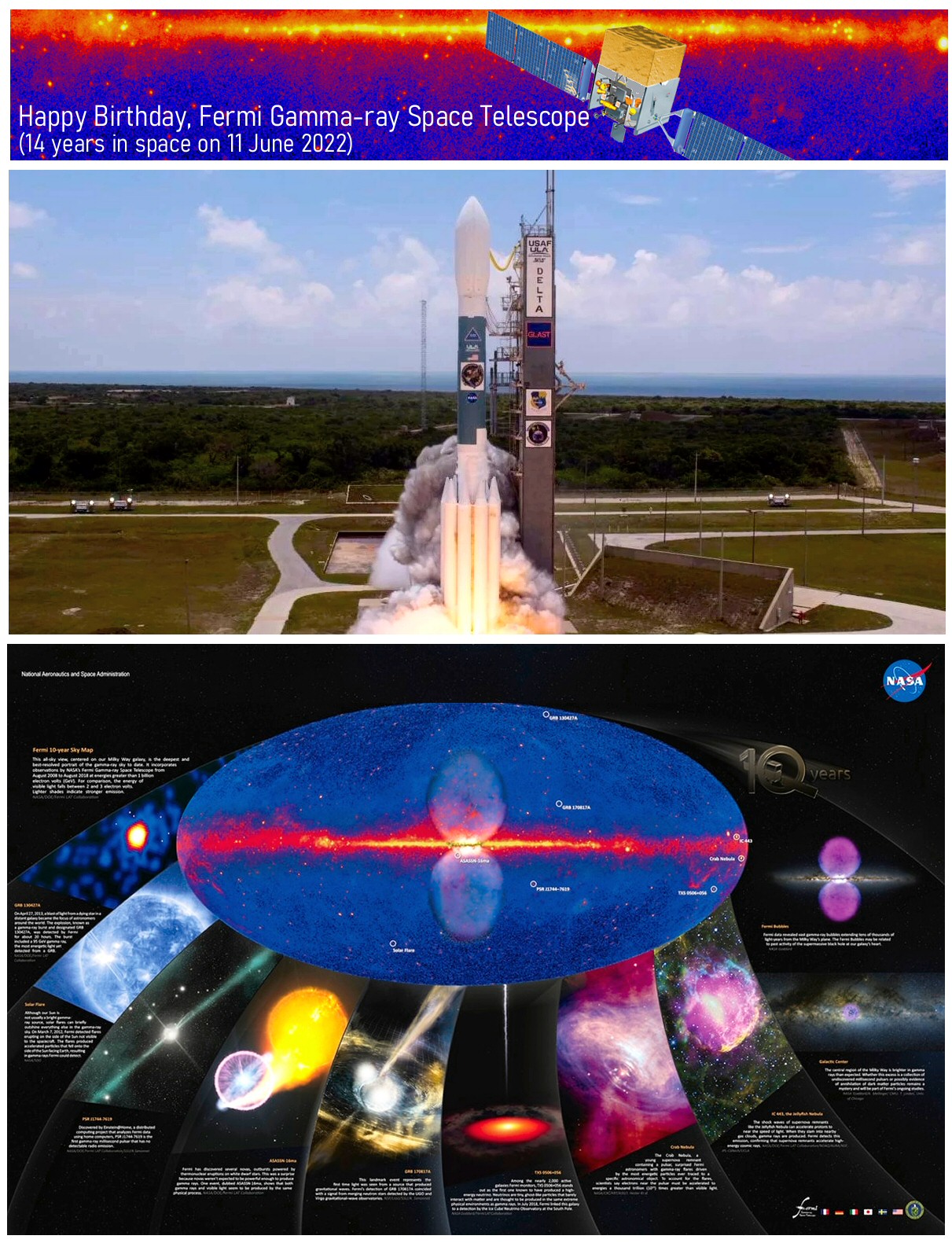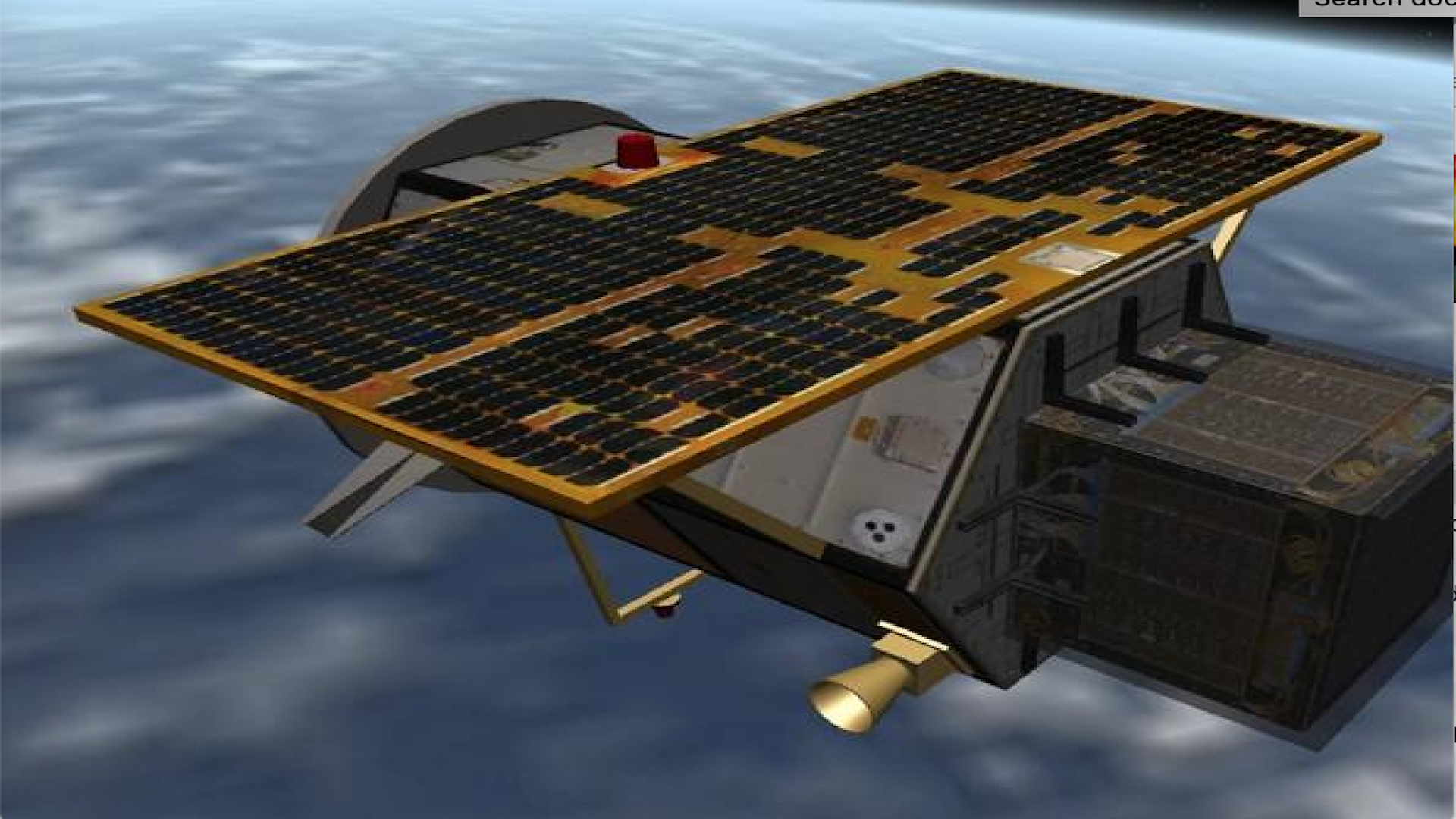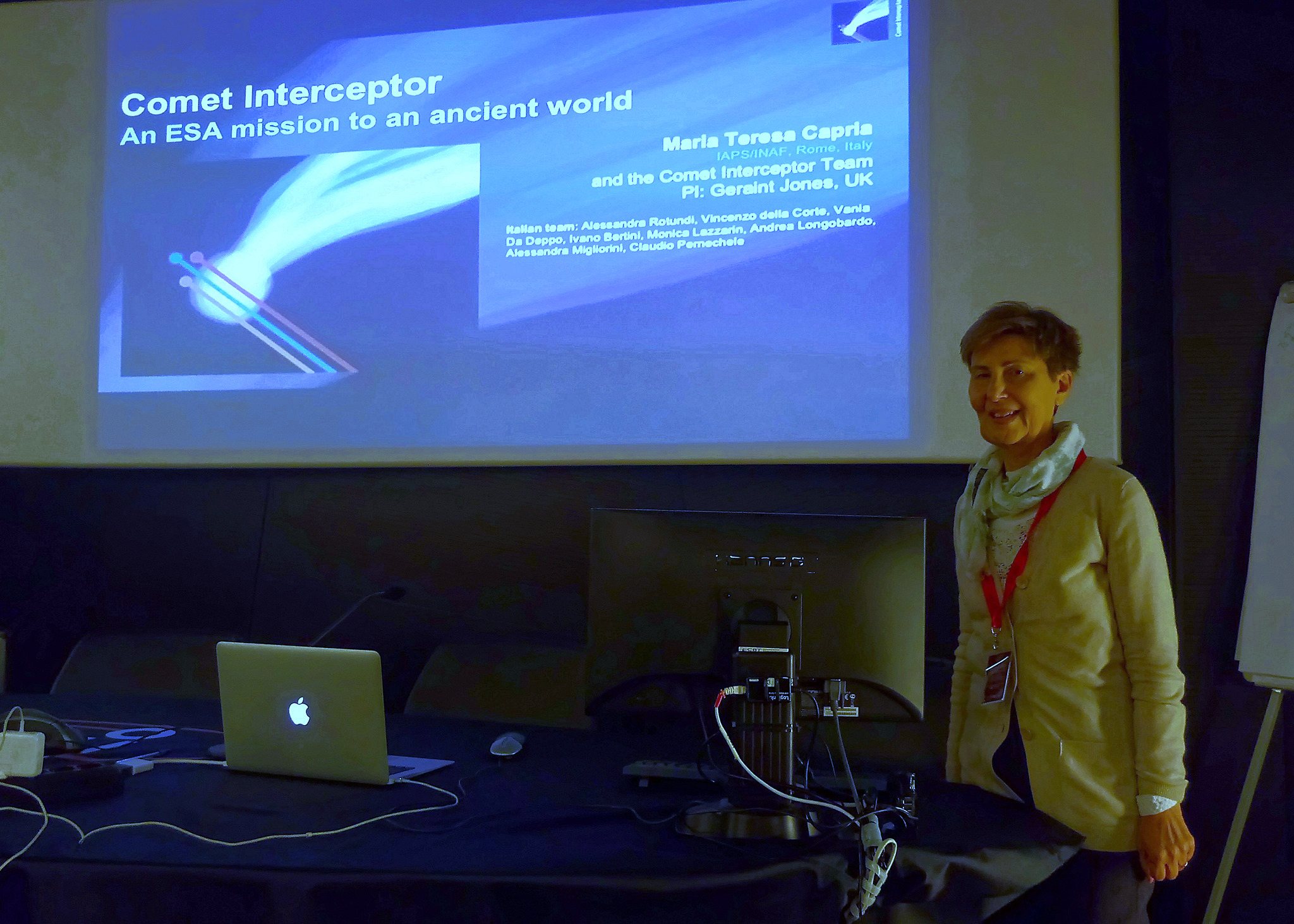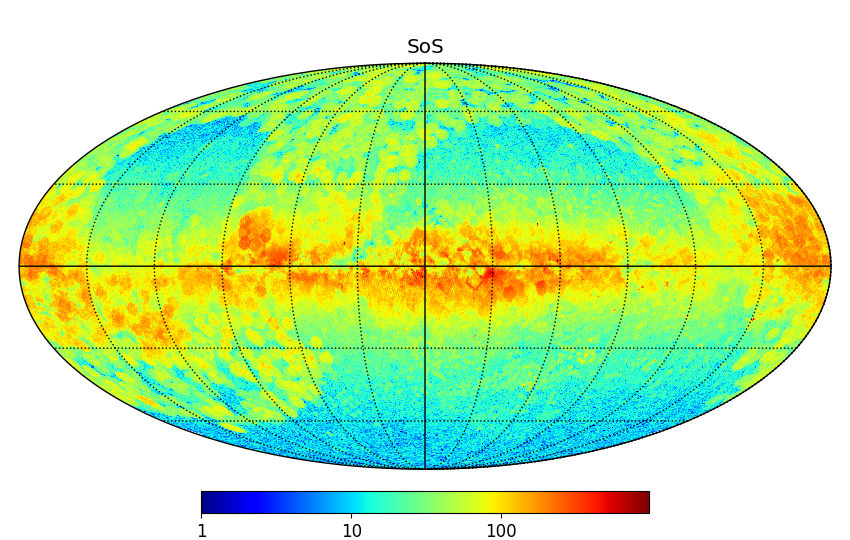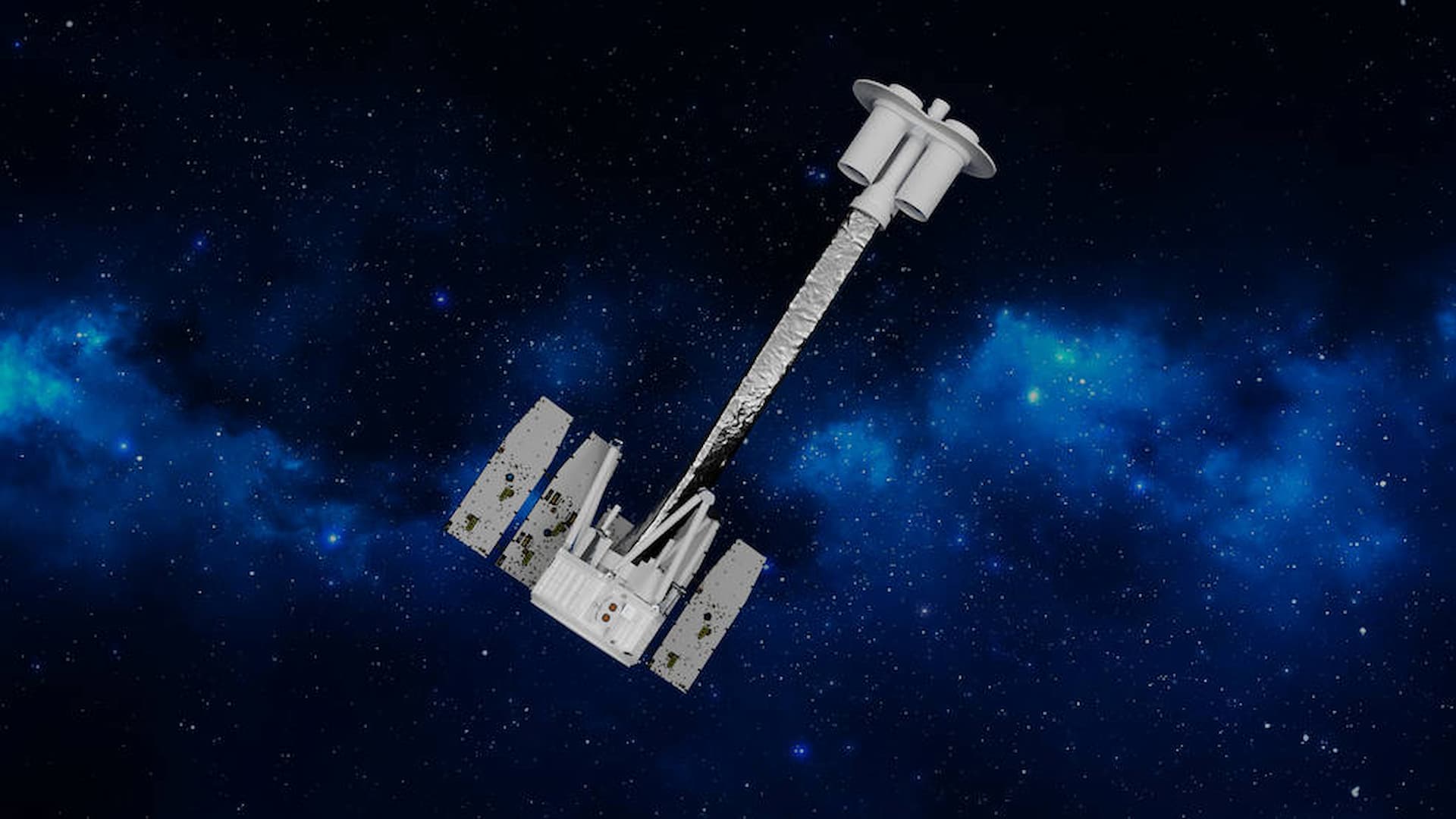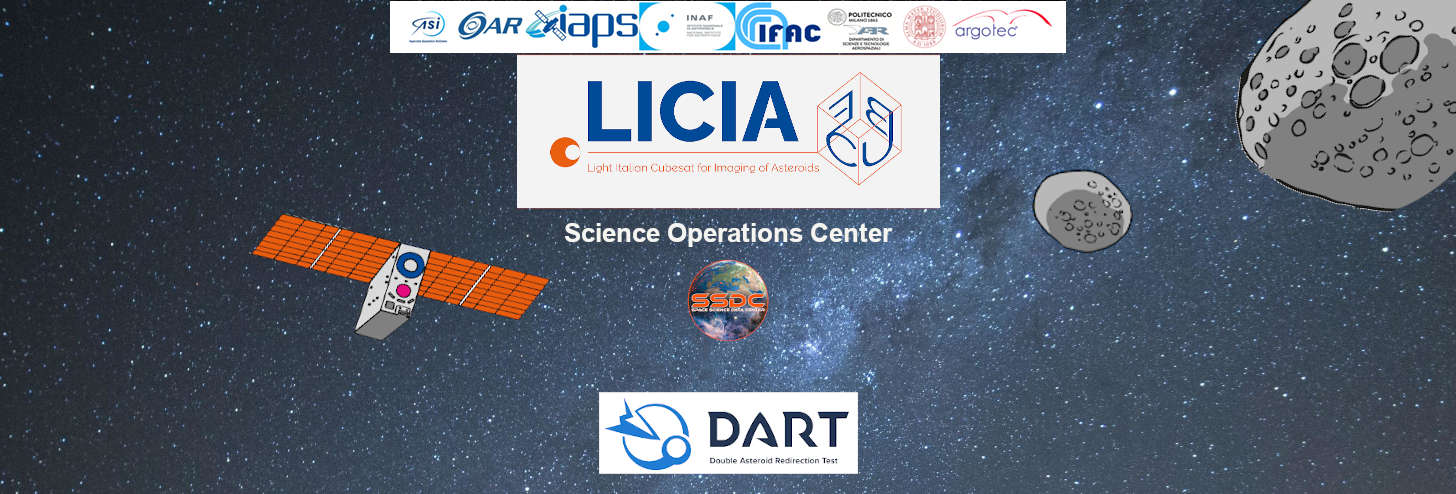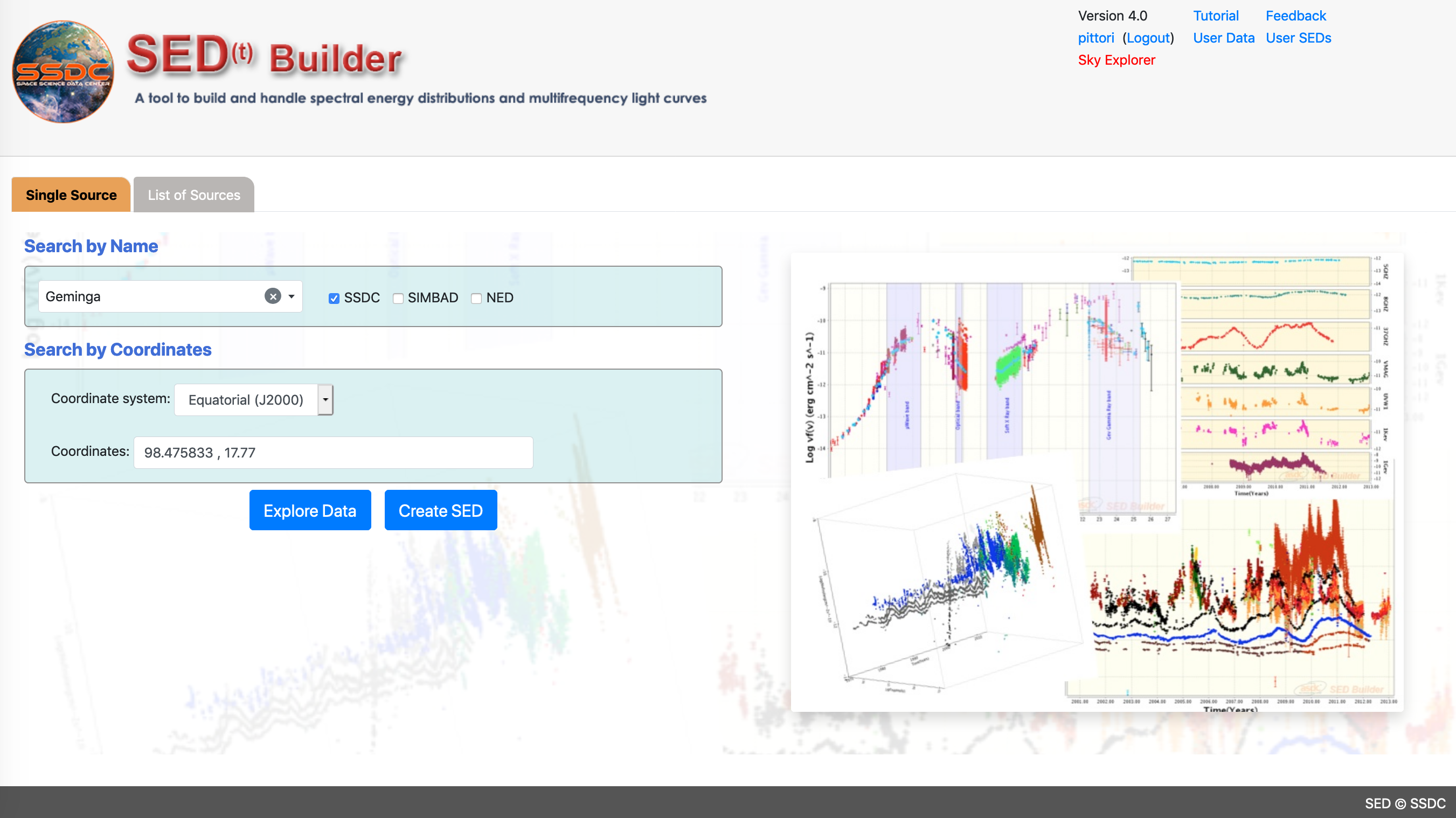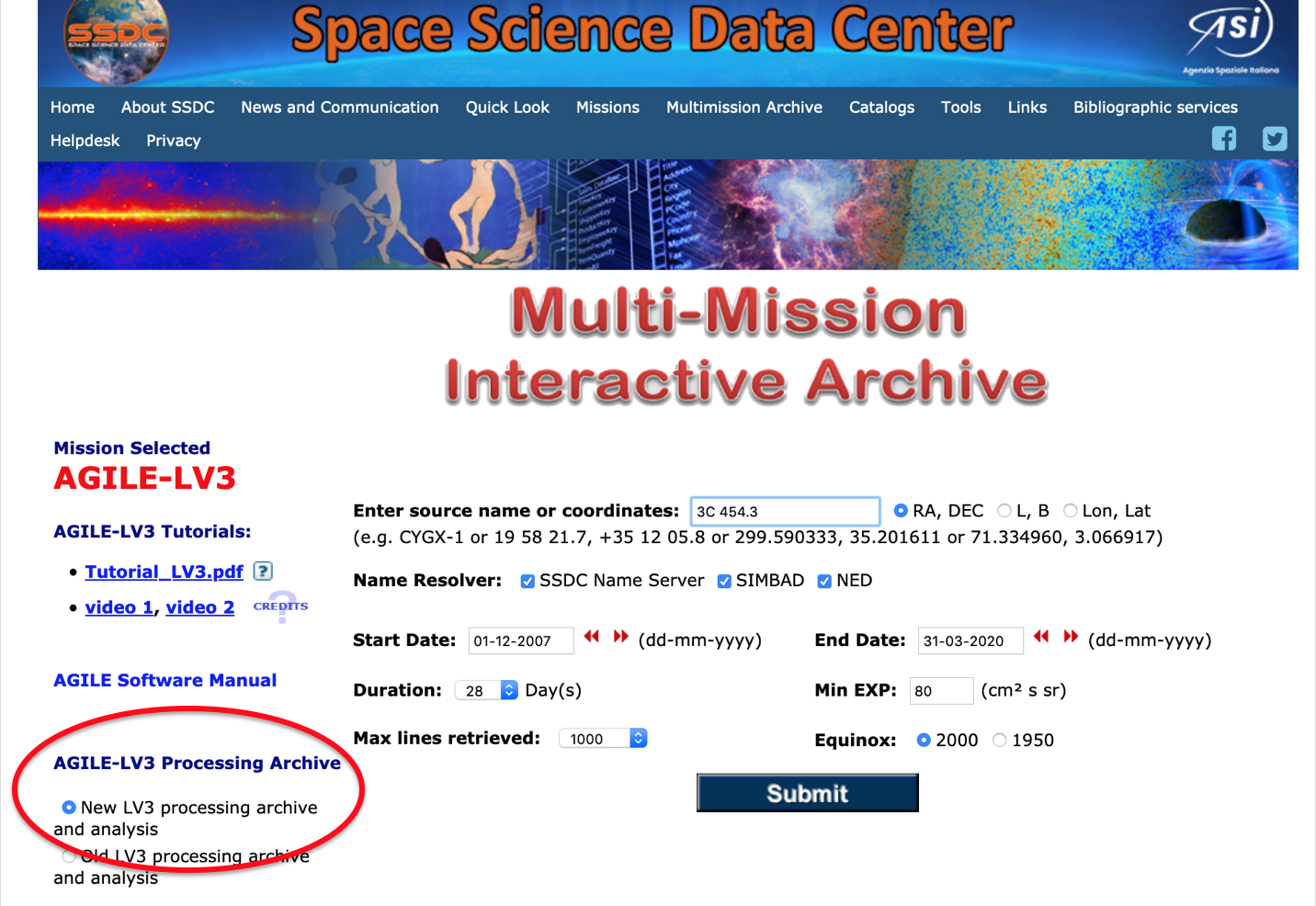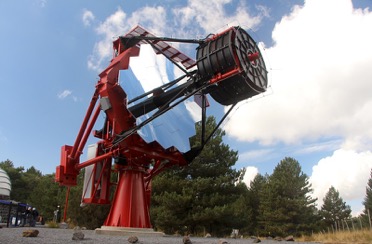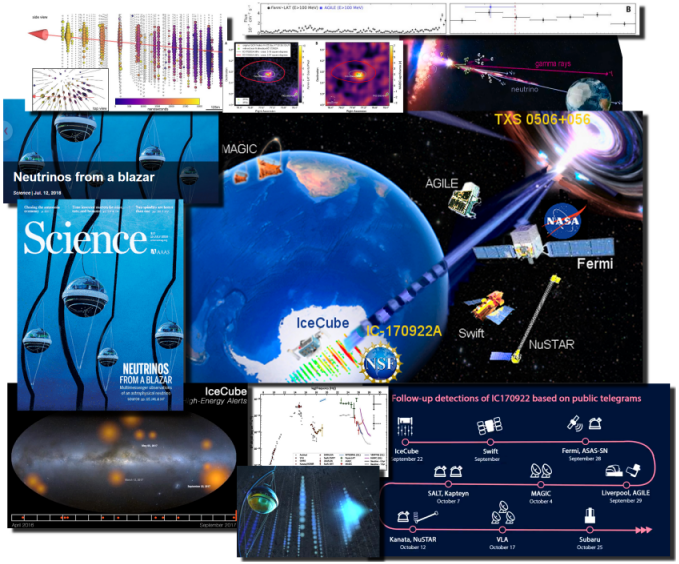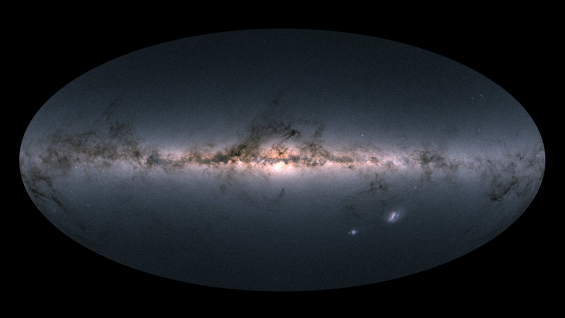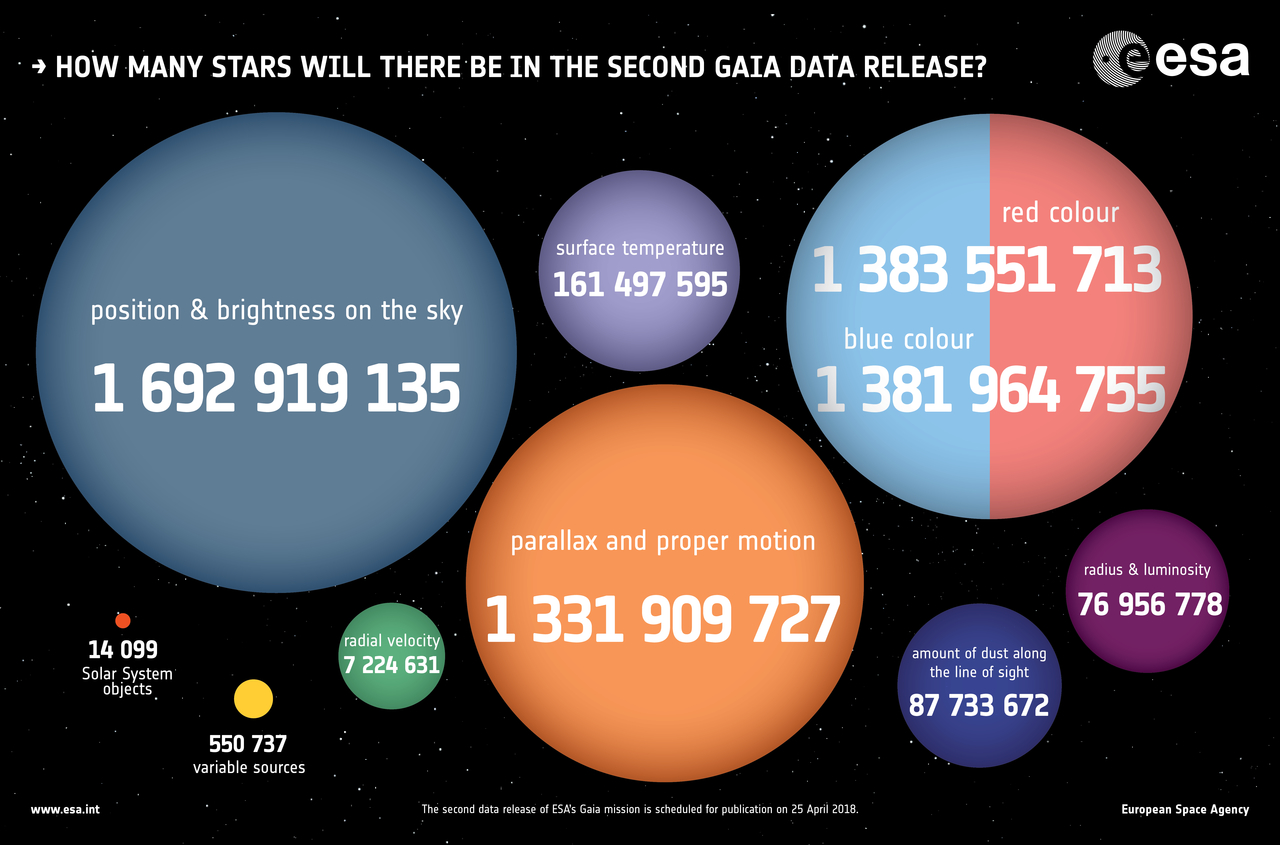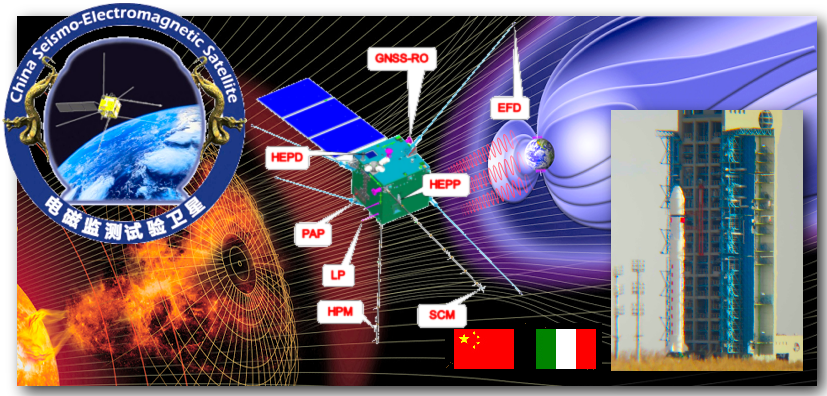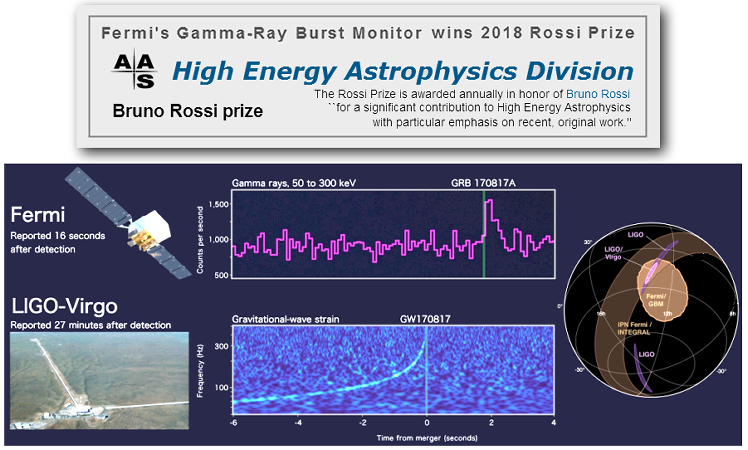
May 23, 2024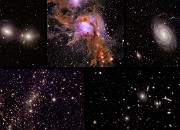 | Euclid: Five new amazing images ESA's Euclid space mission has released five new images that show different and amazing aspects of our Universe, in space and in time, from star forming regions to very distant galaxy systems. The five targets shown here are (clockwise from top left) the Dorado Group, Messier 78, NGC 6744, Abell 2764, and Abell 2390. This new set of images accompanies the first phases of Euclid's scientific main survey, which aims at answering the biggest open questions of cosmology and revealing the dark side of our Universe. The quality of these images, and in particular the level of detail that can be achieved, demonstrates that Euclid has the potential to fulfill its ambitious scientific goals. These images complement the publication of a series of technical papers, which present the first scientific results and describe all the aspects of the preparation and commissioning of the instruments mounted on the Euclid space telescope.
|
Apr 23, 2024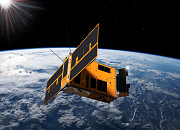 | HERMES First Light On Board SpIRIT! The University of Melbourne, the Italian Space Agency, the Australian Space Agency and the Italian National Institute of Astrophysics have announced the successful scientific operations of the HERMES instrument on board the SpIRIT satellite. The HERMES payload successfully collected light particles known as photons during a brief observation lasting about 10 minutes – a significant milestone astronomers call “first light”. HERMES scientific data are received, processed and archived at the ASI Space Science Data Center (SSDC). SSDC also developed the scientific software for data calibration and cleaning and hosts the Science Operation Center (SOC) of HERMES. ASI Press release: https://www.asi.it/2024/04/la-prima-luce-di-hermes-a-bordo-di-spirit INAF Press release: https://www.media.inaf.it/2024/04/23/prima-luce-hermes
|
Apr 22, 2024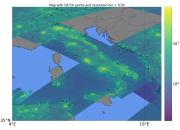 | First release of Mini-EUSO Earth emission data in the Ultra Violet range We are pleased to announce the first release of Mini-EUSO UV Earth emission data. Mini-EUSO is a wide field of view UV camera operating from the International Space Station since 2019. Goal of this experiment is the understanding of the experimental conditions in view of future ultra-high-energy cosmic ray observatories from space. Mini-EUSO acquires data at night-time between -51 and +51 degrees of latitude with a time resolution of 2.5µs and with single-photon counting capability. We present here the integrated emission measured over 1.5 years (from Nov. 2019 to May 2021), in terms of average photon counts per frame [Remote sensing of environment, 284 (2023) 113336]. Three data sets are presented: World, Europe and North Africa and North America, each of them containing data from a specific geographical area and with a specific spatial resolution. Data can be downloaded in different formats: .txt, .png and .kmz, the latter being compatible with the implementation in tools like Google Maps®. An interactive tool is available to select subsamples of such data. Users can select intervals in latitude, longitude, maximum and minimum count rates and visualize, directly on the web interface, the resulting image. For each selected sample the corresponding data sets can be downloaded in the above-mentioned format. We encourage the community to use this tool for scientific and educational purposes. Feedbacks are highly appreciated. |
Apr 15, 2024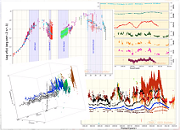 | SSDC SED Builder opens up to polarimetric information We are pleased to announce an improved version (v5.0) of the SED Builder, the SSDC web tool designed to build and handle the Spectral Energy Distribution (SED) of astrophysical sources. In addition to the large amount of available features and plotting options to analyze SED's properties, the tool is now able to display the polarimetric information, that is both angle and degree of the polarization of the radiation as a function of the photon energy. This is carried out selecting the new "Polarization plot" option, with two additional graphs for angle and degree of polarization appearing over the main graph with the SED, all of these sharing the X axis that corresponds to the energy of the radiation. The possibility of building a polarization plot is currently exploited in the X-ray energy band, using published data from the IXPE mission that have been accurately collected at SSDC for this purpose, and is planned to be expanded to other bands of the electromagnetic spectrum, for which catalogs with polarimetric information is available. The SSDC SED Builder provides open access to data from catalogs and from specific publications. If you use any of these data sets in a publication, please make sure to give proper credit to the papers and/or the external services from which data have been taken. Detailed credit information can be retrieved by clicking the “Data citation policy” button present on the SED Builder webpage. If your research benefits from the use of SSDC services, we would appreciate the following acknowledgement: "Part of this work is based on online services provided by the ASI-SSDC."
|
Feb 14, 2024 | The AGILE satellite re-entered the atmosphere After 17 years of thriving operations, the AGILE Italian scientific satellite re-entered the atmosphere, thus ending its intense activity as a hunter of some of the most energetic cosmic sources in the Universe that emit gamma and X-rays. AGILE, built by ASI with contributions from INAF and INFN, Italian universities and industry, has been a unique and hugely successful space program in the landscape of Italian space activities. Observations acquired by the satellite were received on the ground by ASI's Luigi Broglio Space Center station in Malindi, Kenya. The data were then sent to the Telespazio Control Center through the ASINet operational network, and then to the ASI Space Science Data Center in Rome, which is responsible for all scientific operations: from management, analysis and archiving to distribution of the data and related catalogs accessible to the international community. AGILE's scientific output consists of more than 800 bibliographic references, including more than 160 refereed articles and 12 mission catalogs published through January 2024 (also available as interactive SSDC webpages here). AGILE's major scientific discoveries include: the first detection of galactic cosmic ray sources in Supernovae remnants, evidence of extremely rapid particle acceleration from the Crab Nebula with a rapidly rotating pulsar at its center (Bruno Rossi Prize 2012), and the detection of transient gamma-ray emission associated with relativistic jet emission from the galactic black hole binary system Cygnus X-3. During its operational life, AGILE has also revealed many transient events of cosmic origin such as Gamma Ray Bursts (GRBs), searched for high-energy emission associated to neutrino events and Fast Radio Bursts (FRBs), detected thousands of solar flares, as well as events of terrestrial origin such as Terrestrial Gamma-ray Flashes (TGFs). AGILE has contributed with a leading role in the search for possible counterparts of gravitational wave (GW) sources, and AGILE's follow-up observations have provided the fastest response and most significant upper limits above 100 MeV on all GW events detected by the Ligo-Virgo-Kagra collaboration to date. With the AGILE's re-entry, the in-orbit operational phase comes to a close, but a new phase of scientific work on the satellite legacy data archive opens: AGILE may still hold future surprises. Additional links: COMUNICATO STAMPA CONGIUNTO ASI-INAF-INFN (in italian): ASI news, INAF news
|
Jan 11, 2024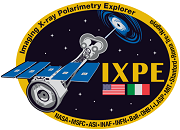 | IXPE receives the 2024 Bruno Rossi Prize We are pleased to report that the 2024 Bruno Rossi Prize of the High Energy Astrophysics Division (HEAD) of the American Astronomical Society has been awarded to Martin Weisskopf, Paolo Soffitta and the IXPE team "for their development of the Imaging X-ray Polarimetry Explorer whose novel measurements advance our understanding of particle acceleration and emission from astrophysical shocks, black holes and neutron stars". IXPE (Imaging X-ray Polarimetry Explorer) is a joint NASA-ASI mission that was launched in December 2021 under NASA's Small Explorer (SMEX) program. The mission exploits the polarization state of light from astrophysical sources in the X-ray energy band with a polarization sensitivity improvement of two orders of magnitude over the previous polarimeters obtained with X-ray polarization detectors provided by ASI. Italy collaborates on the primary scientific mission goals with a team of scientists of ASI, INAF, INFN and Roma Tre University. The Italian participation includes also the provision by ASI of the “Luigi Broglio” ground station (Malindi, Kenya) and of the Space Science Data Center (SSDC). The SSDC has provided the Calibration Database (CALDB) and has designed and developed, in collaboration with INAF and INFN, the scientific software modules that are part of the Instrument Pipeline. The software is written in FTOOLS style and is fully integrated in the HEASoft package maintained and distributed by NASA/HEASARC. The Instrument Pipeline IXPE FTOOLS are run at the Science Operation Center (NASA/Marshall Space Flight Center) to generate the official IXPE scientific data archive. This is the 6th time that a space mission for which the SSDC plays an important role has been awarded a Rossi Prize, after BeppoSAX in 1998, Swift in 2007, Fermi in 2011, AGILE in 2012 and NuSTAR in 2015. Link (in Italian): ASI news
|
Nov 07, 2023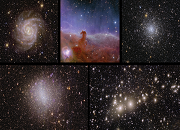 | Euclid's first images Today, the ESA’s Euclid space mission has revealed its first full-colour images obtained combining observations from the visible and near infrared instruments. These five images illustrate Euclid's full potential, from bright stars to faint galaxies. Its observations will cover one third of the sky remaining extremely detailed, even when zooming in on distant galaxies. Here at SSDC, we have been working on the development of the software used to process the images observed in the near infrared. For more details see ESA web page and ESA YouTube channel.
|
Oct 10, 2023 | Gaia Focused Product released on 10 October 2023! Waiting for Gaia DR4 release, expected not before the end of 2025, and just a few months from Gaia 10th launch anniversary (19 December 2023), the Gaia Data Processing and Analysis Consortium is releasing a juicy subset of new data focused on specific subjects. In particular, this release consists of 5 data products:
Diffuse Interstellar Bands data and Lens Catalogue Names can be downloaded as a single file through the "Gaia DR3 --> DataModel and Statistics" tab. Since Solar System Objects data are not included in our GaiaPortal, updated astrometry for Solar System objects can be accessed through the Gaia ESA Archive. Further information: For further information about Gaia FPR please refer to this page. Gaia FPR related papers are available here.
|
Jun 06, 2023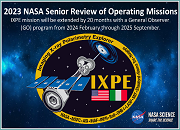 | NASA-ASI IXPE space mission extended for 20 months The NASA Program Scientist and NASA Astrophysics Director have signed the extension memo and funding for the Imaging X-ray Polarimetry Explorer (IXPE) satellite mission, a NASA+ASI, US and Italian, bilateral Small Explorer (SMEX) mission. The IXPE space mission will be extended by 20 months by NASA, with a General Observer program from 2024 February through 2025 September. IXPE will be evaluated at the next NASA Senior Review of Operating Missions, for extension beyond that date. NASA will release the Announcement of Opportunity (AO) for the IXPE Guest Observer (GO) program in the next weeks. This goal has been obtained thanks to the IXPE international collaboration that has made, the IXPE mission, a successful satellite, both technically and scientifically. IXPE has explored, up to now, the polarization state of the X-ray photons (2-8 keV energy band) emitted by several classes of compact astronomical objects with extreme gravitational, electric and magnetic fields. Italy is collaborating on the scientific mission goals with a team of scientists of ASI, INAF, INFN and Roma Tre University. The Italian participation includes also the provision by ASI of the “Luigi Broglio” ground station (Malindi, Kenya) and of the Space Science Data Center (SSDC). The SSDC has provided the instrument Calibration Database (CALDB) and has designed and developed, in collaboration with INAF and INFN, the scientific software modules (IXPE FTOOLs) that are part of the Instrument Pipeline, while is contributing in the scientific exploitation of the incoming data (in particular in the topic of active galactic nuclei and blazars and multifrequency follow-up) and in further developments of the analysis software. The IXPE Team (INAF, INFN, ASI staff) of SSDC is composed by Matteo Perri, Simonetta Puccetti, Riccardo Middei, Marco Laurenti and Stefano Ciprini. Some links:
|
Dec 13, 2022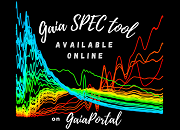 | New GaiaSpecTool available on GaiaPortal@SSDC The new GaiaSPECtool tab is now online! Easy-to-use GaiaPortal combined with powerful GaiaXPy spectra handling! This new tool is based on the official Python package GaiaXPy, developed and maintained by members of the Gaia Data Processing and Analysis Consortium (DPAC) and in particular, Coordination Unit 5 (CU5), and the Data Processing Centre located at the Institute of Astronomy, Cambridge, UK (DPCI). GaiaSPECtool can be used on a single Gaia DR3 source or, for registered users only, on a list of sources to:
GaiaSPECtool can be accessed here, through the GaiaPortal DR3 main tab.
|
Jun 13, 2022 | SSDC contribution to Gaia DR3 On June 13th the Gaia collaboration has released its Gaia Data Release 3 catalogue. Gaia DR3 data are based on data collected between 25 July 2014 and 28 May 2017, spanning a period of 34 months. As a comparison, Gaia DR2 was based on 22 months of data and Gaia DR1 was based on observations collected during the first 14 months of Gaia's routine operational phase. Gaia DR3 catalogue contains more than 1.8 billion stars with proper motion and parallax for 1.5 billion sources. Gaia DR3 catalogue also includes BP and RP spectra for 220 million stars, RVS spectra for 1 million stars and epoch photometry for more than 11 million stars. Gaia is also publishing the astrophysical parameters for more than 1.5 billion stars, radial velocity measurements for 34 million stars and variability measurements for more than 10.5 million sources. SSDC is one of the four ESA partner data centers for the publication and dissemination of Gaia data releases. SSDC has thus designed, developed, and made publicly available an access point to the Gaia and cross-matched external catalogues data: the GaiaPortal. SSDC is continuing to develop access, data extraction and multi-wavelength cross-match tools to enable the astronomical community to handle and fully exploit the scientific potential of this enormous archive. In addition, SSDC is responsible for the calculation of the official cross-match of the Gaia catalogue with the largest public available optical and near-IR catalogues ensuring an all-sky, panchromatic vision of the universe.
|
Jun 11, 2022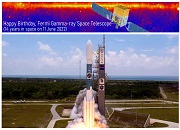 | Happy 14-year birthday, GLAST/Fermi! On June 11, 2008 (14 years ago) NASA launched the Fermi Gamma-ray Large Area Space Telescope (previously known as GLAST) into orbit. Fermi satellite's name was chosen to honor the famous Italian physicist Enrico Fermi, who first proposed the eponymous mechanism for the acceleration of cosmic rays that creates many of the high-energy gamma rays that the satellite detects. Fermi LAT is continuing to map the entire high-energy gamma-ray sky every ~three hours. Recently the Data-Release 3 of the incremental version of the fourth Fermi LAT catalog of gamma-ray sources (4FGL-DR3) based on the first twelve years of science data in the energy range from 50 MeV to 1 TeV, and containing 6658 sources, has been published. The companion fourth LAT catalog of active galactic nuclei (data release 3, 4LAC-DR3), co-driven by the SSDC Fermi team , includes 1607 new AGN sources relative to the initial 4FGL-DR1 catalog. The LAT science photon event data archive at the SSDC currently holds more than 1 billion and 530 millions gamma-ray photons ready for science analysis. Finally the 10th International Fermi Symposium will be held in Johannesburg, South Africa, from October 9-15, 2022. Fermi LAT and GMB detectors and instruments were built and are operated by an international collaboration between astrophysicists and particle physicists from the United States, France, Germany, Italy, Japan and Sweden.
|
Apr 22, 2022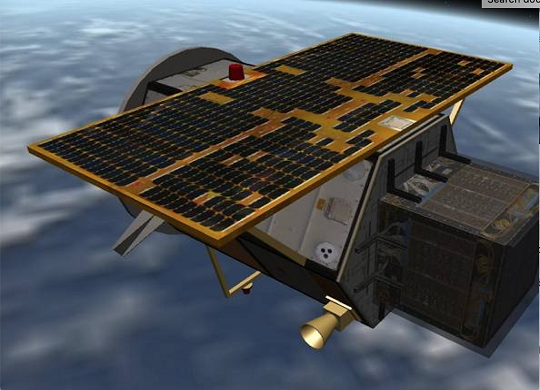 | The ASI scientific satellite AGILE turns 15 years in orbit 15 years after its launch on 23 April 2007, the AGILE satellite of ASI, built and operated in cooperation with INAF and INFN, is still fully operational and continues its monitoring of the high-energy sky. AGILE is providing a unique contribution to the search for the gamma-ray counterparts of gravitational waves, neutrinos, fast radio bursts and other transients. In these fifteen years, the satellite has completed more than 77,600 orbits around the Earth equator. AGILE observations are regularly transmitted to the ground through the ASI tracking station in Malindi (Kenya), sent to the Telespazio control center in Fucino via ASINET, and from there to the ASI Space Science Data Center (SSDC) in Rome, which oversees all the scientific activities related to the analysis, archiving and distribution of AGILE data. AGILE made several important scientific discoveries, including: a novel mechanism of particle acceleration operating in the Crab Nebula (Bruno Rossi Prize 2012); the emission of transient gamma-rays correlated with relativistic jet ejections from Galactic compact sources; the first evidence of hadronic cosmic ray production from a SNR; the emission of very powerful gamma-ray flares from accreting super-massive black holes in AGNs. Also, terrestrial applications are relevant for the science program: AGILE discovered gamma-ray emission above 20 MeV from Terrestrial gamma-ray flashes (TGFs) produced by powerful lightning and thunderstorms. Recently, AGILE observations in April 2020 provided crucial information relevant to our understanding of the physical mechanisms behind the mysterious fast radio bursts (FRBs) and their connection to magnetar events. Finally, thanks to a new dedicated pipeline detecting variations of the count rate from the Anticoincidence panel oriented toward the Sun, AGILE may play a role also in solar related science, providing a fast alert to the space weather community about hard-X ray flares (80-200 keV) observed from the Sun. - Links (in Italian): ASI News; Media INAF News
|
Apr 19, 2022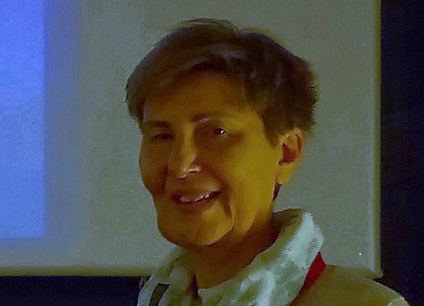 | SSDC in memory of Maria Teresa Capria On Friday, April 15th Maria Teresa Capria, INAF-IAPS Senior Researcher and SSDC Senior Scientist, passed away, after a long period of illness. She has been a renowned expert of thermophysical modeling of planetary bodies also dedicating huge efforts in the definition and application of best practices for data maintenance and curation for planetary exploration missions. Thanks to her role as SSDC Senior Scientist she was one of the founders of the present day organization of the Center for what regards Solar System Exploration, pushing for the development of a tool able to provide users data fusion capabilities and FAIR principles compliance. That tool is now MATISSE and its complete development and diffusion inside the scientific community of interest is also due to its exploitation for VIRTIS-Rosetta and VIR-Dawn datasets, hardly possible without the Maria Teresa will. It is worthy remembering her vision as the major contribution in creating a robust Solar System Exploration research able to develope and maintain her brilliant idea of a multi-disciplinary, open data driven, Planetary Exploration branch in SSDC.
|
Feb 01, 2022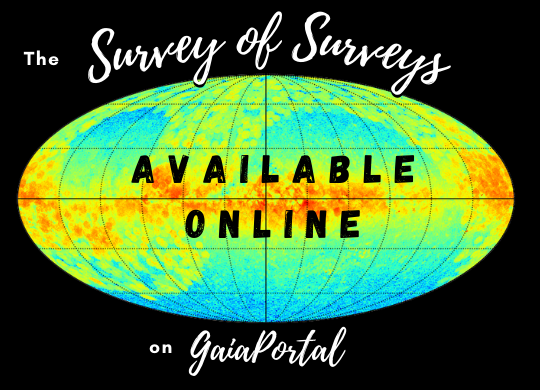 | The SURVEY of SURVEYS available on GaiaPortal@SSDC A new astronomical database containing the recalibrated measurements from all main large spectroscopic surveys has just been released to the international scientific community and is available online on GaiaPortal. The Survey of Surveys represents the synthesis of spectroscopic measurements available in the large spectroscopic surveys for the Milky Way stars. The project is led by Italian scientists, with SSDC-ASI leading the cross-match phase, the database management and the data access, and INAF-Florence leading the scientific analysis of data (for further information see here). Astronomical surveys generally include several types of stars and are built collecting data with different instruments and telescopes located on both Earth hemispheres. In addition, the measurements obtained are analysed using different methods, and finally presented in several catalogues having their own format and content. Until now, there was no single and uniform reference catalogue for spectroscopic measurements. The SoS data release 1, the largest catalogue of radial velocity to date containing data for more than eleven million stars, was created through the cross-match and recalibration of all large surveys (GaiaDR2, APOGEE, RAVE, GALAH, GES, LAMOST) on a single reference scale. The first stellar parameter published in the SoS is the radial velocity, with an accuracy of about 300 m/s and a precision of about 0.5-2 km/s (a very good quality for such a large and composite catalogue). The future releases of the SoS catalogue will include further stellar parameters and detailed chemical information.
|
Dic 09, 2021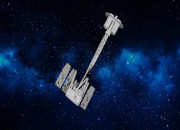 | IXPE successfully launched: the SSDC contribution On December 9, 2021 at 6:00 GMT the IXPE mission was successfully launched aboard a Falcon 9 rocket from the NASA’s Kennedy Space Center in Florida (USA). The Imaging X-ray Polarimetry Explorer (IXPE) is a joint NASA-ASI mission that will exploit the polarization state of light from astrophysical sources in the X-ray energy band. IXPE, thanks to a polarization sensitivity improvement of two orders of magnitude over the previous X-ray polarimeters, will provide insight into our understanding of X-ray production in neutron stars, pulsar wind nebulae, stellar and supermassive black holes. The satellite carries on-board three coaligned telescopes focusing the X-rays on detectors based on the innovative technology of Gas Pixel Detectors (GPD) that have been conceived and developed in Italy by INFN and INAF with funding from the Italian Space Agency (ASI). A full description of the mission can be found at the following links: https://ixpe.msfc.nasa.gov https://www.asi.it/en/planets-stars-universe/alte-energie/ixpe/ The primary science objectives include the determination of the geometry and of the emission mechanism of Active Galactic Nuclei and microquasars, the study of the magnetic field in magnetars, the analysis of X-ray production in pulsars and of their geometry and the investigation of how particles are accelerated in Pulsar-Wind Nebulae. Italy will collaborate on the primary scientific mission goals with a team of scientists of ASI, INAF, INFN and Roma Tre University. The Italian participation includes also the provision by ASI of the “Luigi Broglio” ground station (Malindi, Kenya) and of the Space Science Data Center (SSDC). The SSDC has provided the Calibration Database and has designed and developed, in collaboration with INAF and INFN, the scientific software modules that are part of the Instrument Pipeline. The software is written in FTOOLS style, and it is fully compatible with the HEASoft package maintained and distributed by the HEASARC. The Instrument Pipeline IXPE FTOOLs will be run at the Science Operation Center (NASA/Marshall Space Flight Center) to generate the official IXPE scientific data archive.
Artist concept of IXPE fully extended after launch (Image credit: NASA) |
Nov 24, 2021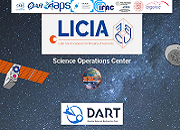 | LICIACube begins its cruise to Dimorphos. The SSDC role in the mission The DART planetary defense mission together with its companion cubesat LICIACube has been succesfully launched through a Falcon 9 this morning at the 7:21 Italian time from the Vandenberg base (California). As scheduled, the DART spacecraft was released 56 minutes after launch, and started its cruise phase which will end on October 2022 by impacting Dimorphos, the natural satellite of the Didymos asteroid, slightly deflecting its orbit. LICIACube (Light Italian Cubesat for Imaging of Asteroids) is the first entirely Italian deep space mission, aimed at witnessing the impact and post-impact phase of DART. SSDC is coordinating the LICIACube data management and dissemination, hosting the Science Operations Center (SOC) and developing the automated processing of the raw data received from the Argotec Mission Control Center (MCC). The data format has been defined in collaboration with Johns Hopkins University Applied Physics Laboratory (JHUAPL) to be compliant to the PDS4 standard, and thus both raw and calibrated data will be made available in this format to the team through the LICIACube SOC website. Further ongoing developments will allow to access these data through the SSDC MATISSE scientific webtool, so to enable advanced functionalities for data analysis and visualization.
|
Dec 03, 2020 | SSDC contribution to Gaia EDR3 On December 3th the Gaia collaboration has released its Gaia Early Data Release 3 catalogue. Gaia Data Release 3 is split in two parts: the early release called Gaia Early Data Release 3 (Gaia EDR3) and the full Gaia Data Release 3 (Gaia DR3), planned for the first half of 2022. Gaia DR3 data (both Gaia EDR3 and the full Gaia DR3) are based on data collected between 25 July 2014 and 28 May 2017, spanning a period of 34 months. As a comparison, Gaia DR2 was based on 22 months of data and Gaia DR1 was based on observations collected during the first 14 months of Gaia's routine operational phase. Gaia EDR3 catalogue contains more than 1.8 billions stars. SSDC is one of the four ESA partner data centers for the publication and dissemination of Gaia data releases. SSDC has thus designed, developed, and made publicly available an access point to the Gaia and cross-matched external catalogues data: the GaiaPortal. SSDC is continuing to develop access, data extraction and multi-wavelength cross-match tools to enable the astronomical community to handle and fully exploit the scientific potential of this enormous archive. In addition, SSDC is responsible for the calculation of the official cross-match of the Gaia catalogue with the largest public available optical and near-IR catalogues ensuring an all-sky, panchromatic vision of the universe.
|
Aug 13, 2020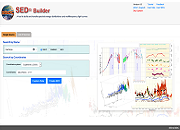 | An improved version of the SSDC SED Builder tool providing a new multi-source query service is now online The SSDC SED Builder is a well-known and widely used web tool to build and handle time resolved Spectral Energy Distributions (SEDs) and multifrequency light curves. We are pleased to announce the publication of an improved version of the SED Builder tool (V4.0), which now allows the registered users to perform queries for list of sources. Restyling: a re-designed layout of the initial SED Builder webpage with simplified loading of single source data (name or coordinates) now allows the user to directly create the SED of a known source, without being redirected first to the Sky Explorer tool. There is still the possibility to query the Sky Explorer through a dedicated button, if needed. All the single-source tool features familiar to users remain unchanged. New functionality: meeting the requests of several users, this new version of the SED Builder now provides a multi-source query service, accessible to registered users by clicking on the dedicated tab (List of Sources). Once logged in, the user may upload a list of sources in a chosen CSV format, where each line corresponds to a source data record. Once a multiple SEDs request has been submitted, an email with the results will be received. Note: for technical reasons, and to avoid bulk actions, the maximum number of sources that can be included in one list is currently limited to 10. The SSDC SED Builder provides open access to data from catalogs and from specific publications. If you use any of these data sets in a publication please make sure to give proper credit to the papers and/or external services from which data have been taken. Detailed credit information can be retrieved by clicking the “Data citation policy” button present on the SED Builder webpage. If your research benefits from the use of SSDC services, we would appreciate the following acknowledgement: "Part of this work is based on online services provided by the ASI-SSDC."
|
Aug 10, 2020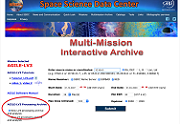 | Updated AGILE-LV3 tool for on-line gamma-ray data analysis and reprocessed AGILE data archive A new version of the AGILE-LV3 Tool with updated underlying software and calibrations(*) is now publicly available. In particular, the following improvements have been made:
(*) AGILE SW package AGILE_SW_6.0_SourceCode adapted from AGILE Science Tools BUILD25 and IRF H0025
|
Feb 07, 2020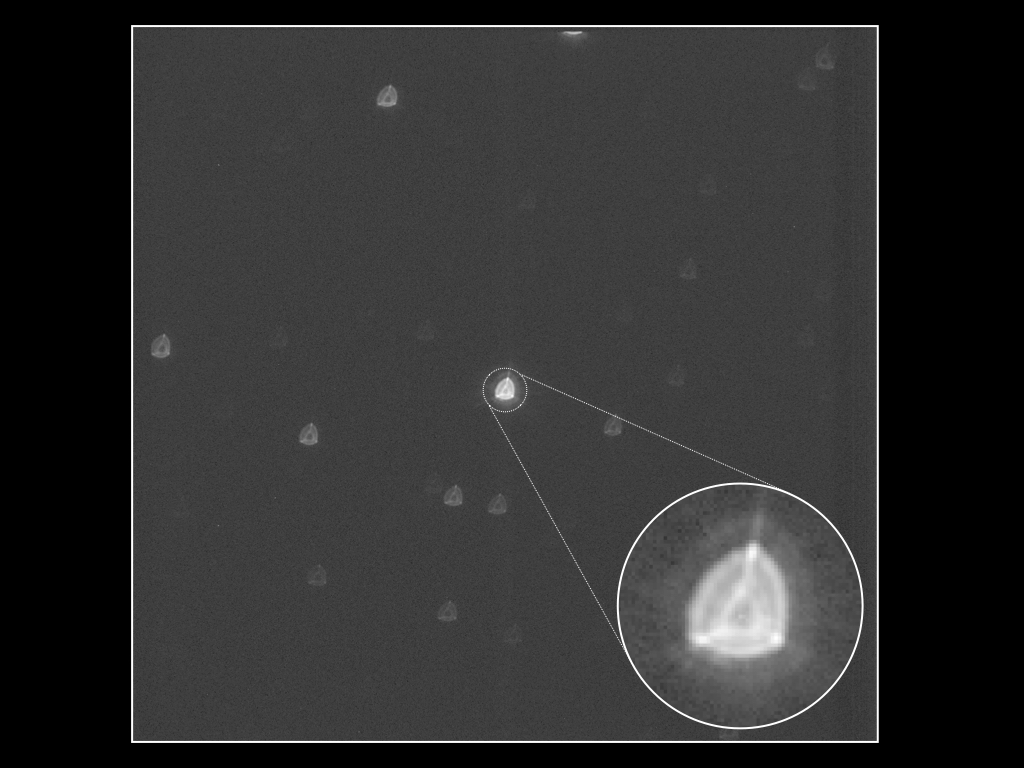 | CHEOPS image of the first Target! ESA's CHEOPS satellite has acquired the image of its first target, the star HD 70843, located 150 light years away and visible at the image center. The peculiar star shapes in the image are due to the deliberate telescope defocusing, needed to improve the starlight measurement precision spreading the light on more pixels to reduce the effect of small differences in their response. More info at: http://www.esa.int/ESA_Multimedia/Images/2020/02/Cheops_image_of_its_first_target_star
|
Dec 18, 2019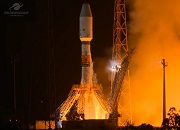 | CHEOPS successfully in orbit! The ESA CHEOPS mission was successfully launched on a Soyuz-Fregat launcher from Europe's spaceport at Kourou, French Guiana at 09:54:20 CET on 18 December. The satellite reached its final orbit about 2hrs later. SSDC has the responsability to create and mantain the unique mirror of the official Science Archive. A video of the lift off is available at https://www.youtube.com/watch?v=VXLWrJo3ZG0&feature=youtu.be 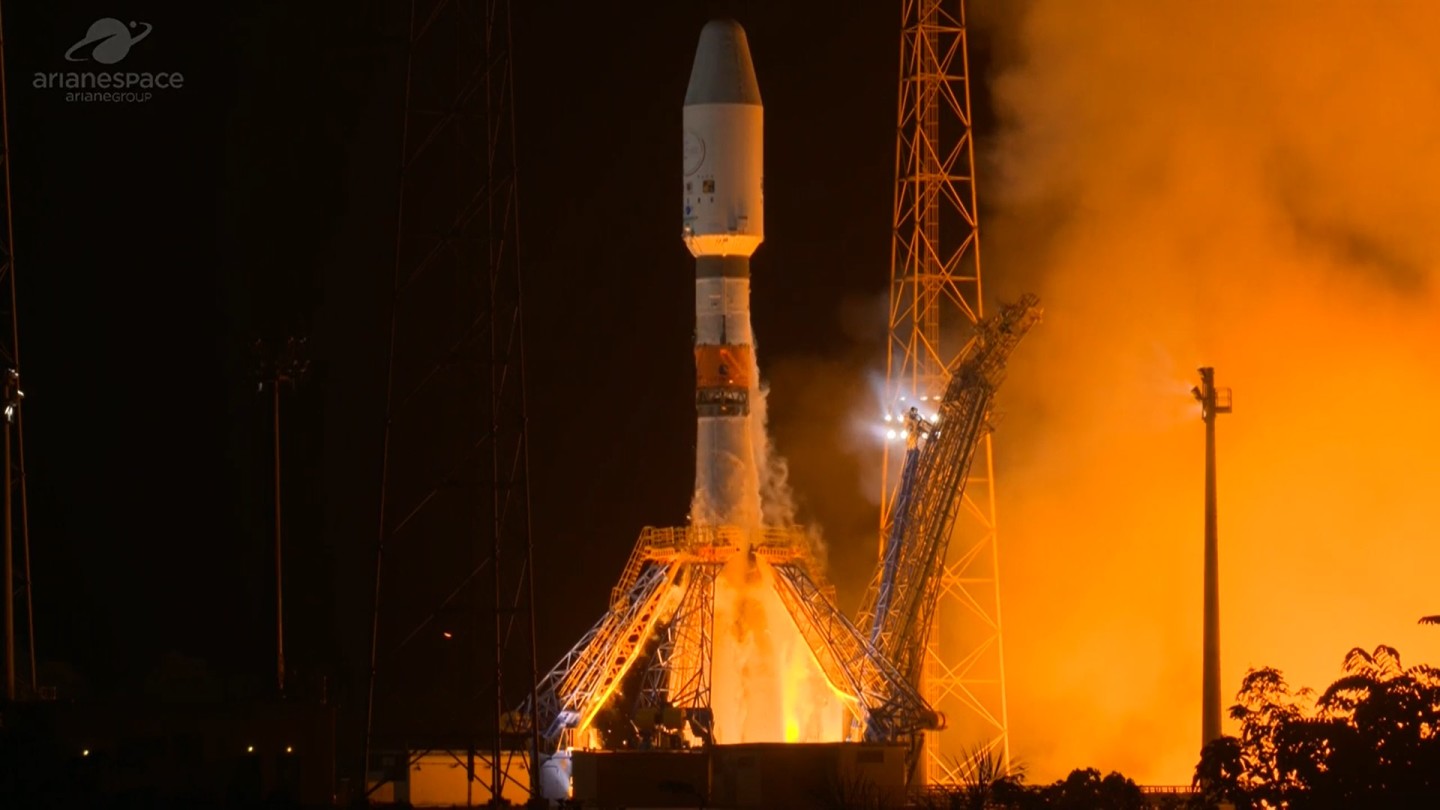 |
Nov 20, 2019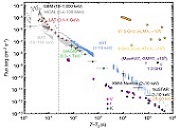 | TeV emission from a GRB detected by MAGIC for the first time in history: GRB190114C and the extensive campaign of multi-wavelength observations On 14 January 2019, the Major Atmospheric Gamma Imaging Cherenkov (MAGIC) telescopes observed and detected radiation up to at least 1 teraelectronvolt (TeV) from the Gamma Ray Burst (GRB) named GRB190114C, following an alert from the Neil Gehrels Swift Observatory and the Fermi satellite. The prompt event emission was also independently detected by AGILE (with MCAL and SuperAGILE), KONUS-Wind, INTEGRAL-SPIACS and Insight-HXMT. This is the first GRB ever reported by ground-based Cherenkov telescopes, and the MAGIC announcement triggered an extensive campaign of follow-up observations at all wavelengths, from radio to TeV. Emission up to TeV energies from GRBs had been foreseen in some theoretical studies, but it had remained until now unobserved. The detection of TeV radiation opens a new window in the electromagnetic spectrum for the study of GRBs. The ASI Space Science Data Center (SSDC) has been involved in this unprecedented result published today on Nature: "Observation of inverse Compton emission from a long gamma-ray burst", MAGIC Collaboration et al., Nature, vol. 575, p. 459-463 (2019) Nine (INAF and ASI) SSDC researchers are among the authors of the Nature paper published today (in alphabetical order):
- Papers: - Links (in Italian): 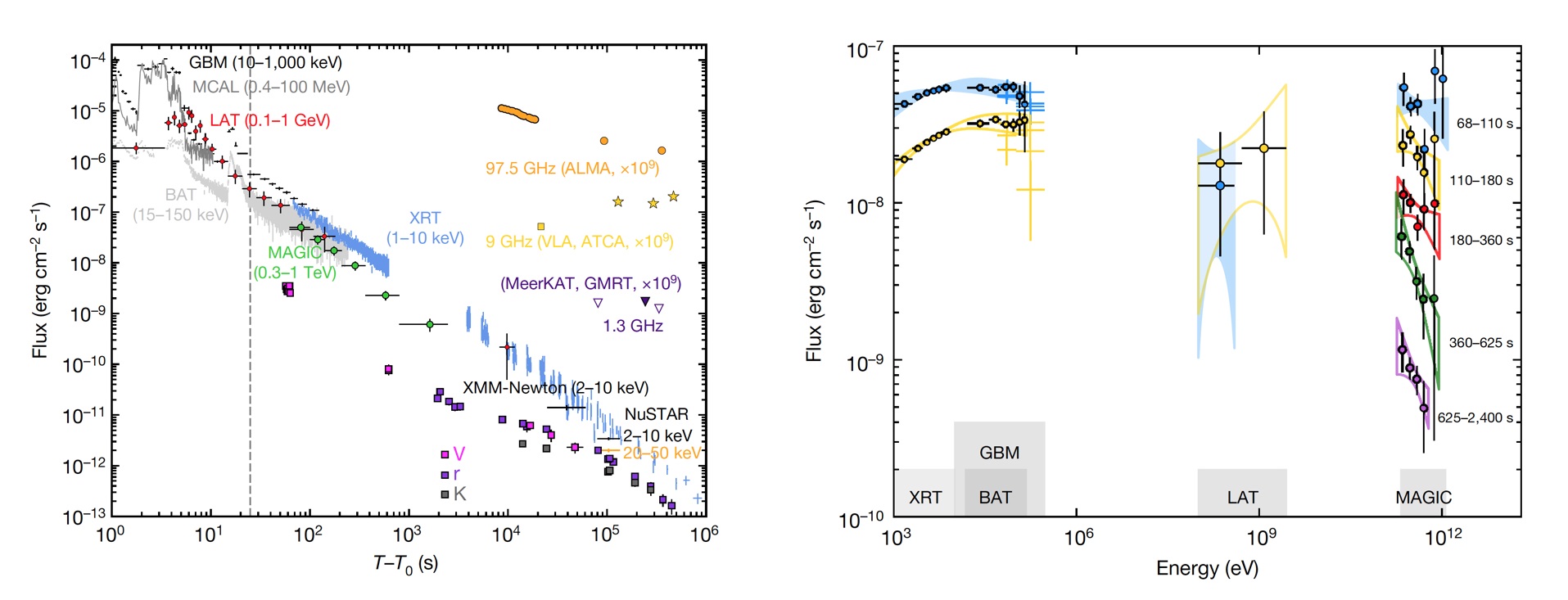 Figure: multi-wavelength light curves (left panel) and multi-band spectra (right panel) of GRB 190114C. Credits: Adapted from the MAGIC Collaboration et al., Nature paper: "Observation of inverse Compton emission from a long γ-ray burst". |
Jul 20, 2019 | The Moon and SSDC: examples from MATISSE Moon Mapping project and Fermi LAT July 20, 2019 marked the 50th anniversary of the first humans landing on the Moon on July 20, 1969 as part of NASA's Apollo 11 lunar mission. Such Apollo 11 mission changed our world and ideas of what is possible by successfully landing humans on the surface of the moon, and bringing them home safely, for the first time in history. During the Apollo program of the 1960s and '70s, NASA sent 9 missions to the Moon, and 6 of them landed astronauts safely on the surface, the only times humans have visited another world. A multinational crew of astronauts, including Luca Parmitano of ESA (European Space Agency) at the second time, is arrived at the International Space Station, with a launch from the Baikonur Cosmodrome in Kazakhstan aboard the Soyuz MS-13 spacecraft, in coincidence with this anniversary. The SSDC activities dedicated to the Moon are mainly those belonging to the "Moon Mapping" research cooperation project, established in 2014 by the Chinese and Italian governments to promote cooperation and exchange between students and scientists from both countries. The Italian Space Agency (ASI) had the responsibility for the coordination of the Italian side of the project and SSDC played a key role in this assignment, in particular during the operational phase, lasted from 2015 to 2017. During this period several universities and research institutes carried on joint activities using data acquired by instruments onboard the Chinese lunar exploration missions Chang'e 1 and Chang'e 2, with major focus on data pre-processing, structural and elemental mapping of the Moon and interaction with the solar wind. The great part of the data have been analyzed and visualized by means of the SSDC tool MATISSE, that allowed to search and map the data directly of the 3D model of the Moon, apart from converting them to 2D formats of widespread use in the scientific community of interest. The final results of the "Moon Mapping" project will be comprised in a textbook, dedicated to the wide public, whose first draft version has been presented during the "2018 Italy-China Week for the Science, Technology and Innovation" (available here in PDF format). Another scientific space mission supported by SSDC, the Fermi Gamma-ray Space Telescope Large Area Telescope (LAT) has produced a novel image of our Moon. If we observe the gamma-ray sky above 100 MeV photon energy the Moon is brighter than the Sun! This surprising vision of the Moon produced by the Fermi LAT is represented, for example, in the image representing the integrated photon intensity significance and based on data collected by the first seven years of operation, reported in 2016 also by the APOD web site. The Fermi LAT doesn't distinguish details on the lunar surface, but a gamma-ray glow consistent with the Moon's size and position in the sky is clearly found at the center of the false-color map. The brightest pixels correspond to the most significant detections of lunar gamma-rays. High-energy charged particles, i.e. cosmic rays, streaming through the Solar System constantly bombard the lunar surface, unprotected by a magnetic field, generating the gamma-ray glow. Because the cosmic rays come from all sides, the gamma-ray Moon is always full and does not go through phases. An updated analysis based on 11-years data is ongoing. The 2016 scientific paper is here. The corresponding INFN news (in Italian) is here.  |
May 10, 2019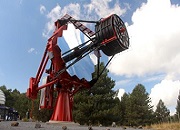 | First detection of the Crab Nebula at TeV energies by the ASTRI-Horn double-mirror Cherenkov telescope 30 year ago, the first historical detection of the Crab nebula at TeV energies by the Whipple telescope opened the era of the ground-based TeV astronomy with Cherenkov telescopes. Last December 2018, the ASTRI-Horn telescope, a prototype of Cherenkov telescope based on an original double mirror optical configuration and equipped with innovative light detectors made of silicon photo-multipliers, has obtained its first detection of the Crab Nebula at TeV energies, proving the viability of this technology.
The ASTRI-Horn telescope. Credits: INAF |
| Jul 12, 2018 | Discovery of neutrino and gamma rays from the same blazar source by IceCube and Fermi with contribution of MAGIC and AGILE The discovery of an association of a very high-energy neutrino with a flaring photon gamma-ray blazar object by the IceCube experiment and the Fermi space satellite, announced on July 12, 2018 with a press conference by NSF and a cover and paper in the Science journal, highlights for the first time mechanisms and conditions for highest-energy cosmic rays acceleration and the existence of extragalactic sources producing high-energy neutrinos and gamma rays. The detection of an about 290 TeV energy neutrino (namely the event IC-170922A) on 22 September 2017 by the IceCube experiment at the Amundsen-Scott South Pole Station, in Antarctica, was found to be consistent with the location of a Fermi Gamma-ray Space Telescope catalogued gamma-ray source (3FGL J0509.4+0541, i.e. the blazar TXS 0506+056). The Fermi Large Area Telescope (LAT) first reported the positional coincidence (within 0.1 degrees) of the very high-energy neutrino event with a gamma-ray source detected at E>100 MeV, the blazar TXS 0506+056 (also known as MG1 J050927+0541, RX J0509.3+054, ZS 0506+056 and other), in a flaring state, issuing one Astronomer's Telegram (ATel) on September, 28, 2017. This triggered many observations and results with the corresponding multi-wavelength follow-up measurements, for example by MAGIC, AGILE, Swift and NuSTAR. All these are missions and experiments see the participation of the ASI Space Science Data Center (SSDC), and Fermi, MAGIC and AGILE are built with a fundamental contribution of INFN and INAF. Notably AGILE confirmed soon after the association of IC-170922A with the E>100 MeV gamma-ray activity of TXS 0506+056 with another ATel, while the MAGIC Cherenkov telescope also detected it and revealed periods where the gamma-ray flux from the blazar reached energies of up to 400 GeV. Subsequent measurements of the source have been completed at X-ray, optical, and radio wavelengths. Formerly AGILE suggested also a possible association of gamma rays with an IceCube neutrino event in July 2016, after the detection of a gamma-ray transient found to be consistent with the position and time of IC-160731. Based on the redshift of TXS 0506+056, with value z=0.3365 corresponding to a luminosity distance of 5.5 billion light years, accurately measured and published in February 2018 (only upper/lower limits were available before), constraints are derived for the muon neutrino luminosity for this source, found to be similar to the luminosity observed in gamma rays. The energies of the gamma rays and the neutrino indicate that blazar jets may accelerate cosmic rays to at least several PeV. Chance correlation of this neutrino with the flare of TXS 0506+056 is statistically disfavored at the level of 3 sigma in any of the evaluated models associating neutrino and gamma-ray production. This important result for the newborn multi-messenger astro-particle physics confirms the close relations among the different cosmic messengers. The most extreme cosmic explosions producing transient gamma rays (GRBs) also produce gravitational waves, and the most extreme cosmic accelerators producing intense, persisting and variable flux of gamma-rays (blazars) produce high-energy neutrinos and cosmic rays. Through the Fermi and AGILE satellites and the large ground based astro-particle experiments for neutrinos, UHE cosmic rays and gravitational waves, gamma rays are providing a bridge to each of these new cosmic signals, opening the multi-messenger astronomy era. Many interpretations and works, published or in preparation, are following up the discovery, shedding light on a truly multi-messenger scenario for the flaring GeV gamma-ray blazar TXS 0506+056 and the implications for very high-energy neutrino emission and cosmic ray acceleration. The ASI SSDC is contributing and supporting archive, data, software and science operations and data analysis tasks for the Fermi, AGILE, Swift, and NuSTAR missions. More information: Italian news:
Figure collage credits: SCIENCE magazine/American Association for the Advancement of Science (AAAS), SCIENCE Communication Lab, IceCube Collaboration, NSF U.S. National Science Foundation-Office of Polar Programs, NSF U.S. National Science Foundation-Physics Division, University of Wisconsin-Madison, National Aeronautics and Space Administration (NASA), NASA's Goddard Space Flight Center/CI Lab, NASA/DOE/Fermi Large Area Telescope Collaboration, Sonoma State University, MAGIC Collaboration, AGILE Collaboration, PGC/NASA U.S. Geological Survy Data SIO,NOAA, U.S. Navy, NGA, GEBCO Landsat/Copernicus, Jamie Yang, Savannah Guthrie, Nicolle R. Fuller, Aurore Simonnet.
|
May 03, 2018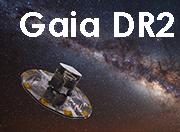 | SSDC contribution to Gaia second data release On april 25th the Gaia collaboration has released the richest star catalogue to date, including high-precision measurements of nearly 2 billion stars and revealing previously unseen details of our Galaxy.
|
| Feb 02, 2018 | The High energy Particle Detector (HEPD) is now on orbit! CSES (China Seismo-Electro-magnetic Satellite), which hosts the HEPD payload was launched on February 2, 2018 at 08:51 (CET, Rome time) from the Jiuquan Satellite Launch Center. More:
|
| Jan 17, 2018 | Fermi GBM wins the 2018 "Bruno Rossi Prize" We are pleased to report that the 2018 Bruno Rossi Prize of the High Energy Astrophysics Division (HEAD) of the American Astronomical Society has been awarded to Dr. Colleen Wilson-Hodge and the Fermi Gamma-Ray Burst Monitor (GBM) instrument Team for their masterpiece discovery of soft gamma rays coincident with a gravitational wave burst event GW170817 = GRB 170817A in the galaxy NGC 4993 (see also the Oct. 16, 2017 press conference video at NSF, Fermi after minute 21:40) and the confirmation that short gamma-ray bursts are produced by binary neutron-star mergers. This is the sixth time that a space mission supported by SSDC has been directly awarded a Rossi Prize, after BeppoSAX in 1998, Swift in 2007, Fermi (Large Area Telescope, LAT) in 2011, AGILE in 2012 and NuSTAR in 2015. This is also the fourth time that the Fermi mission is awarded with a direct prize to teams of the Fermi instruments (2001 and 2018) or to scientists that have obtained important results thanks to Fermi data (2013 for Fermi LAT gamma-ray pulsar studies, 2014 for the Fermi LAT discovery of the gamma-ray bubbles of our Milky Way galaxy). Read and view more:
|
Dec 06, 2017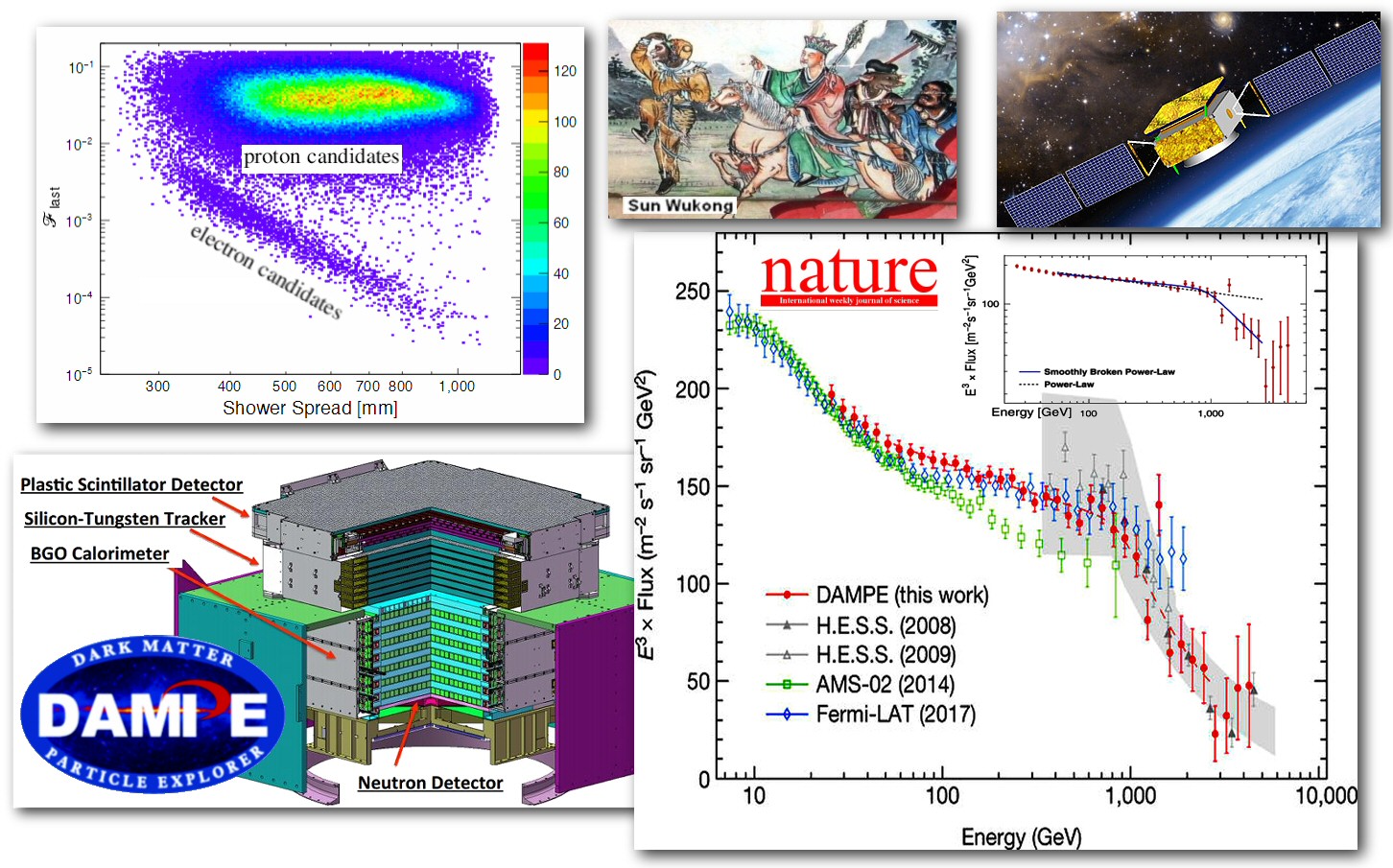 | DAMPE direct detection of a TeV-energy break in cosmic-ray spectrum of electrons and positrons The Chinese Dark Matter Particle Explorer (DAMPE, also known as Sun Wukong) space mission published its first relevant scientific results in Nature scientific journal, presenting the precise measurement of high energy cosmic ray electrons plus positrons (CREs), and highlighting a solid break (i.e. a sharp variation) in the spectral energy distribution at about 0.9 TeV. High energy CREs provide an ideal probe of sources in our neighbourhood since they loose quickly their energy during their propagation in the interstellar medium: precision measurement of their flux by DAMPE can considerably narrow down the parameter space of different models - such as nearby pulsars, supernova remnants and/or candidates of particle dark matter - needed in order to explain the 'positron excess' observed by AMS up to about 500 GeV. Evidence for a spectral break in the TeV energy range has been previously provided by indirect measurements of H.E.S.S., although the results were qualified by sizeable systematic uncertainties. DAMPE CREs spectrum data are instead characterized by unprecedentedly energy resolution and low background. A smoothly broken power-law model rather than a single power-law model can properly fit the majority of the spectrum. The DAMPE mission is funded by the strategic priority science and technology projects in space science of the Chinese Academy of Sciences (CAS). DAMPE, China's first astroparticle physics satellite, was launched from Jiuquan Satellite Launch Center into sun-synchronous orbit on Dec. 17th, 2015. At an altitude of about 500 km, DAMPE has been collecting data since a week after its launch. In its first 530 days of science operation through June 8 of this year, DAMPE has detected 1.5 million cosmic ray electrons and positrons above 25 GeV. DAMPE, with its 1900Kg of total weight (1400Kg for the scientific experiment), is expected to record more than 10 billion cosmic ray events over its useful life-projected to exceed five years given the current state of its instruments. DAMPE is a collaboration of more than a hundred scientists, technicians and students at nine institutes in China, Switzerland and Italy, under the leadership of the Purple Mountain Observatory (PMO) of the CAS. Italy is involved with a group of about twenty scientists from the INFN sections of Perugia, Bari and Lecce and the Universities of Perugia, Bari and Salento. A key component of DAMPE is the silicon tracker, developed with the coordination of INFN-Perugia, based on the experience and skills acquired in the work done for other space experiments such as AMS-02 and Fermi-LAT. After the publication of the results about CREs, the Italian scientific group is working to measure the flux of protons and ions, and to study the detected high energy gamma-ray photons. DAMPE is among the projects developed in the SSDC center: not only DAMPE data have been immediately available for download from the Cosmic Rays Data Base, but SSDC appears among the institutes in the Nature publication thanks to the contribute of D.D'Urso to the data handling in the Europe. More:
 |
Feb 06, 2017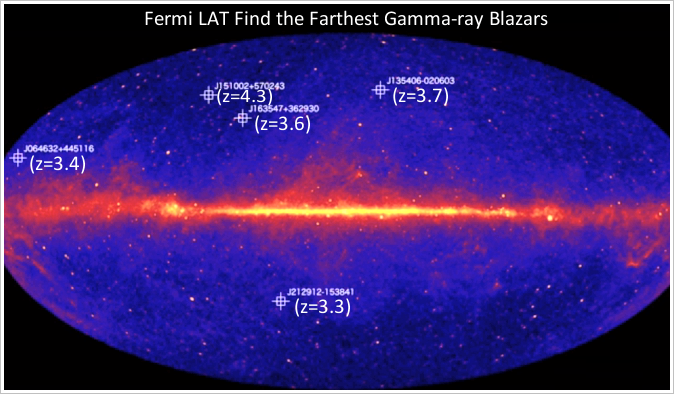 | Fermi Gamma-ray Space Telescope identified the farthest gamma-ray blazars. The detection of high-redshift (z>3) blazars by the Fermi Large Area Telescope (LAT) is of great astrophysical importance as they are extreme objects whose energetics remain a mystery.More importantly, high-z blazars tend to host massive black holes and can be used to constrain the space density of heavy black holes in the early Universe. The first detection with the LAT of five gamma-ray emitting blazars beyond z=3.3, has been announced and presented at the American Physical Society meeting in Washington in January 2017, and a paper describing the results has been submitted to The Astrophysical Journal Letters. Light from the most distant object, NVSS J151002+570243 (z=4.31), began its journey to us when the universe was 1.4 billion years old. These objects have steeply falling gamma-ray spectral energy distributions and, those that have been observed in X-rays, a very hard X-ray spectrum, both typical of powerful blazars.Their Compton dominance (ratio of the inverse Compton to synchrotron peak luminosities) is also very large (> 20). All of these properties place these objects among the most extreme members of the blazar population. The radio-loudness may play a key role in rapid black hole growth in the early Universe. Fermi LAT could have detected just the tip of the iceberg, the first examples of a galaxy population that previously has not been detected in gamma rays This research was led by researchers at the Clemson University, South Carolina, USA and at the ASI Space Science Data Center (SSDC), Rome, Italy, including D. Gasparrini (ASI SSDC and INFN). They began by searching for the most distant sources in a catalog of 1.4 million quasars, a galaxy class closely related to blazars. Because only the brightest sources can be detected at great cosmic distances, they then eliminated all but the brightest objects at radio wavelengths from the list. With a final sample of about 1,100 objects, the scientists then examined LAT data for all of them, resulting in the detection of five new gamma-ray blazars. More details in the NASA's press release, ASI news, and in the forthcoming ApJ Letter. |
Dec 30, 2016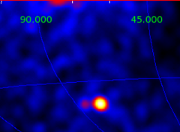 | 50000 orbits of AGILE celebrated with the observation of an exceptional gamma-ray event A few months before its tenth birthday in orbit, on December 19, 2016 at 06:08:53 UTC the AGILE satellite has reached the significant milestone of 50000 passes over the ASI Malindi Ground Station in Kenya with all detectors operating nominally. AGILE is devoted to gamma-ray astrophysics, and it is also capable of detecting high energy phenomena of terrestrial nature, such as Terrestrial Gamma-ray Flashes (TGFs) revealed in the Earth equatorial regions. It is also currently at the forefront in the hunt for electromagnetic counterparts of gravitational waves. The Italian satellite, launched on April 23, 2007 in low Earth orbit, is a small Scientific Mission of ASI, built and operated in cooperation with INAF, INFN, CIFS and with the participation of the Italian companies CGS, Thales-Alenia Space e Telespazio. The small high-tech jewel, designed for an operative life of only two years, continues its mission with high efficiency, and it has celebrated its 50000 orbit with the observation of an exceptional gamma-ray event of extragalactic origin. 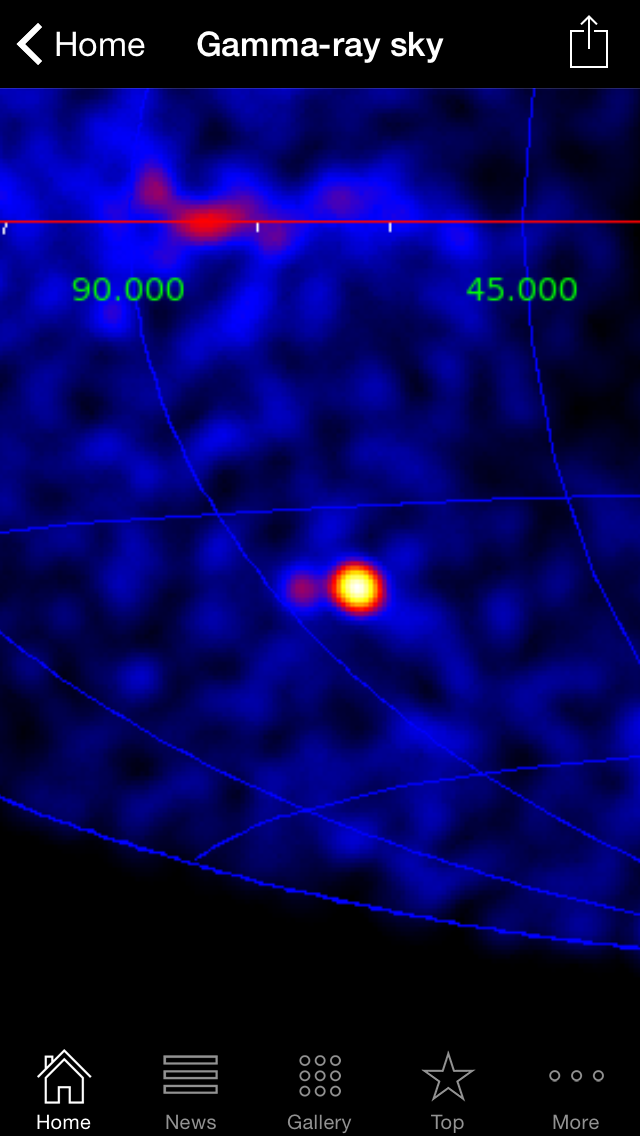 Credits: Screenshot downloaded on December 19, 2016 from the AGILEScience free app dedicated to the AGILE satellite. As you can see from the fascinating image above, two monsters black holes at the center of the two distant active galactic nuclei CTA 102 and 3C 454.3, apparently close to each other in the AGILE sky map, made a spectacular double super-flare almost simultaneously in gamma rays. The image was downloaded from the AGILEScience free app that enables anyone to follow in real time the latest satellite observations. In particular, the CTA 102 source in these days was the brightest of the entire gamma-ray sky, even brighter than much closer sources within our galaxy, such as the Vela pulsar. For more information, see also: ASI news and INAF news (in Italian) AGILE ATel #9743, ATel #9788, ATel #9840, ATel #9911 and references therein. The AGILE data acquired from the ASI Malindi Ground Station are readily processed archived and managed by the SSDC/ASDC, the multi-mission ASI data center, and distributed to the PI Team alert system at INAF Bologna. The automatic alerts are analyzed daily by researchers of the AGILE team at several INAF institutes and at the ASDC itself. |
May 02, 2016 | The BeppoSAX X-Ray Astronomy Satellite (1996-2016): 20 years after the launch The X-ray astronomy satellite BeppoSAX (Satellite per Astronomia X, "Beppo" in honor of Giuseppe Occhialini), is a project of the Italian Space Agency (ASI) with participation of the Netherlands Agency for Aerospace Programs (NIVR). BeppoSAX was launched On 30 April 1996 and operated succesfully until 2002. The main scientific characteristic of the BeppoSAX mission is the wide spectral coverage, ranging from 0.1 to over 200 keV, it was the first Italian satellite for the study of Astronomy High Energy. In six years of operational life it has made 30.720 contacts with the Malindi ground station and has operated about 1.500 observations of different types of cosmic sources. The most important result of the BeppoSAX Observatory was the discovery of the existence of the X-ray afterglows following Gamma Ray Burst (GRB) explosion. This major discovery earned Enrico Costa and other members of the BeppoSAX team several international recognitions including the "Enrico Fermi Award" 2010 (assigned to Enrico Costa and Filippo Frontera), the Descartes Prize of the European Union 2002 (shared among a group of scientists including Filippo Frontera, Enrico Costa, Luigi Piro and other members of the BeppoSAX team) and the Bruno Rossi Prize from the High Energy Astrophysics Division of the American Astronomical Society (awarded in 1998 to the BeppoSAX team and Jan van Paradijs). The Archives of BeppoSAX data is available at the Center Scientific Data Italian Space Agency, ASI Science Data Center (ASDC), the multi-mission center founded in 2000 as an evolution of BeppoSAX SDC. The BeppoSAX mission has inaugurated a new era for the High Energy Astrophysics, a field in which Italians have a long tradition of excellence. For More details on BeppoSAX see: The_BeppoSAX_Xray_Astronomy_satellite.pdf The_BeppoSAX_publications_list.pdf To commemorate this historic mission, the Italian Space Agency (ASI) organized on May 2, 2016 the event: From the launch of Beppo-SAX today: twenty years of Italian successes in Space |
Apr 06, 2016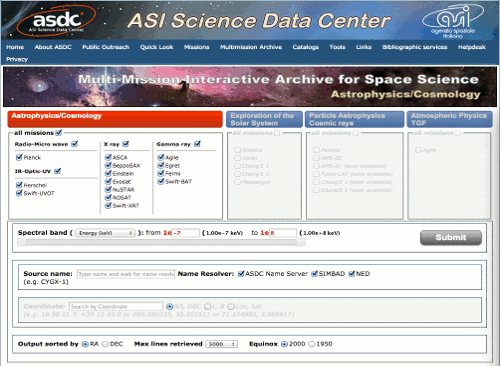 | An improved version of the ASDC 'Multi-Mission Interactive Archive for Space Science' tool is online! The 'Multi-Mission Interactive Archive for Space Science' (MMIA2.0) is a new tool of the ASI Science Data Centre to explore its whole database. The ASDC is a repository of datasets from several space missions, exploring the Earth atmosphere, the Solar System and the Universe throughout the entire electromagnetic spectrum and other channels, such as the cosmic rays. MMIA2.0 is a user-friendly interface which allows scientists to access this all-encompassing and diverse databases. The tool has four main access tabs corresponding to the scientific topics supported at ASDC: - Astrophysics and Cosmology. It groups all ASDC missions for the observation of the Universe. They are ordered according to the wavelengths/energies of their instruments, from Radio to Gamma-rays. Missions are selectable individually, in wavelength groups or in a specific spectral range. Observations of a single source or a sky region around a coordinate pairs can be retrieved (the default search radius is different for each selected mission). - Exploration of the Solar System. This section provides links to the MATISSE tool by choosing the mission and the target. Once the user is on the MATISSE homepage the search can be performed by means of geographical (e.g. latitude/longitude) and geometrical (angle of observations) metadata to obtain both single- or multi-observation visualization. - Particle Astrophysics/Cosmic Rays. It includes data from the only two magnetic spectrometers dedicated to charged cosmic rays research in space: PAMELA and AMS-02. Other experiments data will be added in the near future. Measurements of differential energy fluxes, time flux variations and solar flares, as well as fluxes of trapped particles in the Earth magnetosphere, and flux ratios are available in the database. The user can plot the data, download tables and graphs. - Earth's Atmosphere/Terrestrial Gamma-ray Flashes. This is the newest ASDC tab. It currently gives access to data from Terrestrial Gamma-ray Flashes detected by the Minicalorimeter (MCAL) instrument on-board the AGILE satellite, and to light curves for the two TGF catalogs so far published by the AGILE Collaboration. Correlations with lightning and other Earth atmospheric parameters, and data from other missions will be included in MMIA2.0 in the near future. The tool can be accessed from the ASDC main web page at www.asdc.asi or directly at www.asdc.asi.it/mma.html 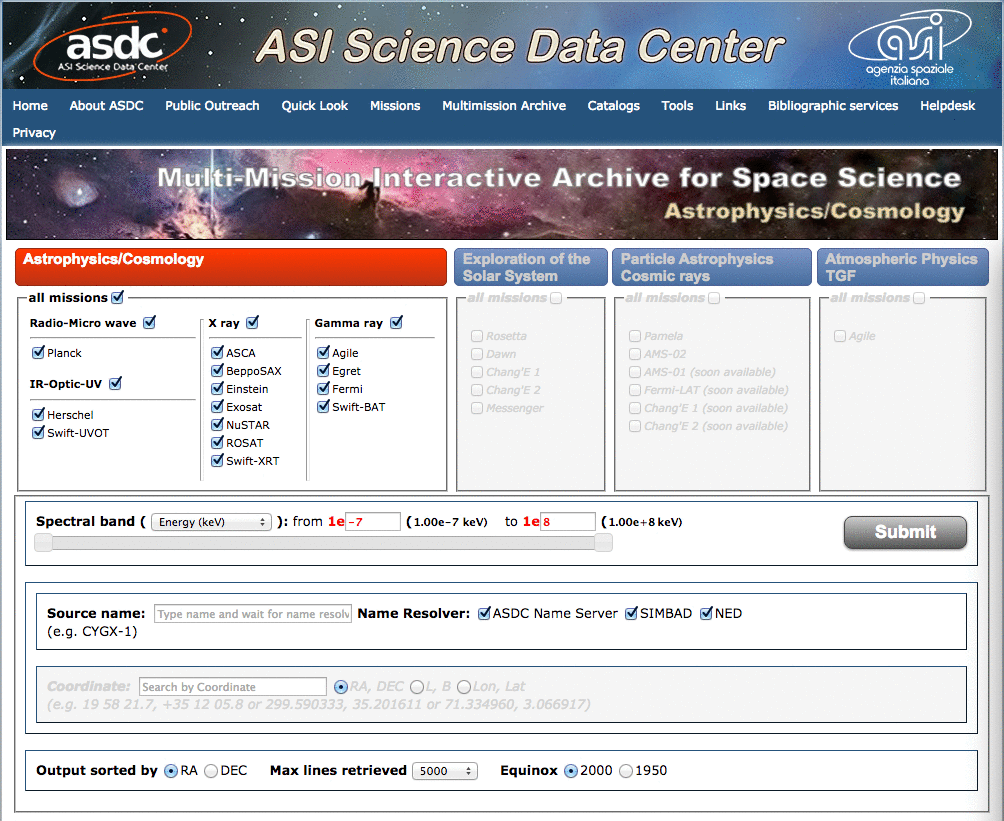 |
Nov 20, 2015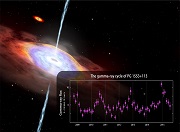 | Multiwavelength evidence for quasi-periodic modulation in the gamma-ray blazar PG 1553+113 Italian scientists using about 7 years of data from NASA's Fermi Gamma-ray Large Area Telescope (LAT) have detected the first evidence of quasi-periodic changes in the gamma-ray flux emitted by the BL Lac object PG 1553+113. PG 1553+113 lies in the direction of the constellation Serpens Caput, with a redshift lying between 0.395 and 0.6. This optical/X-ray-selected blazar is intensively observed from Cherenkov telescopes at very-high energy gamma rays and may have associated PeV neutrino emission, potentially increasing the interest for this result. If confirmed in the next years, the discovery would mark the first years-long cyclic gamma-ray and correlated multifrequency emission ever detected from any AGN, providing new insights into physical processes near the central supermassive black hole. This research is led by S. Ciprini and S. Cutini two INFN researchers belonging the Fermi team at the ASI Science Data Center (ASDC) in strict cooperation with A. Stamerra, INAF Senior Scientist at ASDC. The work has seen also a synergetic international collaboration with scientists like S. Larsson (Royal Institute of Technology, Stockholm Sweden), R. Corbet (NASA Goddard Space Flight Center, USA), both periodical visitors and collaborators of the ASDC, D. Thompson (NASA Goddard Space Flight Center, USA and Deputy Project Scientist of the Fermi mission), W. Max-Moerbeck (National Radio Astronomy Observatory, Socorro, USA) and M. Perri (INAF Rome and ASDC). Motivated by the possibility of regular gamma-ray changes, the researchers examined a decade of multiwavelength data. These included long-term optical observations from Tuorla Observatory program in Finland, Lick Observatory, KAIT observatory in USA, and the Catalina Sky Survey near Tucson, Arizona, as well as optical and X-ray data from Swift XRT and UVOT instruments and radio, 15 GHz, data from the Owens Valley Radio Observatory, USA. Ciprini, Cutini, Stamerra and their collaborators published the findings in the Nov. 10 edition of The Astrophysical Journal Letters. The indication of a possible 2-year periodic modulation was possible thanks to the continuous all-sky survey of Fermi; the increased capability of the new Fermi LAT Pass 8 data; and the long-term radio/optical monitoring of LAT gamma-ray blazars. If the gamma-ray cycle of PG 1553+113 is in fact real, the blazar will peak again in 2017 and 2019, well within Fermi's expected operational lifetime. The scientists identified several scenarios that could drive periodic emission, including different mechanisms that could produce a years-long wobble in the jet of high-energy particles emanating from the black hole. For example pulsational accretion flow instabilities, jet precession, rotation and/or helical structure, or mechanisms analogous to low-frequency QPO of high-mass binary stars. The most exciting scenario involves the presence of a second supermassive black hole closely orbiting at milliparsec scales the one producing the jet we observe. The gravitational pull of the neighboring black hole would periodically tilt the inner part of its companion's accretion disk, where gas falling toward the black hole accumulates and heats up. The result would be a slow oscillation of the jet much like that of a lawn sprinkler, which could produce the cyclic gamma-ray changes we observe. In this rather less probable but exciting scenario very-low frequency gravitational wave emission would make PG 1553+113 an ideal multimessenger high-energy-photon/neutrino/gravitational-waves source, in this sense the blazars could represent the major "cost-free" accelerators in the nature and ideal multifrequency and multimessenger physics laboratories. 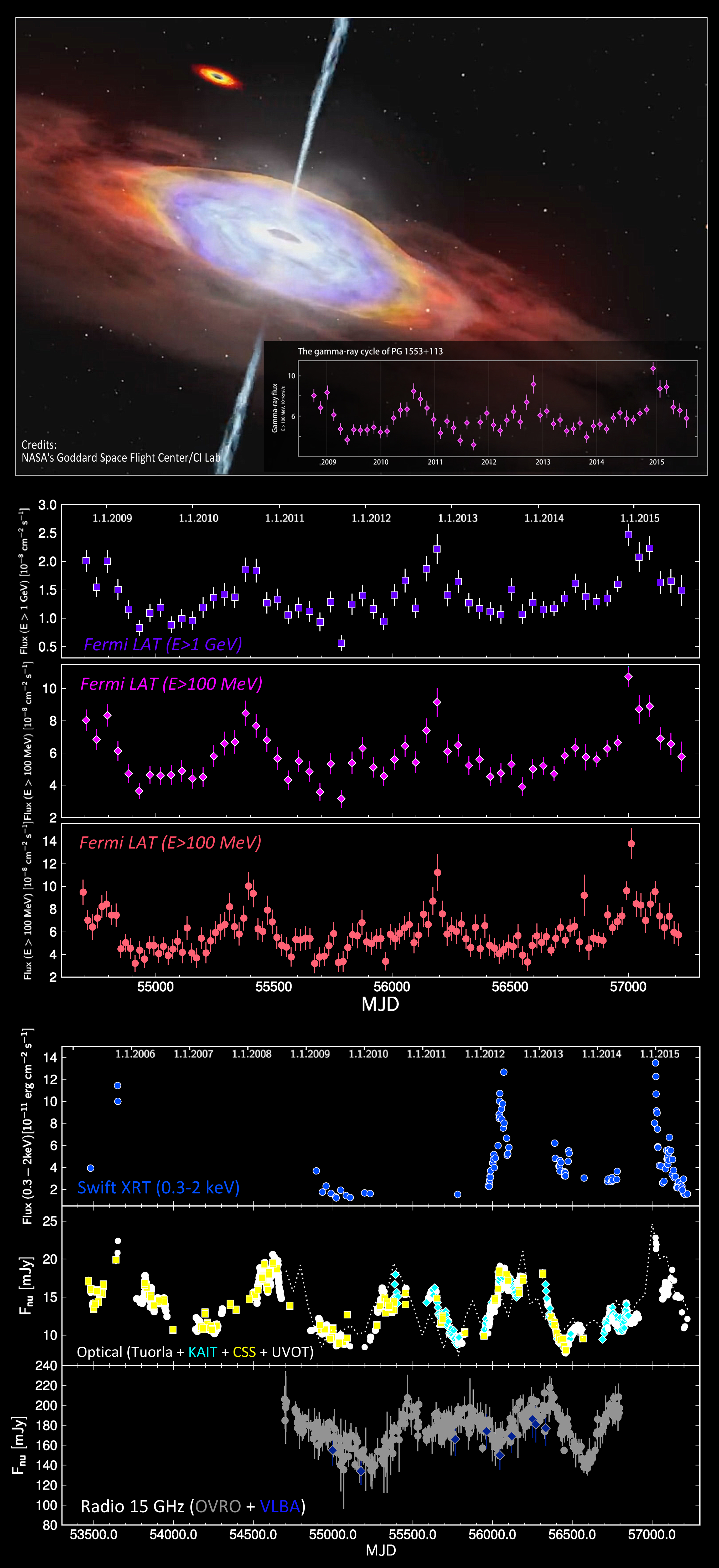 Fermi observations suggest possible years-long cyclic changes in gamma-ray emission from the blazar PG 1553+113. The marginal significance of the 2.18+/-0.08 year period gamma-ray cycle is strengthened by correlated oscillations observed in radio and optical fluxes. The first, top panel, shows Fermi Large Area Telescope data from August 2008 to July 2015 for gamma rays with energies above 100 million electron volts (MeV) with one possible explanation for the gamma-ray cycle, an oscillation of the jet produced by the gravitational pull of a second massive black hole, seen at top left in background in this artist's rendering [credits: NASA's Goddard Space Flight Center/CI Lab]. The panels following below the pictorial artist's rendering show all the data used in this research. From top to bottom the gamma-ray (E>100 MeV, and at E>1 GeV) flux light curves (the second, third and fourth panel), the X-ray (0.3-2.0 keV) integral flux by Swift XRT, the optical flux density (R filter) from Tuorla, Catalina CSS and KAIT monitoring programs and Swift UVOT, where the dotted line is the gamma-ray light curve scaled and superposed, and the 15 GHz flux density from the OVRO 40 m radio telescope and by VLBA (the fifth, sixth and seventh panel). |
Oct 28, 2015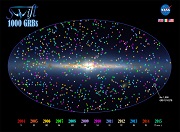 | Swift catches its 1000th Gamma-ray Burst! Swift 1000th gamma-ray burst (GRB), detected on October 27 2015, has triggered the usual flurry of mail announcements by optical and radio observers who hurried to their instruments to search for the afterglow of the high-energy event. The event is named GRB 151027B to reflect the date of the detection. Gamma-ray bursts are the most energetic explosions in the universe. The typically last about a minute and are located randomly across the sky. GRB 151027B had a duration of about 50 seconds. They are flashes of gamma rays produced when black holes are formed and are often referred to as the birth cries of black holes. GRBs are classified according to the duration of the event: long ones (which account for roughly 90% of the detections) last for more than 2 seconds, short ones can be over in few milliseconds. More than half of the SWIFT GRBs have been seen at optical wavelengths and 60% of such detections yielded a redshift measurement making it possible to gauge precisely the distance of the events. After more than 10 years of operations, 1000 GRBs and 6300 Target of Opportunity observations, Swift is expanding its grasp by providing coverage for gravitation wave alerts as well as for neutrino events. Swift, launched in November 2004, is a NASA mission with international participation from the United States, the United Kingdom, and Italy. The Italian participation includes the provision of the Malindi ground station (ASI), the mirrors of the X-ray Telescope (INAF-OAB) and the ASI Science Data Center (ASDC) which hosts an official mirror of the Swift scientific data archive and has the responsibility of the development of the Data Reduction Software for the XRT instrument on board Swift (XRTDAS). 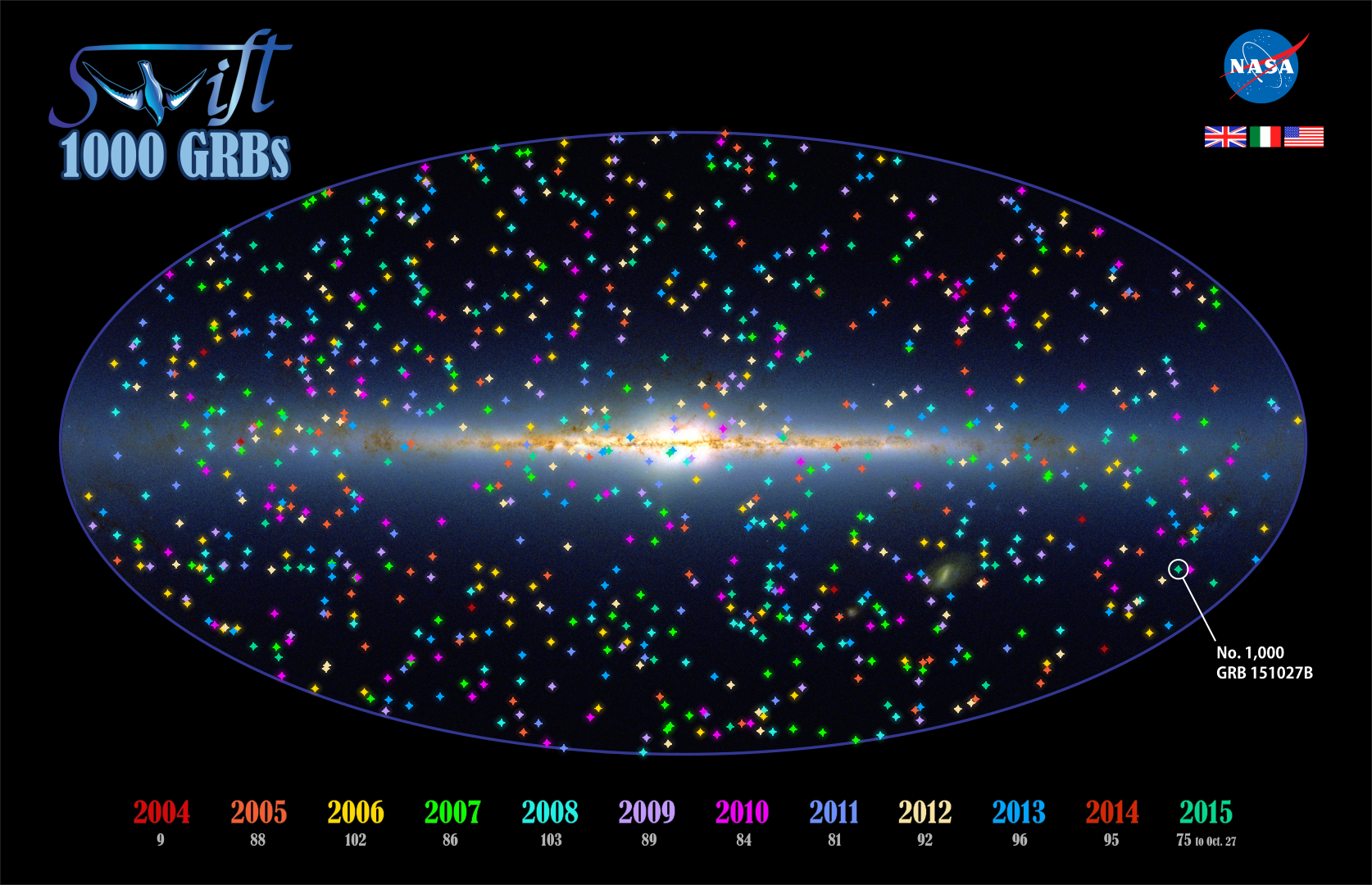 Positions of the first 1,000 Swift GRBs on an all-sky map of our galaxy, the Milky Way. Bursts are color coded by year, and the location of GRB 151027B is shown at lower right. An annual tally of the number of bursts Swift has detected appears below the label for each year. Background: An infrared view from the Two Micron All-Sky Survey.[Credits: NASA's Goddard Space Flight Center and 2MASS/J. Carpenter, T. H. Jarrett, and R. Hurt] |
Sep 17, 2015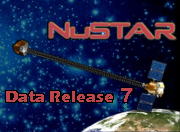 | NuSTAR 7th Data Release at ASDC The NuSTAR 7th Data Release (DR7) is available from September 17, 2015 at ASDC. The NuSTAR DR7 constitutes the final primary mission data release and contains a total of 1750 data sets. All the NuSTAR public data at ASDC are fully integrated in the ASDC Multi-Mission Interactive Archive (MMIA). Through the MMIA the user can perform on-line analysis of all NuSTAR public observations, without the need to download any software, including the extraction of high-level scientific products (cleaned event files, sky images, energy spectra, light-curves, ARFs and RMFs). For more details on NuSTAR, see: https://nustar.ssdc.asi.it/ http://www.nustar.caltech.edu/ http://heasarc.gsfc.nasa.gov/docs/nustar/ |
May 29, 2015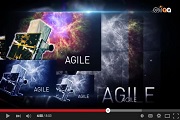 | AGILE: 8 and counting "AGILE: 8 and counting", this was the title of the 13th AGILE Workshop celebrating the eighth anniversary of the launch of the AGILE satellite. Since its launch on 23 April 2007, AGILE has made several important scientific discoveries, such as the variability of the Crab Nebula in gamma-rays, and the existence of a high-energy component in terrestrial gamma-ray flashes (TGF) produced in the Earth atmosphere. The 13th AGILE Workshop was held in the ASI Headquarters on May 25-26, 2015. The slides of all contributions are publicly available at the workshop website. A special ASI-TV report by G. Pulcrano was dedicated to AGILE in this occasion. The video (in italian) can be viewed here. 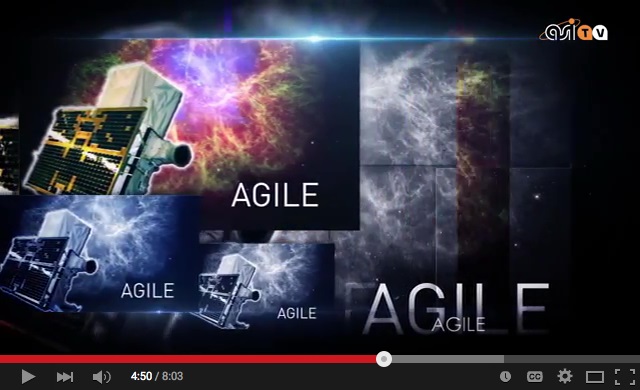 CREDITS: ASI-TV report by Giuseppina Pulcrano, ASI-TV Chief Editor: Manuela Proietti, Video Editor: Daniele Quatrini. |
May 12, 2015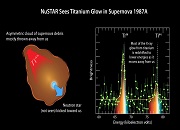 | Asymmetric explosion of SN1987A from 44Ti emission lines revealed with NuSTAR The NASA's high-energy X-ray observatory Nuclear Spectroscopic Telescope Array (NuSTAR) observations of the supernova 1987A (SN1987A) allowed to resolve the 67.87 and 78.32 kiloelectron volt emission lines from decay of 44Ti produced in the supernova explosion. NuSTAR data showed that these two lines are narrow and redshifted with a Doppler velocity of ~700 kilometers per second, probing direct evidence of large-scale asymmetry in the explosion. "Stars are spherical objects, but apparently the process by which they die causes their cores to be turbulent, boiling and sloshing around in the seconds before their demise," said Steve Boggs of the University of California, Berkeley, lead author of a new study on the findings, appearing in the May 8 issue of Science. "We are learning that this sloshing leads to asymmetrical explosions." "Titanium is produced in the very heart of the explosion, so it traces the shape of the engine driving the disassembly of the star," said Fiona Harrison, the principal investigator of NuSTAR at the California Institute of Technology in Pasadena. "By looking at the shift of the energy of the X-rays coming from titanium, the NuSTAR data revealed that, surprisingly, most of the material is moving away from us." Last year, NuSTAR created detailed 44Ti maps of another supernova remnant, called Cassiopeia A, also finding evidence of an asymmetrical explosion, though not to as great an extent as in 1987A. Together, these results suggest that lopsidedness is at the very root of core-collapse supernova. NuSTAR brought a new tool to the study of supernovae. Thanks to the observatory's sharp high-energy X-ray vision, it has made the most precise measurements of 44Ti yet. This radioactive material is produced at the core of a supernova, so it provides astronomers with a direct probe into the mechanisms of a detonating star. The Italian participation to NuSTAR includes the provision of the Malindi ground station (ASI), the ASI Science Data Center (ASDC), which contributes with the development of the NuSTARDAS software package and hosting an official mirror of the NuSTAR scientific public data archive, and a team of scientists of the Istituto Nazionale di Astrofisica (INAF) that actively collaborates on the primary scientific mission goals. The NuSTAR team at ASDC is composed by M. Perri (INAF archive scientist), S. Puccetti (INAF archive scientist) and P. Giommi (ASDC Responsible). For more details on NuSTAR, see: https://nustar.ssdc.asi.it http://www.nustar.caltech.edu 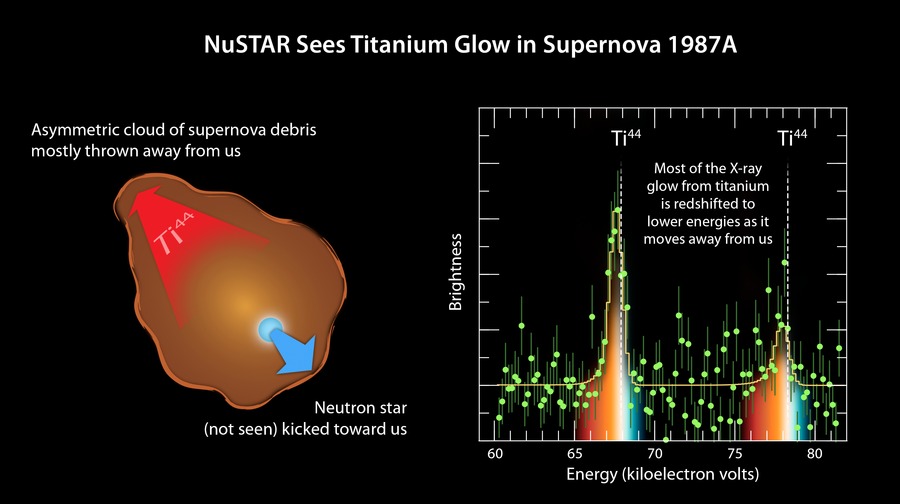 Right: 59-80 keV NuSTAR spectrum of SN1987A with detected 44Ti emission lines. The observations indicate that supernovae belonging to a class called Type II or core-collapse blast apart in a lopsided fashion, with the core of the star hurtling in one direction, and the ejected material mostly expanding the other way (see model diagram at left). [Credit: NASA/JPL-Caltech/UC Berkeley] |
Apr 15, 2015 | April 15-17: AMS Days at CERN New results from AMS-02 are presented at CERN at the tree days event organized by the collaboration. The event has been organized to understand the interrelation between AMS results and those of other major cosmic rays experiments and current theories. Link to the original press release: http://press.web.cern.ch/sites/press.web.cern.ch/files/file/press/2015/04/pr05.15e_ams_days_results.pdf The "AMS Days" can be followed live: https://webcast.web.cern.ch/webcast/play.php?event=381134 The program of the event: https://indico.cern.ch/event/381134/timetable/#20150415 |
Mar 31, 2015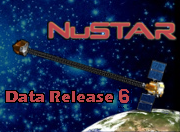 | NuSTAR 6th Data Release at ASDC The NuSTAR 6th Data Release is available from March 31, 2015 at ASDC. This new release contains 679 new data sets observed up to July 31, 2014. All the NuSTAR public data at ASDC are fully integrated in the ASDC Multi-Mission Interactive Archive (MMIA). Through the MMIA the user can perform on-line analysis of all NuSTAR public observations, without the need to download any software, including the extraction of high-level scientific products (cleaned event files, sky images, energy spectra, light-curves, ARFs and RMFs). For more details on NuSTAR, see: https://nustar.ssdc.asi.it/ http://www.nustar.caltech.edu/ http://heasarc.gsfc.nasa.gov/docs/nustar/ |
Feb 06, 2015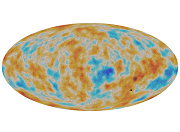 | Planck 2015 release of data products and scientific papers: cosmic reionisation and first stars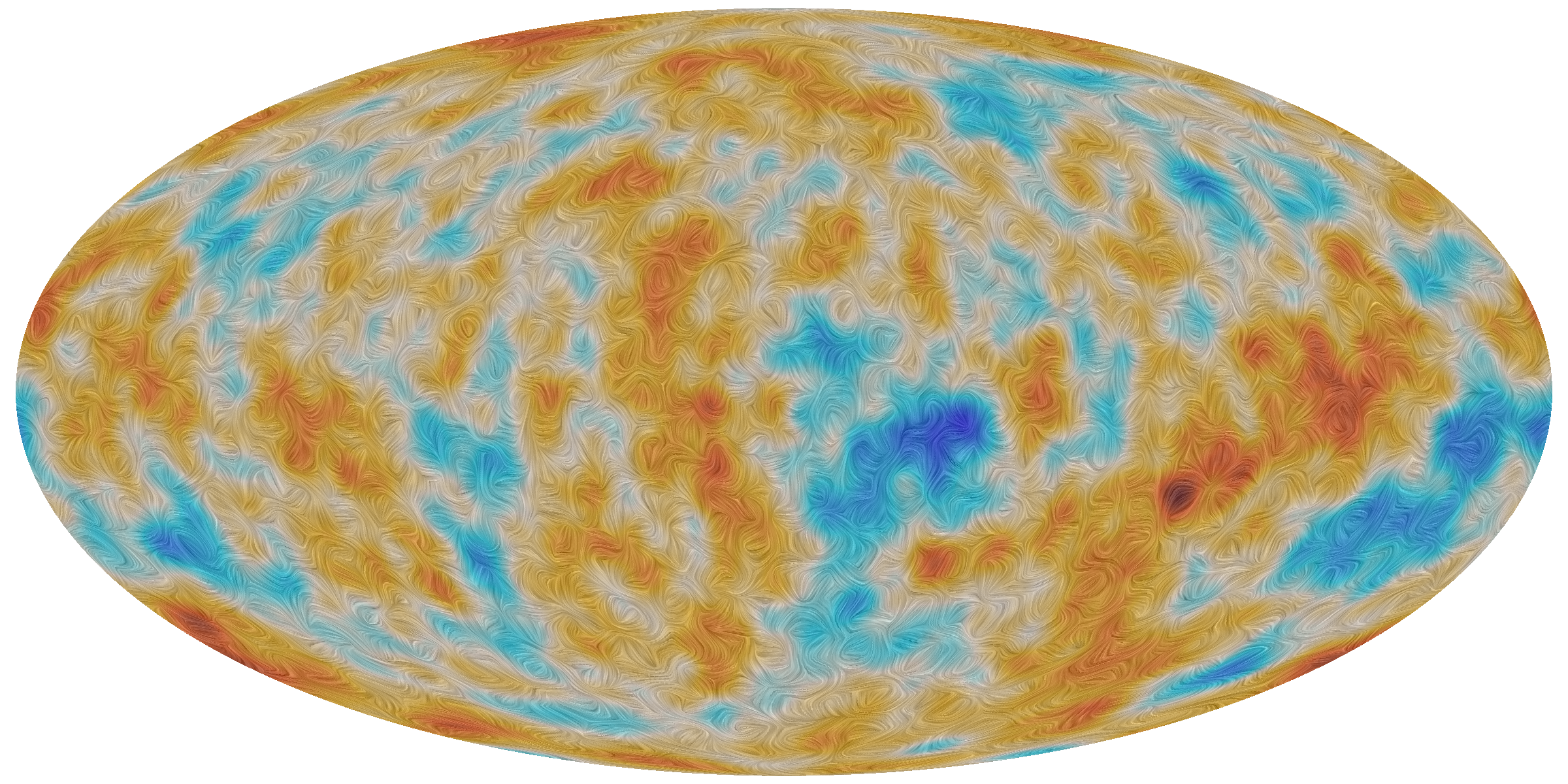 Map of the Cosmic Microwave Background polarisation at large angular scales. Colours represent temperature anisotropies, while textures indicate polarisation direction. [Credit: ESA/Planck Collaboration] On February 5, 2015, the Planck Collaboration released a new set of data products and scientific papers. New results are based on all the data collected throughout the mission, between 2009 and 2013. In addition to the intensity maps at all nine frequency bands observed by Planck, polarisation maps at four frequencies (30, 44, 70, and 353 GHz) are being released. Planck polarisation data not only provides an independent confirmation of the basic cosmological picture drawn using CMB intensity from both 2013 and 2015 maps. In fact, studying the properties of CMB polarisation at large angular scales, Planck scientists concluded that the reionisation of the Universe due to first stars happened 550 million years after the Big Bang, more than 100 million years later than previously thought. So, the Dark Ages of the Universe ended later. This is of fundamental importance because that 100 million years difference is significantly reducing the tension between CMB results and current knowledge of first stars and early galaxies. Polarisation doesn't mean only reionisation. Indeed, by analysing polarised maps at different frequencies, Planck scientists obtained new insights on the properties of the Galactic magnetic field. Planck's new findings include also neutrino physics and dark matter annihilation. The whole list of Planck scientific results is much longer, as described in the papers that are available on ESA website. Planck public data products can be accessed through the Planck Legacy Archive. Additional results and products will be released in the forthcoming weeks. For more information, see: The ASDC team working on Planck-LFI consortium includes G. Polenta (archive scientist) and P. Natoli (senior scientist). Planck ERCSC and PCCS source catalogues are available on the ASDC website. |
Feb 03, 2015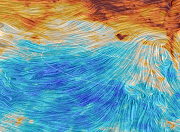 | Results from Planck and BICEP2/Keck Array joint study: no conclusive evidence for primordial gravitational waves On March 2014, the BICEP2 team announced for the first time a significant detection of a B-mode polarisation signal, and this was interpreted as the tiny imprints in the CMB field of the primordial gravitational waves produced during the inflationary epoch 10-34 s after the Big Bang. However, some concerns about the cosmological origin of the detected signal were raised by the scientific community, as the instrument was observing at only one frequency band thus preventing to separate contributions from the Early and the local Universe. Doubts strengthened even more in September 2014, when the Planck Collaboration published the results from a study of the polarised emission of the interstellar dust at high galactic latitudes, including also the region of the sky observed by the BICEP2 telescope. Scientists therefore decided to join forces to take advantage of both the outstanding sensitivity of BICEP2/Keck Array and the wide frequency coverage of the Planck satellite. On January 30, 2015, the results from the joint analysis of data from Planck, BICEP2, and Keck Array experiments were published, showing no evidence for a significant detection of primordial gravitational waves. In fact, when accounting for the contribution of polarised emission produced by the interstellar dust in the Milky Way, there is no statistical evidence for the presence of primordial gravitational waves signatures in the BICEP2 and Keck Array data. However, inflation is not ruled out by the new results as gravitational waves might still be hiding deeper into the data: the quest for CMB B-mode polarisation is not over. For more information, see: The ASDC team working on Planck-LFI consortium includes G. Polenta (archive scientist) and P. Natoli (senior scientist). Planck ERCSC and PCCS source catalogues are available on the ASDC website. 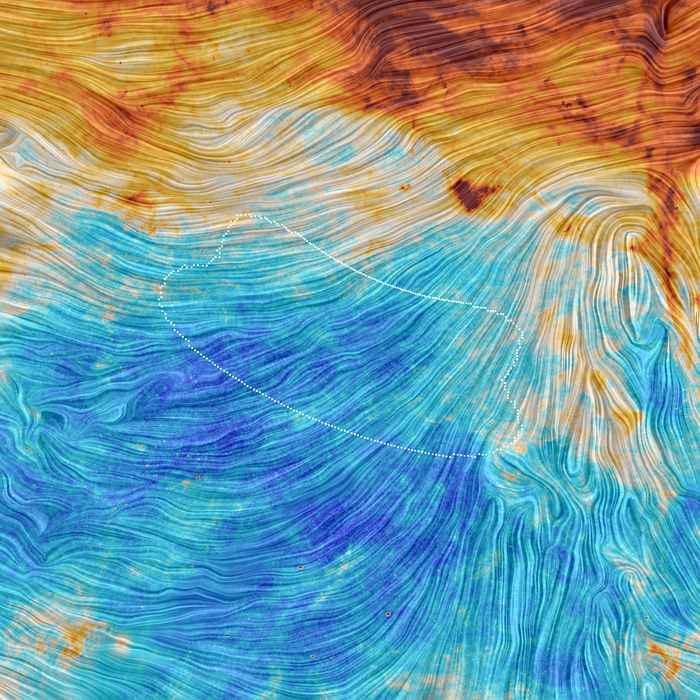 Planck view of the submillimiter sky in the BICEP2 region. The colour scale represents the interstellar dust emission, while textures indicates the orientation of the Galactic magnetic field as derived from interstellar dust polarisation. The highlighted area shows the region observed by BICEP2 and the Keck Array. [Image - Credit: ESA/Planck Collaboration] |
Jan 20, 2015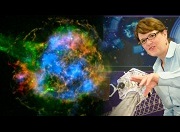 | NuSTAR Principal Investigator receives the 2015 Bruno Rossi Prize We are pleased to report that the 2015 Bruno Rossi Prize of the High Energy Astrophysics Division (HEAD) of the American Astronomical Society has been awarded to the NuSTAR Principal Investigator Fiona Harrison for her "groundbreaking work on supernova remnants, neutron stars and black holes enabled by NuSTAR, the first satellite to focus X-rays at energies above 10 kiloelectron volts (keV)." The citation for the Rossi Prize, the top prize in high-energy astrophysics, notes that Harrison's "assembly and leadership of the extraordinary NuSTAR team has opened a new window on the Universe." "The exciting scientific results from NuSTAR are the culmination of close to two decades of work by a talented and dedicated team," said Harrison. "It is a privilege to work with them, and an honor to be recognized through the Rossi Prize." NuSTAR (Nuclear Spectroscopic Telescope Array) was launched in June 2012 under NASA's Small Explorer program. The primary science objectives are the study of the hottest, densest and most energetic phenomena in the universe, including the physics of massive black holes and collapsed stars, the explosion dynamics and nucleosynthesis in supernovae, and the particle acceleration in relativistic jets in Active Galactic Nuclei. The Italian participation to NuSTAR includes a) the provision of the Malindi ground station (ASI), b) the support of the ASI Science Data Center (ASDC), which has developed and maintains the NuSTARDAS data analysis software package and hosts an official mirror of the NuSTAR scientific data archive, and c) a team of scientists of the Istituto Nazionale di Astrofisica (INAF) and of Italian Universities to collaborate on the primary scientific mission goals. This is the fifth time that a space mission for which the ASDC plays an important role has been awarded a Rossi Prize, after BeppoSAX in 1998, Swift in 2007, Fermi in 2011 and AGILE in 2012. 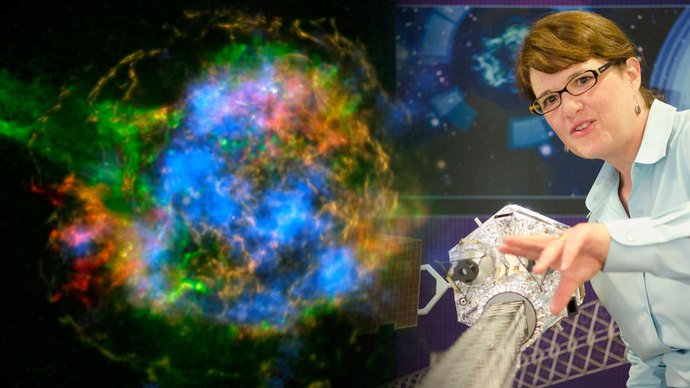 Fiona A. Harrison, Benjamin M. Rosen Professor of Physics at Caltech. Credit: Lance Hayashida/Caltech |
Sep 23, 2014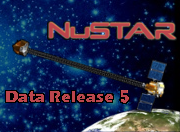 | NuSTAR 5th Data Release at ASDC The NuSTAR 5th Data Release is available from September 23, 2014 at ASDC. This new release contains 214 new data sets of 28 distinct targets observed up to June 30, 2014, including all the calibration observations of the Crab. All the NuSTAR public data at ASDC are fully integrated in the ASDC Multi-Mission Interactive Archive (MMIA). Through the MMIA the user can perform on-line analysis of all NuSTAR public observations, without the need to download any software, including the extraction of high-level scientific products (cleaned event files, sky images, energy spectra, light-curves, ARFs and RMFs). For more details on NuSTAR, see: https://nustar.ssdc.asi.it/ http://www.nustar.caltech.edu/ http://heasarc.gsfc.nasa.gov/docs/nustar/ |
Sep 19, 2014 | Latest AMS-02 Results published on PRL After one year of intensive analysis the AMS-02 Collaboration has released the long-awaited extended results on the positron fraction and a new measurement of the electron and positron fluxes up to unprecedented energies.These results provide new insights into the nature of the mysterious excess of positrons observed in the flux of cosmic rays and were presented in a conference at CERN by the AMS02 spokesperson, the Nobel laureate professor Samuel Ting, on September 18th, just before their publication in the Physics Review Letters Journal.41 billion primary cosmic ray events have been analyzed among which almost 10 million have been identified as electrons and positrons. The energy at which the positron fraction ceases to increase has been measured to be 275+/-32 GeV and the distribution of these events shows no preferred incoming direction from space. Between 20 and 200 GeV, the rate of change of the positron flux is surprisingly higher than that for electrons. This is important proof that the excess seen in the positron fraction is due to a relative excess of high-energy positrons, and not the loss of high-energy electrons.Data are already available for download on the ASDC Cosmic Rays Database. PRL Publications: "High Statistics Measurement of the Positron Fraction in Primary Cosmic Rays of 0.5500 GeV with the Alpha Magnetic Spectrometer on the International Space Station" 10.1103/PhysRevLett.113.121101 "Electron and Positron Fluxes in Primary Cosmic Rays Measured with the Alpha Magnetic Spectrometer on the International Space Station" 10.1103/PhysRevLett.113.121102 CERN press release INFN press release (italian) Webcast of the seminar at CERN 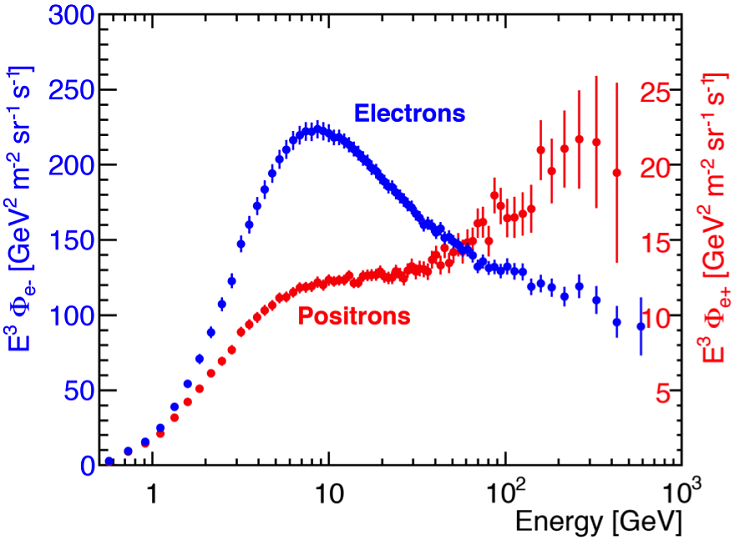 |
Jun 26, 2014 | Paolo Giommi in the list of 2014 World's most influential scientific minds We are pleased to announce that the head of ASDC, Paolo Giommi is included in the list of "2014 World's most influential scientific minds", recently issued by Thomson Reuters. For more information see the list of HighlyCited researchers or the report on this event on the ASI official web pages. |
May 07, 2014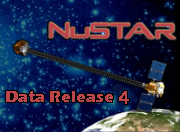 | NuSTAR 4th Data Release at ASDC The NuSTAR 4th Data Release is available from May 7, 2014 at ASDC. This new release contains 163 new data sets of 26 distinct targets observed up to December 31, 2013. All the NuSTAR public data at ASDC are fully integrated in the ASDC Multi-Mission Interactive Archive (MMIA). Through the MMIA the user can perform on-line analysis of all NuSTAR public observations, without the need to download any software, including the extraction of high-level scientific products (cleaned event files, sky images, energy spectra, light-curves, ARFs and RMFs). For more details on NuSTAR, see: https://nustar.ssdc.asi.it/ http://www.nustar.caltech.edu/ http://heasarc.gsfc.nasa.gov/docs/nustar/ |
Mar 26, 2014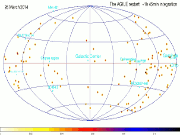 | AGILE mission operations extended by ASI for another year After a 3-month 'stand-by' period, during which the AGILE scientific observations were suspended, today the satellite started to look at the gamma-ray sky again. Following the positive evaluation of the scientific results in its first 6 years of operations, and the still nominal status, as evaluated by the AGILE Mission Board, the Italian Space Agency decided to extend the operations of AGILE for additional 12 months. The animation below shows the first day of data acquisition after the operations restart. A petition supporting the protraction of the AGILE Mission was started autonomously by a Princeton physicist, Franco Paoletti and by Bruno Coppi, Prof. Emeritus at MIT, working in the area of Plasma Physics. The third signature is the one of the Nobel Prize Russell Hulse, discoverer of the first binary pulsar. Their interest in the AGILE Mission stems from the discovery of the variability of the Crab Nebula in gamma-rays, which earned the 2012 Bruno Rossi Prize to Marco Tavani and the AGILE team. As of today the petition reached almost 500 signatures from all over the world. A manifestation of interest and a strong support letter was also sent to ASI by the Terrestrial atmospheric science community, interested in the unique contribution that AGILE is giving to the science of Terrestrial Gamma Ray Flashes (TGF). The first scientific data after the restart has been successfully received and processed today at the AGILE Data Center at ASDC. 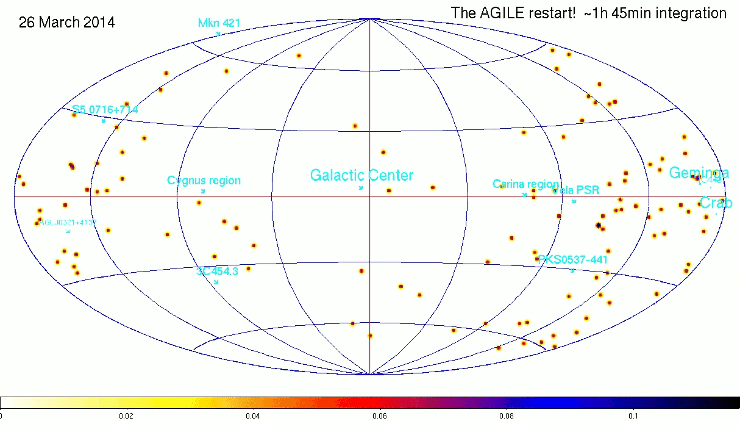 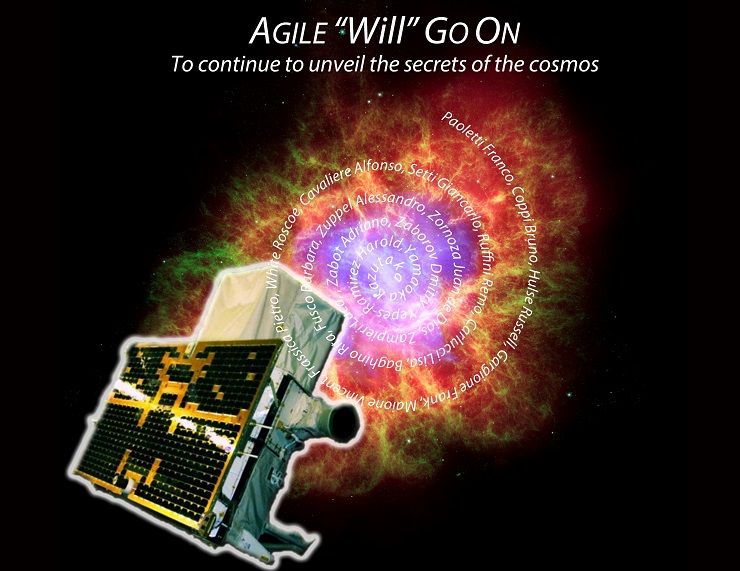 Thank to the hundreds of supporters that signed the petition "AGILE Must Go On". Click here to access the current list of signatures |
Feb 21, 2014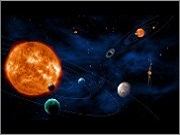 | PLATO selected by ESA! On February 19 ESA announced PLATO 2.0 (PLAnetary Transits and Oscillations of stars) was selected for the M3 slot in the ESA's cosmic vision program. PLATO 2.0 launch is foreseen by 2022-2024. The main scientific objective of the mission is the discovery and characterization of extrasolar planetary systems. PLATO 2.0 will observe up to 1,000,000 stars and it will detect and characterize hundreds of small planets, thousands of giant planets, performing for each of them accurate measurements of radius, mass, mean density and age. The final catalog will include Earth-like, potentially habitable planets. The number of stars that Plato can follow is limited by telemetry bandwidth, and it is considerably smaller than the total number of stars in Plato's field of view, therefore the selection of the optimal targets (i.e. the preparation on the Plato Input Catalogue) is a fundamental task for the mission. The Plato Input Catalogue (PIC) will be implemented and managed at the ASI Science Data Center (ASDC), one of the PLATO Data Processing Centres, in close collaboration with the Target/Field Characterization team (leader Professor G. Piotto). For more details: PLATO 2.0 on ESA website: http://sci.esa.int/plato/ Press release ESA: http://sci.esa.int/plato/53707-esa-selects-planet-hunting-plato-mission/ Press release ASI: http://www.asi.it/it/news/l_esa_approva_la_missione_plato/ Press release INAF: http://www.media.inaf.it/2014/02/19/e-lesa-scelse-plato/ 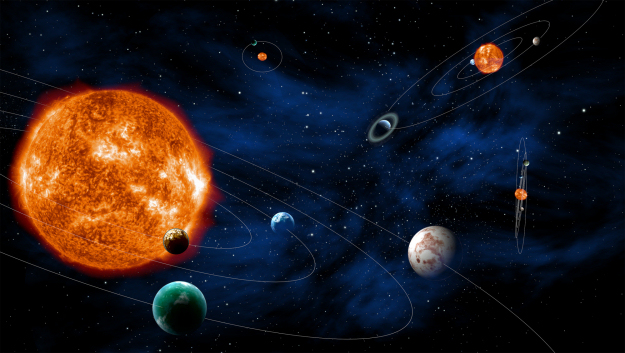 |
Feb 20, 2014 | NuSTAR creates the first map of 44Ti emission in Cassiopeia A The NASA's high-energy X-ray observatory Nuclear Spectroscopic Telescope Array (NuSTAR) has created the first map of radioactive element in the Cassiopeia A (Cas A) supernova remnant. The radioactive element is titanium-44, which has an unstable nucleus produced at the heart of the exploding star. The NuSTAR map of Cas A shows the titanium concentrated in clumps at the remnant's center, strongly suggesting that the exploding star literally sloshed around, re-energizing the stalled shock wave and allowing the star to finally blast off its outer layers. These results have been published in the February 20 issue of Nature. "Stars are spherical balls of gas, and so you might think that when they end their lives and explode, that explosion would look like a uniform ball expanding out with great power," said Fiona Harrison, the principal investigator of NuSTAR at the California Institute of Technology (Caltech) in Pasadena. "Our new results show how the explosion's heart, or engine, is distorted, possibly because the inner regions literally slosh around before detonating." The NuSTAR titanium-44 map also casts doubt on other models of supernova explosions, in which the star is rapidly rotating just before it dies and launches narrow streams of gas that drive the stellar blast. Though imprints of jets have been seen before around Cas A, it was not known if they were triggering the explosion. NuSTAR did not see the titanium, essentially the radioactive ash from the explosion, in narrow regions matching the jets, so the jets were not the explosive trigger. "With NuSTAR we have a new forensic tool to investigate the explosion," said the paper's lead author, Brian Grefenstette of Caltech. "Previously, it was hard to interpret what was going on in Cas A because the material that we could see only glows in X-rays when it's heated up. Now that we can see the radioactive material, which glows in X-rays no matter what, we are getting a more complete picture of what was going on at the core of the explosion." The Italian participation to NuSTAR includes the provision of the Malindi ground station (ASI), the ASI Science Data Center (ASDC), which contributes to the development of the NuSTARDAS software package and will host an official mirror of the NuSTAR scientific data archive, and a team of scientists of the Istituto Nazionale di Astrofisica (INAF) to collaborate on the primary scientific mission goals. The NuSTAR team at ASDC is composed by M. Perri (INAF archive scientist), S. Puccetti (INAF archive scientist) and P. Giommi (ASDC Responsible). For more details on NuSTAR, see: https://nustar.ssdc.asi.it/ http://www.nustar.caltech.edu/ http://heasarc.gsfc.nasa.gov/docs/nustar/ 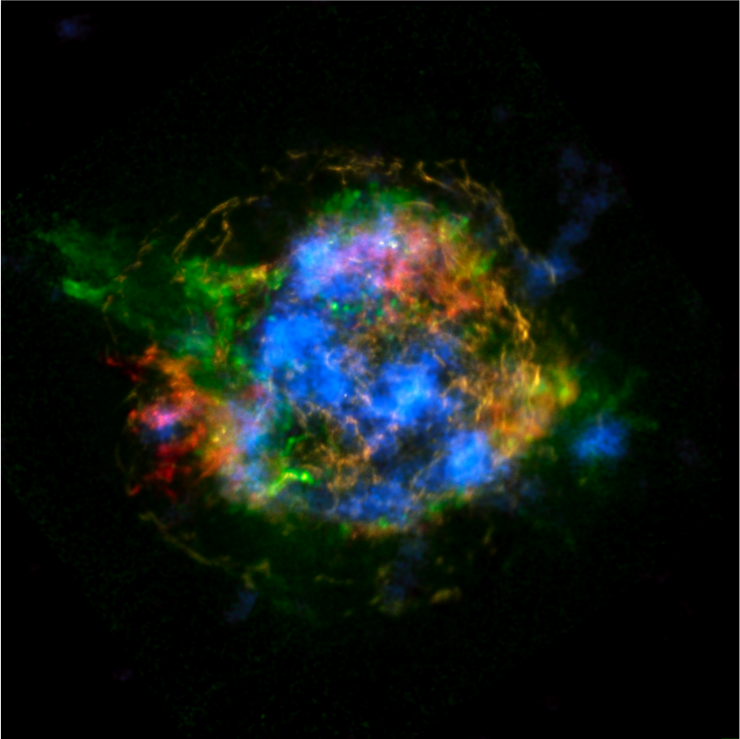 NuSTAR image of the Cas A supernova remnant superimposed with the NASA's Chandra orbiting telescope image. Blue shows NuSTAR's map of the distribution of titanium-44 produced in the core of the explosion 340 years ago, while red and green are X-ray emissions detected by Chandra of heated iron and silicon/magnesium, respectively. Image credit: NASA/JPL-Caltech/CXC/SAO. |
Feb 06, 2014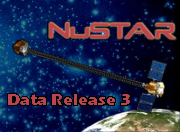 | NuSTAR 3rd Data Release at ASDC The NuSTAR 3rd Data Release is available from February 6, 2014 at ASDC. This new release contains 104 new data sets of 21 distinct targets observed up to June 30, 2013. All the NuSTAR public data at ASDC are fully integrated in the ASDC Multi-Mission Interactive Archive (MMIA). Through the MMIA the user can perform on-line analysis of all NuSTAR public observations, without the need to download any software, including the extraction of high-level scientific products (cleaned event files, sky images, energy spectra, light-curves, ARFs and RMFs). A new version of the NuSTAR Data Analysis Software (NuSTARDAS v.1.3.1, developed by ASDC in collaboration with Caltech) is available within the new release of the HEASARC's HEASoft multi-mission software (v.6.15.1). An updated version (v.1.5) of the NuSTARDAS data analysis software guide is also available. For more details on NuSTAR, see: https://nustar.ssdc.asi.it/ http://www.nustar.caltech.edu/ http://heasarc.gsfc.nasa.gov/docs/nustar/ |
Dec 19, 2013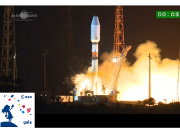 | Gaia launched! On 19 December 2013 09:12 GMT (10:12 CET) Gaia lifted off on a Soyuz rocket from the ESA Spaceport in Kourou, French Guiana, and is now travelling to L2. Up there 1 billion stars (in the Galaxy and beyond) wait to be observed by the satellite and their brightness, positions, motion, distance and astrophysical characteristics to be measured, to produce the richest 3D map of the sky ever realized. We are eager to see the expected and, even more, the unexpected results that Gaia will produce. Gaia will provide the detailed 3D distributions and space motions of a billion stars, brighter than 20th magnitude. The astrometric precision, reaching a few millionths of an arcsecond, will be unprecedented. This will allow our Galaxy to be mapped, for the first time, in three dimensions. Ten million stars will be measured with a distance accuracy of better than 1 percent and a 150 million to better than 10 percent. Compared to Hipparcos, Gaia will improve parallax and proper-motion accuracy by almost 100 times and the number of stars observed by 10 000 times. In addition it will measure radial velocities and spectrophotometry for the sources. Gaia will survey a vast population of solar system bodies (major planets, natural satellites, comets, and asteroids, including several thousands of near-Earth objects) and extragalactic objects (half a million quasars and thousands of supernovae). In addressing all these fields, Gaia will cover a significant part of modern astrophysics. The Gaia catalogue will be one of the largest and richest astronomical catalogue ever realized. The ASDC (ASI Science Data Center) coordinates the Italian contribution to DPAC-CU9, the coordination unit responsible for the realization of the Catalogue and for the release of the Gaia data. In the framework of a wide international collaboration, ASDC will host a copy of the Gaia catalogue and will contribute to CU9 activities. ASDC is responsible in CU9 for the cross-match of the Gaia catalogue with the largest public available optical and near-IR catalogues, as well as several other catalogues from radio to gamma-ray, ensuring an all-sky, multi-wavelength and multi-color vision of the Galaxy. In addition, ASDC is developing access and data mining tools to enable the astronomical community to handle and fully exploit the scientific potential of this enormous archive. In addition, ASDC is building the archive and database which will host the Gaia ancillary data obtained by the Italian teams involved in the project. This archive will include the measurements, observations and simulations needed for the absolute calibration of the Gaia spectro-photometric data. The archive is helping the work of the calibration team and will then be public. Finally ASDC is involved in DPAC-CU5 (responsible for the spectro-photometric data analysis and reduction) activities, namely the realization of the crowded fields analysis software and the data reduction of the photometric data needed for the validation of the Gaia spectro-photometric standards. ASI press release : http://www.asi.it/it/news/al_via_la_missione_gaia INAF press release : http://www.media.inaf.it/2013/12/19/gaia-appuntamento-con-la-storia/ ESA press release : http://www.esa.int/Our_Activities/Space_Science/Gaia/Liftoff_for_ESA_s_billion-star_surveyor |
Nov 25, 2013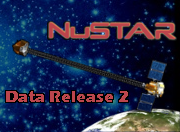 | NuSTAR 2nd Data Release at ASDC The NuSTAR 2nd Data Release is available from November 25, 2013 at ASDC. This new release contains 72 new data sets of 15 distinct targets observed up to December 31, 2012. The total exposure time of this new data release is 538 ks. We are pleased to announce that all the NuSTAR public data at ASDC are now fully integrated in the ASDC Multi-Mission Interactive Archive (MMIA). Through the MMIA the user can perform on-line analysis of all NuSTAR public observations, without the need to download any software, including the extraction of high-level scientific products (cleaned event files, sky images, energy spectra, light-curves, ARFs and RMFs). A new version of the NuSTAR Data Analysis Software (NuSTARDAS v.1.3.0, developed by ASDC in collaboration with Caltech) is available within the new release of the HEASARC's HEASoft multi-mission software (v.6.15). An updated version of the NuSTARDAS data analysis software guide is also available. For more details on NuSTAR, see: https://nustar.ssdc.asi.it/ http://www.nustar.caltech.edu/ http://heasarc.gsfc.nasa.gov/docs/nustar/ |
Nov 20, 2013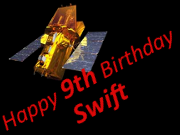 | Happy 9th Birthday Swift! 20 November 2004 - 20 November 2013 : Happy 9th Birthday Swift! |
Nov 12, 2013 | GRB 131108A in gamma-rays GRB 131108A, bright but relatively soft in gamma-rays, triggered onboard Fermi-LAT (GCN #15464), and transited in the field of view of AGILE approximately between -20 and +150 seconds from the trigger (t0 = 20:41:55 UT) (GCN #15479). A preliminary reduction of the optical afterglow spectrum indicates a GRB redshift of z=2.40 (GCN #15470). This is the first onboard Fermi-LAT trigger since 2009, indicating a potentially rare and interesting event. The autonomous repoint of the Fermi spacecraft of 9ksec was followed by a ToO pointed observation until about 23:11 UT of November 9, 2013. The Fermi LAT data flow and quality monitor during this exciting GRB was followed by a duty shifter scientist of ASDC. A preliminary analysis of the AGILE Gamma-Ray Imaging Detector (GRID) data in temporal and spatial coincidence with the GRB shows a significant excess of gamma-ray events above 30 MeV at the location of the event. AGILE-GRID detected more than 65 photons compatible with the GRB location in the anticygnus region, most of which below 100 MeV, corresponding to a fluence of 2.56 +- 0.32 1e-5 erg / cm^2 in the energy band 30 MeV - 1 GeV, in which AGILE has a competitive sensitivity. The AGILE-GRID image of GRB 131108A, one of the most interesting GRB events seen by AGILE after 6 years of observations, is shown in the figure below. 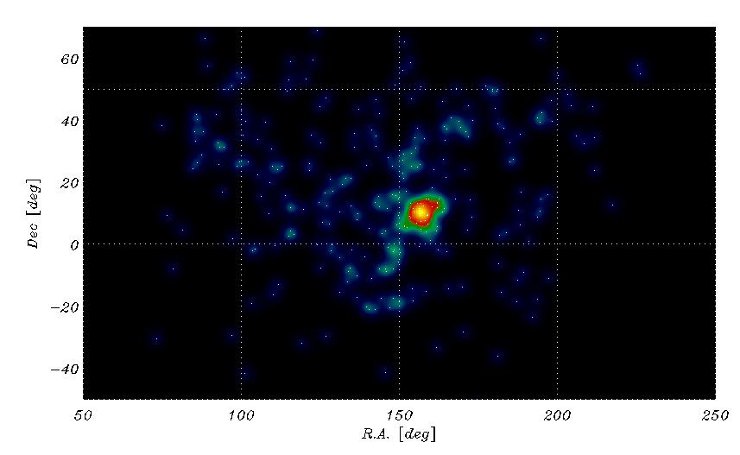 Image: AGILE-GRID view of GRB 131108A , credits AGILE Team. |
Oct 23, 2013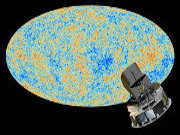 | Farewell Planck ESA's Planck satellite has been turned off on October 23, 2013, after 4.5 years of operations. Planck was launched on May 14, 2009, and has started it scientific observations on August 14, 2009. Planck's High Frequency Instrument ended its science operations on January 2012, after completing five all-sky surveys. The Low Frequency Instrument has been observing until October 3, 2013, totalising eight all-sky surveys of the microwave sky. The end of Planck operations started on August 14, 2013, when a departure manoeuvre from L2 was executed to inject the spacecraft into a parking orbit. Decommissioning activities have started on October 4 after the LFI observed the Crab Nebula for the last time. On October 19, the two instruments and the sorption cooler were switched-off. On 21 October, Planck fired its thrusters for the last time to ensure the long-term stable parking orbit is maintained. Finally, on 23 October 2013 the satellite has been turned off. Although science observations are now over, the legacy of the Planck mission will continue. In fact, last March the Planck consortium released intensity data collected during the first 15.5 months of observations summarised into the most detailed all-sky image of the cosmic microwave background. Implications for cosmology and inflationary theories were derived producing a new cosmic recipe, together with interesting results in other fields of galactic and extragalactic astrophysics. Next year, Planck is expected to start displaying its full potential by analysing all the data collected throughout the mission: 30 months of joint HFI and LFI observations plus 18 months of LFI only, and the long awaited CMB polarisation which could probe the foundation of the inflationary paradigm if the tiny imprint left by primordial gravitational waves on the CMB will be detected. Thanks to its amazing quality, Planck data has already began to make new questions arising and it will play a key role in helping scientists to find the answer: the legacy of the Planck mission lives on. Public Planck data will also be available through the ASDC multi-frequency interactive archive. For more information, see ESA press release ASI website INAF website 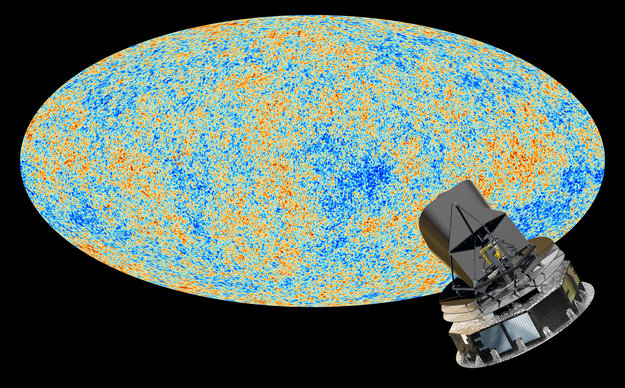 Image: credits ESA, LFI and HFI consortia |
Aug 30, 2013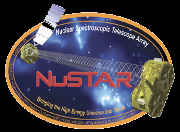 | NUSTAR ARCHIVE OPENING AT ASDC The NuSTAR data archive at the ASDC opened today, Aug 30, 2013, with an initial sample of 29 data sets from observations of a variety of objects. More data will be public in the coming months. The NuSTAR data analysis software ('nustardas', written by ASDC in collaboration with Caltech personnel) is available as a new sub-package in the HEASARC's FTOOLS/HEASoft multi-mission software as of the last release (FTOOLS v.6.14, 7 August 2013). Data analysis software guide is also available. For more details on NuSTAR, see https://nustar.ssdc.asi.it/ http://www.nustar.caltech.edu/ http://heasarc.gsfc.nasa.gov/docs/nustar/ |
Jun 13, 2013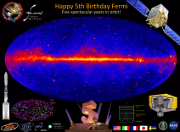 | Happy Fifth Birthday to Fermi. Five spectacular years in orbit! From the Fermi LAT Project Scientist Julie McEnery: "June 11, 2013 and 5 years since the launch of of GLAST, which was renamed Fermi shortly afterward. It has been a spectacular success and incredible journey across the high-energy Universe with Fermi. In the past five years, 1130 refereed papers have used Fermi data or results, with a cumulative 26038 citations. The three most-cited are the LAT instrument paper, the first electron spectrum paper, and the first LAT source catalog. In addition to writing lots of papers, we are using Fermi data to produce important, high impact papers. Ranked by citation count in astrophysics, Fermi papers (sometimes several) are in the top 10 in 2009, 2010, and 2012. Fermi results are clearly having a significant impact. Many of these published results are made possible with data (and the work of scientists) from different wavebands. Among many examples, the Pulsar Search Consortium has timed over 700 pulsars in support of Fermi. Swift has followed up with X-ray and UV observations of hundreds of LAT flaring sources and dozens of LAT GRBs. Hundreds of Fermi-LAT sources are monitored in radio, X-ray and optical wavebands (see http://fermi.gsfc.nasa.gov/ssc/observations/multi/programs.html). These results have been widely disseminated to the public. In addition to many press releases by university and international partners, NASA has supported 5 media telecons, 22 press releases and 15 features. These stories have been accompanied by 39 videos and supporting animations, which have had enthusiastic reception. In 2012 alone, the first year for which we have a report from the NASA Goddard Scientific Visualization Services server, Fermi videos exceeded 3.4 million views, with many, many more views via YouTube. Among the most popular are: Einstein's Cosmic Speed Limit: http://svs.gsfc.nasa.gov/vis/a010000/a010500/a010510/index.html Terrestrial Gamma-ray Flashes Create Antimatter, http://www.youtube.com/watch?v=lXKt7UVjd-I&list=PL9900C9C6BBDA9551&ind Fermi discovers giant gamma-ray bubbles in the Milky Way http://svs.gsfc.nasa.gov/vis/a010000/a010600/a010688/index.html The spectacular work with Fermi has been noted by our peers in the science community. Scientists working with Fermi, and the Fermi Large Area Telescope team have received several prominent awards: the Bruno Rossi prize (twice), the Warner prize, the Panofsky prize and the Duggal Prize (also twice). The LAT stands on the eve of 300 billion LAT event triggers (299,864,708,616 as of 15:13 UTC today). The LAT Instrument Science Operations Center (ISOC) have used 1200 CPU-years to process over 2 PB of data; an additional 1700 CPU-years have been devoted to Monte Carlo simulations to support understanding of the performance of the LAT and the LAT data. The ISOC has sent 1,789,794,674 events to the FSSC of which 268,324,179 are in the photon database (the remainder are in the extended database). The Fermi Science Support Center (FSSC) at GSFC have served about 20 TB of LAT data for a total of 159,879 queries, in addition to a large number of direct downloads of the weekly data files. For the GBM, over 67 TB of data have been downloaded by the GRB and Solar communities. In addition to serving data, the FSSC have worked to ensure that people are able to fully use them. The FSSC have answered over 2400 requests to the Fermi Helpdesk and participated in 23 analysis workshops and schools in 15 different institutions in 11 cities and 3 countries. This is a lower limit thanks to additional externally-hosted workshops run by instrument team members. Participation in Fermi by the scientific community has steadily grown since launch. To date, 1269 individual guest investigators have participated in the six cycles of the Fermi Guest Investigator program. This is a lower limit on the number of scientists using Fermi data, as many additional people are supported by agencies in other countries. Fermi of course has made lots and lots of observations. While collecting high quality science data, the spacecraft has spent 96% of its observing time in survey mode, 3% in pointed mode, and the remainder in maneuver mode. Fermi has made over 90 autonomous repoints, 31 nadir observations and 12 targeted observations at 8 objects (3 with modified rocking: PSR B1259, the Sun, and Mrk 421; and 9 pointed mode observations: Sun, Crab nebula, Cyg X-3, 3C 454.3, Galactic Center, and S3 0218+35). The GBM have triggered onboard on 1151 GRB, 370 TGF, 522 solar flares and 192 magnetar outbursts. Many additional gamma-ray transients have been found in searches of the downlinked data, especially after we transitioned to routinely collecting higher time-resolution GBM data in July 2010. The LAT monitored source list now numbers 105 sources, with publicly-available lightcurves for each. The LAT Flare Advocates have written 207 Fermi-sky blog entries (http://fermisky.blogspot.com/), and written 239 LAT ATels (https://www-glast.stanford.edu/cgi-bin/pub_rapid/) since July 24, 2008. Not to be outdone on the communications front, the Flight Operations Team have generated over 3000 presentations for weekly and quarterly status meetings and the ISOC have written many weekly entries in the LAT diary. Most importantly, over 100 students have written a thesis based on Fermi data. It's also important to continue to have a functioning observatory to work with, to that end in the 27537 orbits of Fermi the Fermi observatory the FOT have sent 10206 commands to the observatory and scheduled 18877 KU contacts to downlink the science data. We have had one collision avoidance maneuver (successful!), and one successful mission extension, hopefully the first of many. Starting the sixth year of the Fermi mission, the spacecraft and instruments are continuing to work well, the scientific output from the mission is continuing to increase. We cannot predict the discoveries to come, but we can look forward to them." All of the achievements have been made possible by the hard work of a worldwide Fermi community and with the support of the National Aeronautics and Space Administration (NASA) and the Department of Energy (DoE) in United States and agencies in France, Germany, Italy, Japan, and Sweden. The Fermi LAT collaboration in particular is supported in both the development and the operation of the LAT as well as scientific data analysis by NASA and DoeE in USA, the Commissariat à l'Energie Atomique and the Centre National de la Recherche Scientifique / Institut National de Physique Nucléaire et de Physique des Particules in France, the Agenzia Spaziale Italiana (ASI) and the Istituto Nazionale di Fisica Nucleare in Italy, the Ministry of Education, Culture, Sports, Science and Technology (MEXT), High Energy Accelerator Research Organization (KEK) and Japan Aerospace Exploration Agency (JAXA) in Japan, and the K.A. Wallenberg Foundation, the Swedish Research Council and the Swedish National Space Board in Sweden. Additional support for science analysis during the operations phase is gratefully acknowledged from the Istituto Nazionale di Astrofisica (INAF) in Italy and the Centre National d' 'Etudes Spatiales in France. The ASI Science Data Center (ASDC) is contributing to the Fermi mission by maintaining a mirror archive of the LAT high-level science data, now loaded with Pass7 class events and holding about 268 million of gamma-ray photons collected between August 4, 2008 and June 11, 2013. ASDC is contributing to the Fermi mission in development of quick-look analysis software, interactive data exploration and analysis interfaces through online web tools, software support for publication and maintaining of gamma-ray source catalogs and LAT science data distribution, and providing support to users for data reduction methods and analysis. The Fermi team at ASDC is involved in technical and science activities within AGN, GRB, and Catalogs LAT science groups, participating in LAT catalog releases, source identification analysis, in exploitation of LAT data in connection to multi-mission archives also collecting and analyzing multifrequency data, and performing source population studies, and spectral and temporal variability analysis. The participation to the distinct LAT instrument and science duty service shifts, the set of new international collaborations and the communication of analysis result, the support in organization of events and conferences and public outreach activities are also tasks of the Fermi team at ASDC. 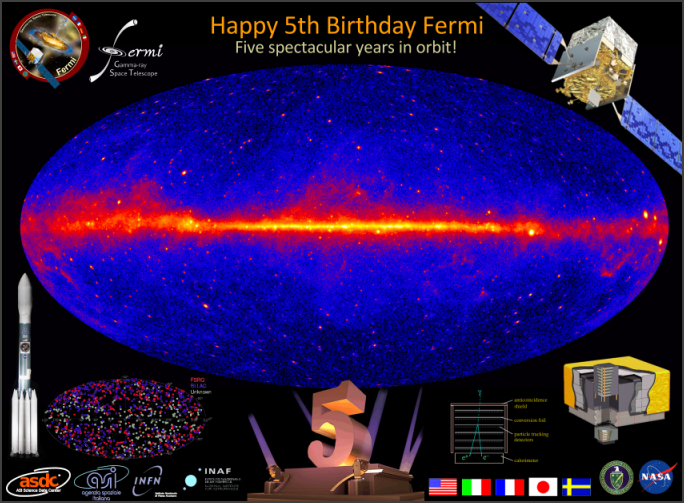 Links: Fermi ASDC site: http://fermi.asdc.asi.it Fermi ASI page: http://www.asi.it/en/activity/high_energy/glastfermi http://www.asi.it/it/attivita/astrofisica/fermiglast Fermi NASA official site: http://fermi.gsfc.nasa.gov/ Fermi Science Support Center (FSSC) site: http://fermi.gsfc.nasa.gov/ssc/ Fermi NASA mission site: http://www.nasa.gov/fermi/ Fermi Large Area Telescope (LAT) instrument and collaboration page: http://www-glast.stanford.edu/ Fermi Gamma-ray Burst Monitor (GBM) instrument and collaboration page: http://gammaray.msfc.nasa.gov/gbm/ Fermi Education and Public Outreach site: http://fermi.sonoma.edu/ Fermi LAT Instrument Science Operations Center (ISOC): http://glast-isoc.slac.stanford.edu Fermi LAT project site: http://www-glast.slac.stanford.edu/ |
Apr 08, 2013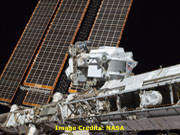 | First results from the AMS-02 experiment: on the cover of Physics Review Letter ! On April 3rd, the AMS-02 collaboration has released the first results on the precise measurement of the positron fraction in the cosmic rays at energies up to 350 GeV. The AMS-02 spokesperson, the Nobel laureate professor Samuel Ting, discussed the new results in a public seminar at CERN and at the same time they were published on Physical Review Letter, selected for a Viewpoint in Physics and an Editors' Suggestion. Since its installation on 2011 May 19 aboard the main truss of the International Space Station (ISS), the AMS Experiment is the largest and most sensitive magnetic spectrometer ever deployed in space. 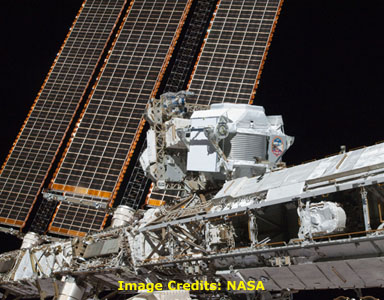 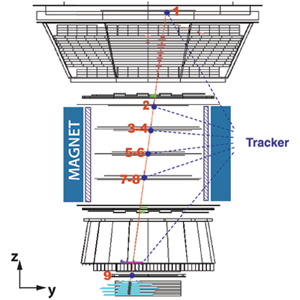 With a total weight of 7.5 Tons, AMS-02 is composed by an array of precision particle detectors providing redundant measurements of velocity, energy and charge of the cosmic rays impinging in the 0.14 T magnetic field provided by its permanent magnet. Electrons and positrons are identified against the large background of protons by the independent measurements of the Transition Radiation Detector, the Electromagnetic Calorimeter and the Tracker which provide a combined rejection power of ~106 The published measurement has been performed using the statistics collected in the first 18 months of operation. This corresponds to an unprecedented accuracy in the result: more than 25 billions of events were collected by AMS in that period and analyzed to select and unambiguosly identify 6.8 million of electrons in the energy range 0.5 to 350 GeV. Currently, the total number of positrons identified by AMS, in excess of 400,000, is the largest number of energetic antimatter particles directly measured and analyzed from space. Over its long duration mission on the ISS, AMS will record signals from 16 billion cosmic rays every year and transmit them to Earth for scientific analysis. It is expected that hundreds of billions of cosmic rays will be measured by AMS throughout the lifetime of the Space Station 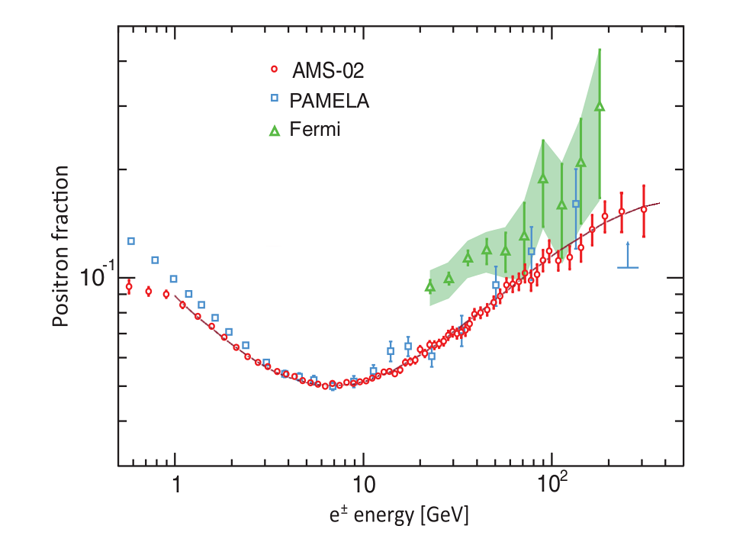 The figure shows the result of the AMS-02 measurement: the excellent energy resolution and the high available statistics clearly distinguish the reported positron fraction spectrum from earlier experiments. This first result confirms the unexplained excess of high-energy positrons in cosmic rays, extending the measurement up to 350 GeV and with an unprecedented precision. The detailed investigation of the rise in the positron fraction is of great physical interest since it could be the signature of Dark Matter annihilation in the galactic halo or could indicate the presence of a relatively near astrophysical positron source. The high statistics of the results allows for the first time detailed investigation of the positron fraction spectra that exhibits no fine-structures nor time dependence, moreover data shows no anisotropy indicating the energetic positrons are not coming from a preferred direction in space. This first result shows that the slope (rate of growth) of the positron fraction decreases by an order of magnitude from 20 to 250 GeV. At energies above 250 GeV, the spectrum appears to flatten but to study the behavior above 250 GeV requires more statistics - the published data represents ~10% of the total expected for AMS-02. Analyzing the positron fraction using a simple phenomenological model (included as continuous line in figure) indicates that the positron fraction spectrum is consistent with electron and positron fluxes, each flux being described by the sum of its diffuse spectrum and a single energetic common source. The volume of reconstructed data (~200 TB/year) requires a massive analysis effort. The parameters of each collected event are reconstructed, characterized and archived before they undergo analysis by independent study groups within the international Collaboration. Italy with INFN and ASI played an important role, not only in the detector construction but also in the data analysis. In Italy, the CNAF computing center of INFN and the ASDC center of ASI contributed with their resources to the analysis effort. A full copy of the AMS-02 data set is stored and available to the Collaboration at CNAF, reduced data set are preserved in ASDC, where F.Nozzoli and C.Pizzolotto contributed to the calibration of the detector and to the data analysis. ASDC is among the scientific institutes authoring the first AMS-02 publication Reference: PRL site: Phys. Rev. Lett. 110, 141102 (2013) Viewpoint in physics On press: CERN press release AMS-press release (italian) Le Scienze |
Mar 21, 2013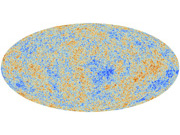 | Planck reveals an almost perfect Universe On 21 March 2013, the Planck collaboration has released the most detailed map of the Cosmic Microwave Background. The ESA Planck satellite was launched on May 14th, 2009, togheter with Herschel. The payload carries two instruments covering the millimeter and submillimeter frequency spectrum from 30 to 857GHz. The Low Frequency Instrument, mainly supported by ASI, is led by N. Mandolesi of the Italian Space Agency. The High Frequency Instrument is led by J.-L. Puget of the IAS-Paris Sud. 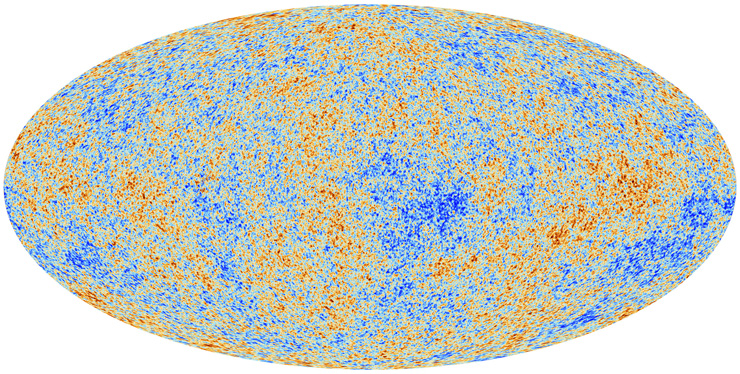 The image is based on the initial 15.5 months of data from Planck. Overall, the information extracted from Planck's new map provides an excellent confirmation of the standard model of cosmology at an unprecedented accuracy, setting a new benchmark in our manifest of the contents of the Universe. The statistical content of this map is summarised in the angular power spectrum of the CMB anisotropies, which is directly linked to the cosmological parameters. 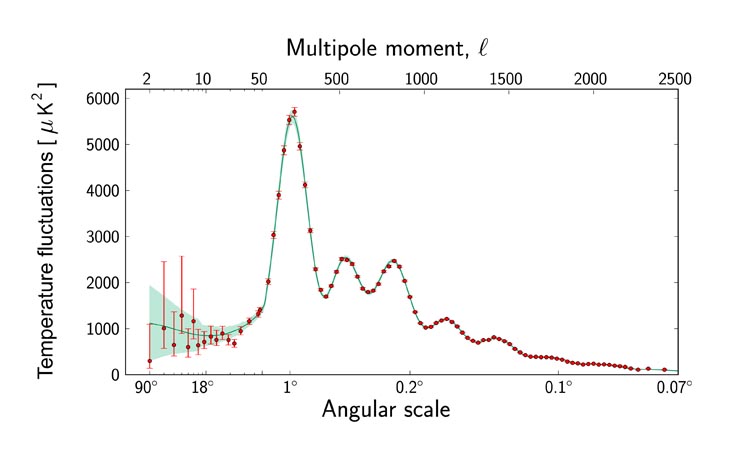 In this figure, the red dots correspond to Planck measurements, and the error bars account for measurement errors as well as for an estimate of the uncertainty that is due to the limited number of points in the sky at which it is possible to perform measurements. This so-called cosmic variance is an unavoidable effect that becomes most significant at larger angular scales. The green curve represents the best fit ΛCDM model estimated from the data. Planck has set a new cosmic recipe. Baryonic matter contributes just 4.9% of the mass/energy density of the Universe, while dark matter makes up 26.8%, nearly a fifth more than the previous estimate. Conversely, dark energy accounts for 68.3% of the total mass/energy budget of the Universe, less than previously thought. Finally, the Planck data also set a new value for the expansion rate of the Universe today: the Hubble constant is 67.15 km/s/Mpc, that is significantly less than the current standard value in astronomy. Thanks to its exquisite imaging capabilities, Planck was not only able to improve our confidence in and knowledge of the standard model. Indeed, one of the most surprising findings is that the fluctuations in the CMB temperatures at large angular scales are not as strong as expected from the smaller scale structure revealed by Planck. Another anomaly is an asymmetry in the average temperatures on opposite hemispheres of the sky, which runs counter to the Cosmological Principle. Furthermore, a cold spot extends over a patch of sky that is much larger than expected. 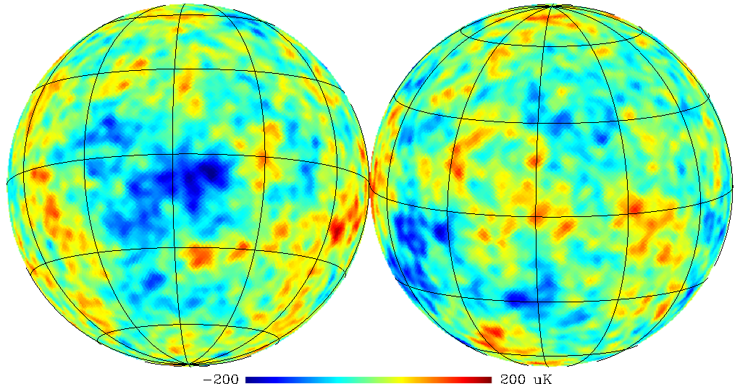 It is not currently known what the meaning of these anomalies is. The most intriguing possibility is that they are a manifestation of new physics in action in the very early Universe. New theories and new data are required to test these hypotheses. Planck is expected to reveal its full mission data next year, including the long awaited detailed measurements of CMB polarisation. The whole list of Planck results is much longer. A series of scientific papers describing the new results has been published on 22 March, and it is available on ESA website. Access to Planck data is provided through the ESA Planck Legacy Archive. The first Planck Catalogue of Compact Sources (PCCS1), containing more than 30000 galactic and extragalactic objects detected by Planck, will also be available on ASDC interactive tools by next week. The ASDC supports the LFI Data Processing Center based at INAF-OATS for radiometer noise estimation and CMB angular power spectrum analysis. Moreover, the ASDC is involved in the study of extragalactic sources leading a programme for observations of blazars with Planck, Swift, and Fermi satellites. The Planck team at ASDC is composed by G. Polenta (staff scientist), P. Natoli (senior scientist), and P. Giommi (ASDC Director). For more information, see: [All images - Credit: ESA, LFI and HFI consortia] |
Jan 16, 2013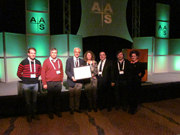 | Award ceremony of the Bruno Rossi prize 2012 to Marco Tavani and the AGILE Team. The ceremony for the 2012 "Bruno Rossi" prize, awarded to Marco Tavani and the AGILE Team, was held in Long Beach, CA, on January 10, 2013, during the American Astronomical Society (AAS) 221 Meeting. The prestigious High Energy Astrophysics Division (HEAD) Rossi prize has been awarded to AGILE for the unexpected discovery in 2010 of strong and rapid gamma-ray flares from the Crab Nebula over daily timescales (M. Tavani et al., Science vol. 331, 2011). Long thought to be a steady source of radiation, from optical to gamma rays, the AGILE findings have changed the understanding of this cosmic object, and challenged emission models of pulsar wind and particle acceleration processes. The discovery of flaring activity from the Crab nebula was made possible also thanks to the sky monitoring capability and fast ground segment alert system of the AGILE satellite, which also observed a previous flare from the Crab Nebula in October, 2007, reported in the First AGILE source catalog as a possible unexpected brief flux increase (Pittori et al., A&A 506, 2009). The Rossi Prize lecture: "The Flaring Crab Nebula: Surprises and Challenges" given by Marco Tavani on behalf of the AGILE mission team was among the AAS 221 conference highlights. See also: AGILE poster presented at the AAS meeting and (in Italian): ASI news, INAF news, INAF-TV Video 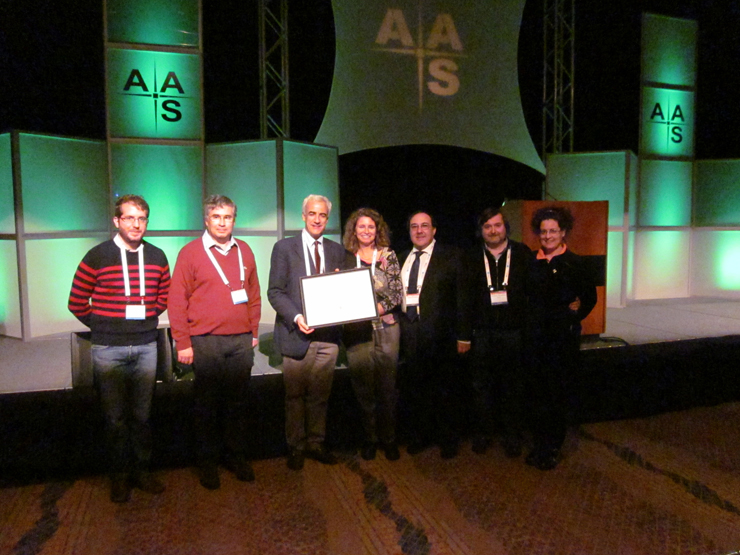 |
Oct 24, 2012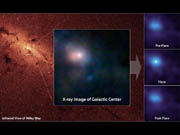 | NuSTAR Spots Flare From Milky Way's Black Hole The NASA's Nuclear Spectroscopic Telescope Array (NuSTAR) observatory has captured the first, focused view of the supermassive black hole located at the center of our galaxy (Sagittarius A*) in high-energy X-ray light. The observations were carried out in July and show the typically mild-mannered black hole during the middle of a flare-up. "We got lucky to have captured an outburst from the black hole during our observing campaign," said Fiona Harrison, the mission's principal investigator at the California Institute of Technology (Caltech) in Pasadena. "These data will help us better understand the gentle giant at the heart ofour galaxy and why it sometimes flares up for a few hours and then returns to slumber." Compared to other giant black holes at the centers of other galaxies, Sagittarius A* is relatively quiet. Active black holes tend to gobble up stars and other fuel around them. Sagittarius A* is thought only to nibble or not eat at all, a process that is not fully understood. When black holes consume fuel, whether a star, a gas cloud or even an asteroid, they erupt with extra energy. NuSTAR's X-ray telescopes picked up X-rays emitted by consumed matter being heated up to about 180 million degrees Fahrenheit (100 million degrees Celsius) and originating from regions where particles are boosted very close to the speed of light. Astronomers say these NuSTAR data, when combined with the simultaneous observations taken at other wavelengths, will help them better understand the physics of how black holes snack and grow in size. NASA Press release: http://www.nasa.gov/mission_pages/nustar/news/nustar20121023.html NuSTAR, launched June 13, is a Small Explorer mission led by Caltech and managed by NASA's Jet Propulsion Laboratory in Pasadena. The observatory carries the first focusing hard X-ray (3-80 keV) telescope to orbit, opening the hard X-ray sky for sensitive study for the first time. A full description of the mission can be found at the following link: http://www.nustar.caltech.edu/ The primary science objectives are the study of the evolution of massive black holes, of compact objects, of the nature of the massive black hole in the center of the Milky Way, of the explosion dynamics and nucleosynthesis in supernovae and of the nature of particle acceleration in relativistic jets in Active Galactic Nuclei. The Italian participation includes the provision of the Malindi ground station (ASI), the ASI Science Data Center (ASDC), which contributes to the development of the NuSTARDAS software package and will host an official mirror of the NuSTAR scientific data archive, and a team of scientists of the Istituto Nazionale di Astrofisica (INAF) to collaborate on the primary scientific mission goals. NuSTAR, launched June 13, is the only telescope capable of producing focused images of the highest-energy X-rays. 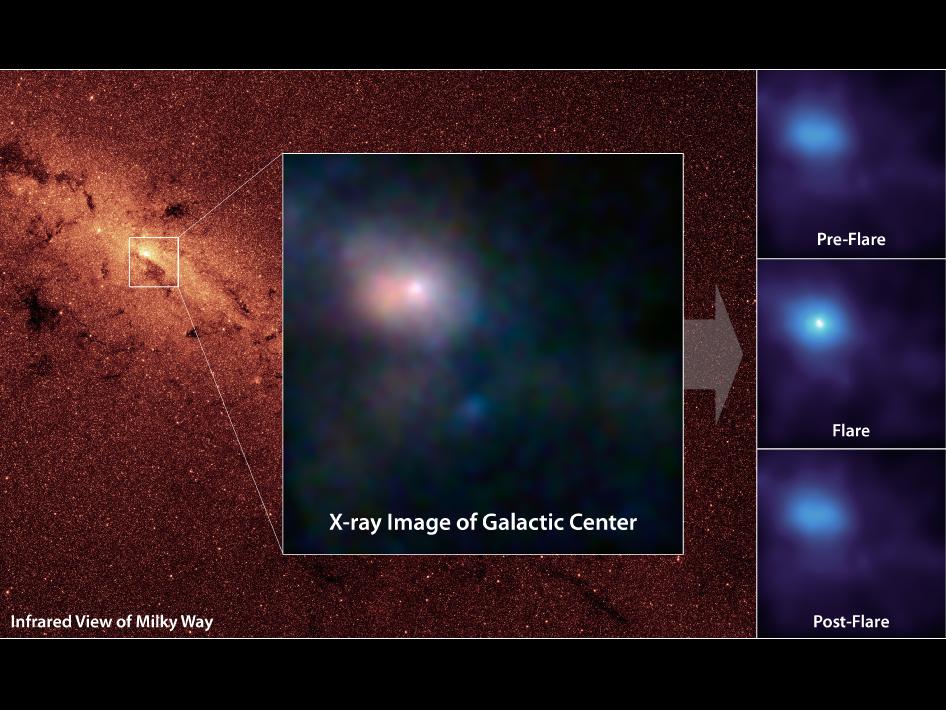 Figure caption: NuSTAR first, focused high-energy X-ray views of the area surrounding the supermassive black hole, called Sagittarius A*, at the center of our galaxy. In the main image, the brightest white dot is the hottest material located closest to the black hole, and the surrounding pinkish blob is hot gas, likely belonging to a nearby supernova remnant. The time series at right shows a flare caught by NuSTAR over an observing period of two days in July; the middle panel shows the peak of the flare, when the black hole was consuming and heating matter to temperatures up to 180 million degrees Fahrenheit (100 million degrees Celsius). The main image is composed of light seen at four different X-ray energies. Blue light represents energies of 10 to 30 kiloelectron volts (keV); green is 7 to 10 keV; and red is 3 to 7 keV. The time series shows light with energies of 3 to 30 keV (Image credit: NASA/JPL-Caltech). |
June 28, 2012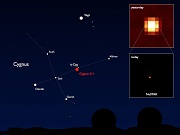 | NuSTAR First Light! On June 28, the NASA Nuclear Spectroscopic Telescope Array (NuSTAR), obtained its first image of a celestial source, Cygnus X-1, a black hole in our galaxy that is siphoning gas off a giant-star companion. NuSTAR's mast, providing the telescope mirrors and detectors with the 10 meter distance needed to focus X-rays, was successfully deployed on June 21. "Today, we obtained the first-ever focused images of the high-energy X-ray universe," said Fiona Harrison, the mission's principal investigator at the California Institute of Technology in Pasadena, who first conceived of NuSTAR about 15 years ago. "It's like putting on a new pair of glasses and seeing aspects of the world around us clearly for the first time." NASA Press release: http://www.nasa.gov/mission_pages/nustar/news/nustar20120628.html 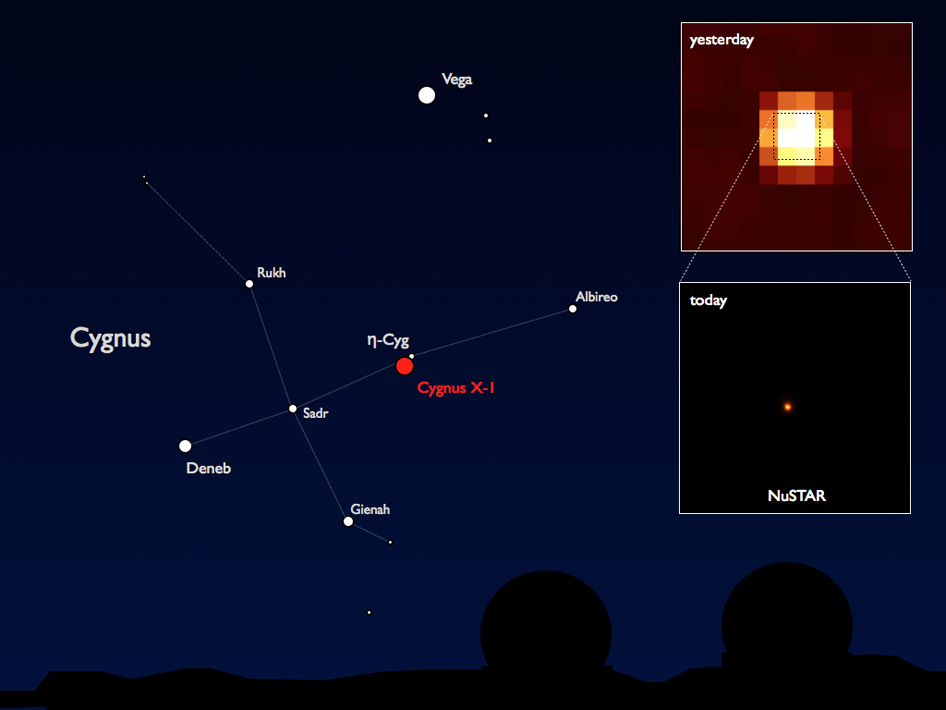 Figure caption: The inset image on the top right was taken with the INTEGRAL high-energy telescope; the image is 1 degree across, or twice the diameter of the moon. The bottom image shows NuSTAR's snapshot of the central part of that image. (Image credit: NASA/JPL-Caltech) |
June 13, 2012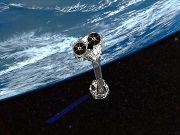 | NuSTAR successfully launched! On June 13, 2012 16:00 GMT the NASA NuSTAR mission was successfully launched aboard a Pegasus XL rocket from the Kwajalein Atoll, in the Marshall Islands, and deployed into a low-Earth, near-equatorial orbit. The solar arrays have been deployed, all comunications are working and the spacecraft is controlled. The drop location for the Pegasus was about 117 nautical miles south of Kwajalein, at an altitude of 39,000 feet over the Pacific Ocean and about 6.75 degrees above the equator. The Pegasus launch vehicle is built by Orbital Sciences Corporation and relies on a unique air-launch system with the rocket released from the "Stargazer" L-1011 aircraft. ASI Press release: http://www.asi.it/it/press_room/comunicati_stampa/nustar_alla_scoperta_dei_buchi_neri INAF Press release: http://www.media.inaf.it/2012/06/13/nustar-pronti-partenza-via/ The mission: The Nuclear Spectroscopic Telescope Array (NuSTAR) is a NASA Small Explorer mission that carries the first focusing hard X-ray (5-80 keV) telescope to orbit, opening the hard X-ray sky for sensitive study for the first time. A full description of the mission can be found at the following link: http://www.nustar.caltech.edu/ The primary science objectives are the study of the evolution of massive black holes, of compact objects, of the nature of the massive black hole in the center of the Milky Way, of the explosion dynamics and nucleosynthesis in supernovae and of the nature of particle acceleration in relativistic jets in Active Galactic Nuclei. The Italian participation includes the provision of the Malindi ground station (ASI), the ASI Science Data Center (ASDC) which contributes to the development of the NuSTARDAS software package and will host an official mirror of the NuSTAR scientific data archive and a team of scientists of the Istituto Nazionale di Astrofisica (INAF) to collaborate on the primary scientific mission goals. 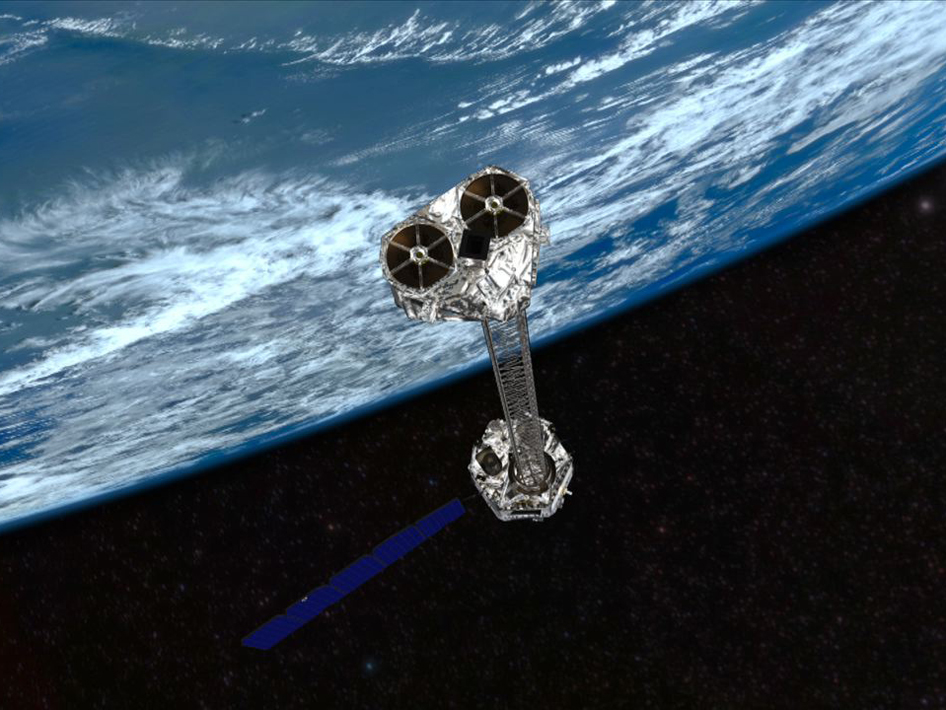 Figure caption: Artist concept of NuSTAR fully extended after launch (Image credit: NASA/JPL-Caltech) |
May 31, 2012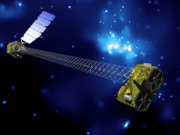 | Release of the final pre-flight NuSTAR Data Analysis Software (NuSTARDAS) On May 28, 2012 the ASDC has delivered to the NuSTAR Team at the California Institute of Technology (Caltech) the final pre-launch release of NuSTAR Data Analysis Software (NuSTARDAS, v. 0.5.0), the package to process the NuSTAR FITS formatted telemetry Level 1 data and generate calibrated Level 2 and Level 3 scientific products (event files, energy spectra, light-curves, sky images, exposure maps, ARFs, RMFs). The NuSTARDAS software has been developed at the ASDC in collaboration with the NuSTAR Team in Caltech, based on the Swift experience of the XRTDAS software development. The NuSTARDAS will be the official software for the NuSTAR scientific data reduction. It will be used at the NuSTAR Science Operation Center (SOC) in Caltech to generate the NuSTAR Science Team archive. The package will also be distributed to the users by the HEASARC as part of the HEASoft software. NuSTARDAS will be used at the NASA HEASARC Data Center to generate the public scientific archive. The NuSTAR data products will be compatible with widely used high-energy astronomy data analysis packages (e.g. XSELECT, XSPEC, XIMAGE, XRONOS). The mission: The Nuclear Spectroscopic Telescope Array (NuSTAR) is a NASA Small Explorer mission that will carry the first focusing hard X-ray (5-80 keV) telescope to orbit, opening the hard X-ray sky for sensitive study for the first time. The launch is scheduled for June 13th, 2012 and the primary mission is expected to last two years. The NuSTAR observatory scientific payload consists of two co-aligned X-ray telescopes and two CZT detectors that allow to extend the sensitivity to higher energies as compared to previous X-Ray missions. NuSTAR will use a deployable mast that will extend to achieve a 10-meter focal length. A full description of the mission can be found at the following link: http://www.nustar.caltech.edu The primary science objectives are the study of the evolution of massive black holes, of compact objects, of the nature of the massive black hole in the center of the Milky Way, of the explosion dynamics and nucleosynthesis in supernovae and of the nature of particle acceleration in relativistic jets in Active Galactic Nuclei. The Italian participation includes the provision of the Malindi ground station (ASI), the ASI Science Data Center (ASDC) which contributes to the development of the NuSTARDAS software package and will host an official mirror of the NuSTAR scientific data archive and a team of scientists of the Istituto Nazionale di Astrofisica (INAF) to collaborate on the primary scientific mission goals. 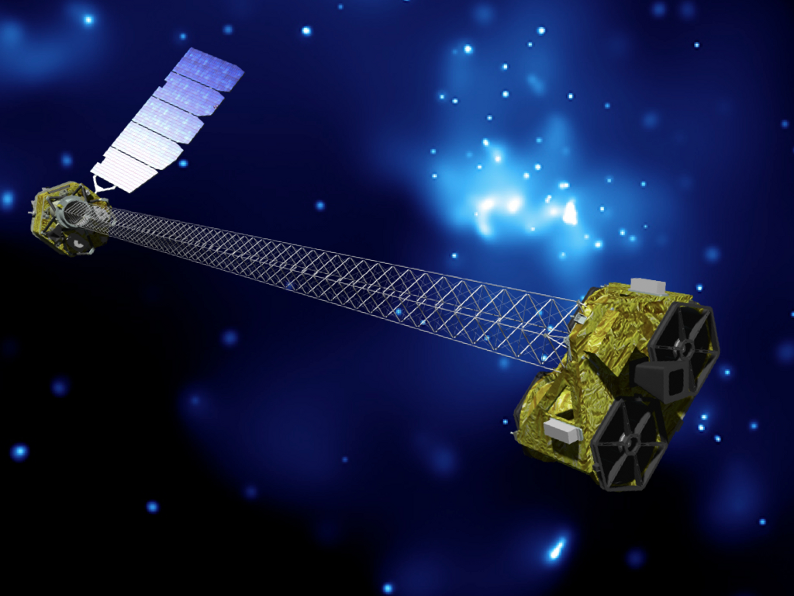 Figure caption: Artist concept of NuSTAR fully extended after launch (Image credit: NASA/JPL-Caltech) |
January 12, 2012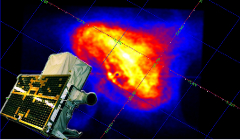 | AGILE wins the 2012 "Bruno Rossi prize", the fourth time that a mission supported by ASDC is given this important award! We are proud to announce that the 2012 "Bruno Rossi prize" of the High Energy Astrophysics Division of the American Astronomical Society has been awarded to "Marco Tavani and the AGILE team for the discovery of gamma-ray flares from the Crab Nebula." AGILE ("Astrorivelatore Gamma a Immagini Leggero") is an Italian space mission dedicated to the observation of the gamma-ray Universe. Despite the small size and budget, AGILE, thanks to its scientific team led by the PI Marco Tavani, produced several important scientific results, among which the discovery of strong flares from the Crab Nebula and the characterization of Terrestrial Gamma-rays Flashes. This is the fourth time that a space mission in which the ASDC plays an important role has been awarded a "Bruno Rossi prize", after BeppoSAX in 1998, Swift in 2007 and Fermi in 2011. During 2010 the AGILE discovery of Crab Nebula variability above 100 MeV has astonished the scientific community (M. Tavani et al., Science vol. 331, 2011). Astronomers have always believed the Crab to be a constant source from optical to gamma-ray energies: an ideal standard candle. However, on September 2010, AGILE detected a giant gamma-ray flare, and thanks to its rapid alert system, made the first public announcement on September 22, 2010. This finding was confirmed the next day by the Fermi Observatory (A. Abdo et al., Science vol. 331, 2011). A previous flare from the Crab Nebula was observed by AGILE in October, 2007 and reported in the First AGILE source catalog as a possible unexpected flux increase (Pittori et al., A&A 506, 2009). Funded by ASI, AGILE was built and is operated in cooperation with INAF and INFN, with the participation of CIFS and of several Italian companies: CGS S.p.A, Thales-Alenia Space Italia, Rheinmetall Italia, Telespazio, Galileo Avionica, Mipot. The satellite was lauched on April 23rd, 2007, from the Indian base of Sriharikota. AGILE raw data are down-linked to the ASI Malindi ground station in Kenya and transmitted first to the Telespazio Mission Control Center at Fucino, and then to the AGILE Data Center. The AGILE Data Center (ADC), located at ASDC, is in charge of all the scientific oriented activities related to the analysis and archiving of AGILE data. The AGILE team at ASDC is composed of: P. Giommi: ASDC responsable and AGILE ASI Project Scientist C. Pittori: archive scientist, coordinator of the AGILE Data Center F. Lucarelli: archive scientist P. Santolamazza: archive scientist F. Verrecchia: archive scientist ADC aknowledge the support of all the ASDC staff and infrastucture, and in particular the contribution of A. Antonelli and S. Colafrancesco. ADC aknowledge also the specialist informatic support of G. Fanari, R. Primavera and S. Stellato (Telespazio) and of the late Francesca Tamburelli, who was one of the main architects behind the BeppoSAX, Swift and AGILE data systems. See also (in Italian): ASI news, INAF news, INFN news, Interview with AGILE PI Marco Tavani. 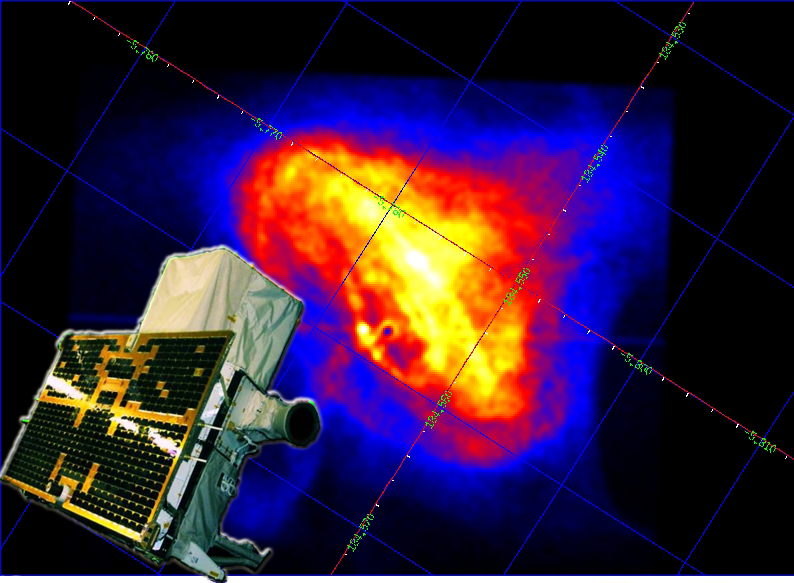 Credits: ASDC. Image background: Chandra X-ray ToO data on September 28, 2010 |
January 5, 2012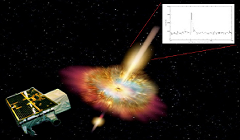 | GRB 111211A: a new Gamma-ray Burst associated to a Supernova discovered by SuperAGILE On 11 December 2011 at 22:17:33 UT the SuperAGILE hard X-ray monitor aboard the Italian AGILE satellite localized a Gamma Ray Burst, GRB 111211A (GCN #12666, F. Lazzarotto et al.). The GRB 111211A is the first event discovered by SuperAGILE and associated to a Supernova (GCN #12802, A.de Ugarte Postigo et al.). While an average number of about 200 - 300 GRBs are localised each year in the X-ray band, less than twenty firm associations with Supernovae are established up to now. The SuperAGILE GRB 111211A is a rare occurrence of a burst which appears to be accompanied by a Supernova explosion, and gives us the opportunity to investigate further the GRB-Supernova connection. The light-curve of the GRB 111211A prompt emission is composed of two peaks: the first one is hard and also triggered the AGILE Minicalorimeter (MCAL) between 0.3 and 1.4 MeV energy, while the second one is soft and is not detected by CAL above 0.3 MeV, indicating an evident spectral evolution. The AGILE gamma-ray imager (GRID) did not detect a gamma-ray emission from this event above 50 MeV energy. The burst prompt emission has a remarkable time-integrated fluence, 9.2 x 10-6erg/cm2, as measured in the 20 - 1200 keV energy range by the Konus-Wind instrument (GCN #12676, S. Golenetskii et al.). A Target of Opportunity observation by the Swift satellite was performed, and the afterglow was rapidly localised in X-rays (GCN #12673) and in optical-UV (GCN #12678) at a position within the SuperAGILE error region. In the follow-up campaign the redshift of GRB 111211A was measured at z=0.478 with the X-shooter spectrograph mounted on the ESO-VLT telescope (GCN #12677). Telescopes as GROND (GCN #12668), NOT (GCN #12675) and Mt. Terskol (GCN #12704) were involved in the follow-up campaign to study the decay law of the afterglow. On 1 January 2012, about 20 days after the SuperAGILE detection, the optical afterglow was still at a magnitude of r ~ 22.6, as observed by the GTC telescope at the Roque de los Muchachos Observatory (La Palma, Spain). The almost flat evolution at late-time of the lightcurve of the optical afterglow indicates a possible Supernova component contribution (GCN #12802). In the same observation, the spectrum of the afterglow shows characteristic signatures of a Supernova, similar to the spectrum of the type Ic SN 2006aj / GRB 060218 close to the maximum. GRBs can be classified depending on their duration and on the boundary between short and long events is fixed at 2 s. A fairly low number of long GRBs are associated with core-collapse Supernovae, whose emission starts to show up in the lightcurve of the optical afterglow few weeks after the prompt emission. The first of these associations was discovered in 1998 by the Italian satellite BeppoSAX, between GRB 980425 and SN 1998bw. Characteristic of the Supernovae associated to GRBs is the highly relativistic speed of their ejecta. The explanation of the so called "GRB Supernova connection" involves the explosion of massive and highly rotating stars that have lost their hydrogen envelope. The relationship, however, is not yet fully understood since there are some nearby long GRBs for which the association with a Supernova has not been found. GRBs associated to Supernovae are generally concentrated at low redshift (that is at small distance from us), while GRB 111211A is in the higher redshift tail of the distribution. The "central engine" at the origin of the GRBs emission is still unknown and the possible correlation with other types of cosmic explosions, for example Supernovae, can give new information to understand these fascinating and still enigmatic transients. 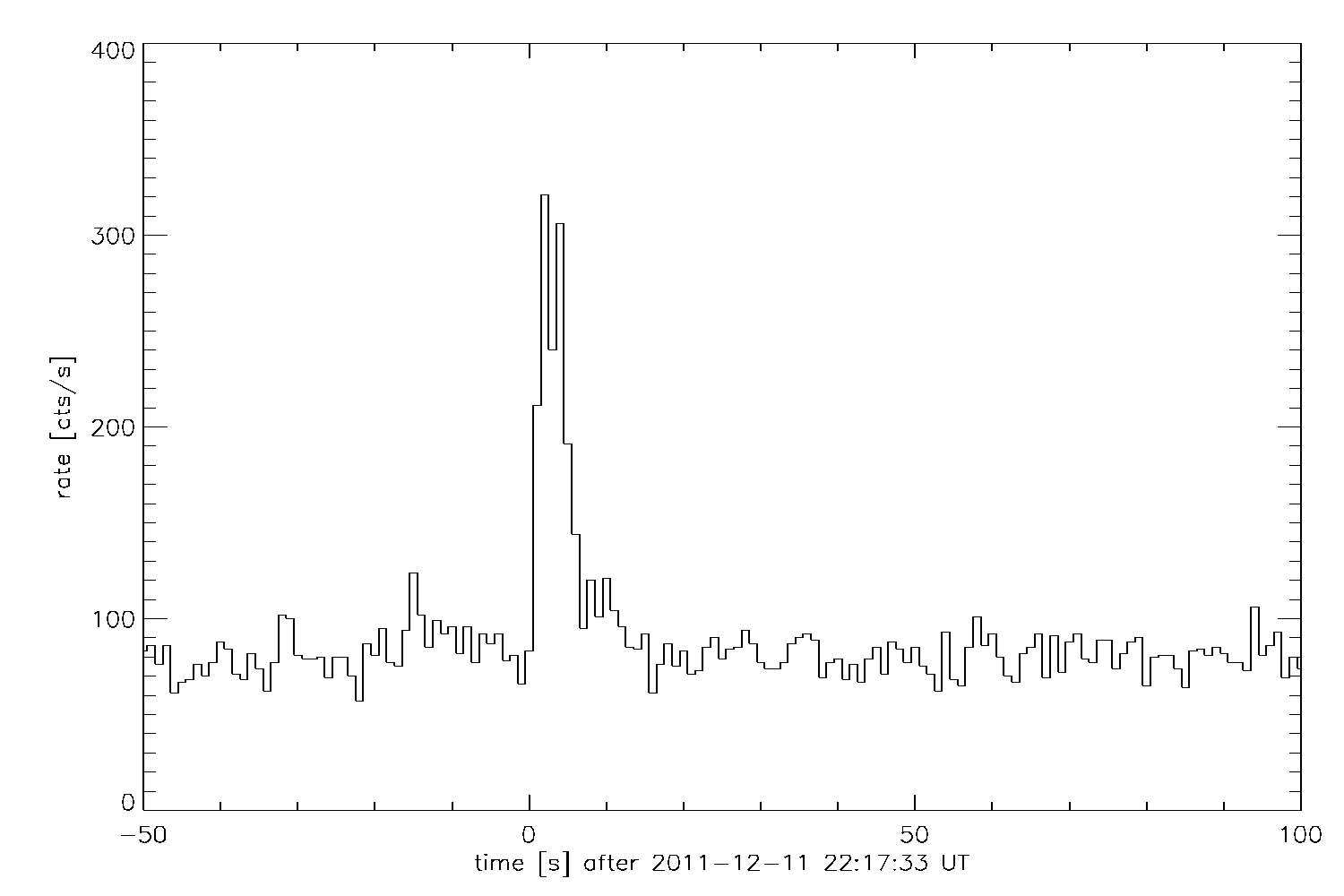 Lightcurve of the SuperAGILE GRB 111211A |
November 29, 2011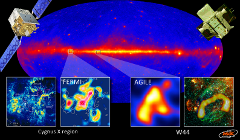 | The origin of Galactic cosmic rays is unveiled by recent results of AGILE and Fermi The problem of the origin of Galactic cosmic rays has puzzled astronomers since their discovery nearly a century ago. Cosmic rays are energetic subatomic particles - about 89% protons, 10% helium nuclei, and 1% electrons - that impact the Earth's atmosphere from all directions. The galaxy's best candidate sites for cosmic-ray acceleration are the rapidly expanding shells of ionized gas and magnetic field associated with supernova explosions. Providing an unambiguous proof of the cosmic-ray origin has been until now elusive, despite many decades of attempts and controversial claims. ASI's AGILE and NASA's Fermi satellites are using gamma-rays to probe likely sites of cosmic-ray acceleration. AGILE has recently discovered a pattern of gamma-ray emission from the supernova remnant W44 that, combined with the observed multifrequency properties of the source, can be unambiguously attributed to accelerated protons interacting with nearby dense gas. The AGILE gamma-ray imager reaches its optimal sensitivity just at the energies in the 50 MeV-a few GeV range at which neutral pions (produced by proton-proton interactions) decay in gamma-rays producing an unambiguous signature. The AGILE data resolves the problem of clearly identifying a source of energetic cosmic rays in our Galaxy exactly one hundred years after the discovery of cosmic rays by Victor Hess in 1912. Cosmic rays may also come from clusters of massive, young stars called OB associations. Observing the heart of the Cygnus constellation (the region of Cygnus X source) the Fermi Large Area Telescope (LAT) has recently found that cosmic rays are accelerated in the turbulent medium of a "cocoon" region where massive, hot, blue and windy stars are forming. The 1-100 GeV gamma-ray images reveal a 50-parsec-wide young super bubble of freshly accelerated cosmic rays that flood the cavities carved by the stellar winds and ionization fronts from young stellar clusters. The well known Gamma Cygni supernova remnant also lies within this region. The Fermi team considers it possible that the supernova remnant engendered the cosmic rays trapped in the Cygnus X cocoon, but they also suggest an alternative scenario where the particles became accelerated through repeated interaction with shockwaves produced inside the cocoon by powerful stellar winds. ASI supports data analysis for both AGILE and Fermi at the ASI Science Data Center in Frascati. More information in: AGILE article: A. Giuliani et al. ApJ 742, 2011 See also INAF news, ASI news, Italian Press Release, English Press Release Fermi article: Science Vol. 334, 2011 See also INAF news, NASA news 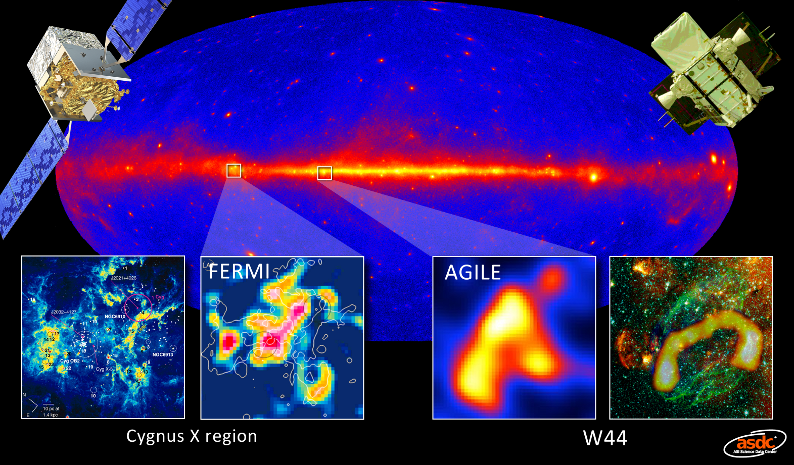 Figure Credits: S. Ciprini combining AGILE Team, G. Castelletti, G. Dubner Images and NASA/DOE/Fermi LAT Images |
August 24, 2011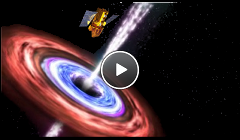 | Swift catches a supermassive black hole in the act of swallowing a star. A supermassive black hole has been observed as it apparently pulls apart and swallows a star that got too close. As reported by two groups in Nature (Aug 25th issue), the event has provided astronomers with a rare opportunity to study the birth of a 'relativistic jet' - a high-speed outflow of ionized matter, launched by the accretion of material from the star onto the black hole. Most galaxies have supermassive black holes at their centres, with masses of millions or even billions of Suns. Their powerful gravitational fields have strong gradients that can destroy passing stars, producing a bright flare of ultraviolet light and X-rays as the stellar debris accretes onto the black hole. The aftermath of this process has probably been observed several times, as slowly fading emission from distant galaxies, but until now, the onset of such an event has never been observed. David Burrows and colleagues report observations of a bright X-ray flare from an extragalactic object detected by the Swift satellite on 25 March of this year. From the flare's spectral signature and time evolution, the authors conclude that it comes from the accretion of material onto a million-solar-mass black hole. From radio observations of the same object, Ashley Zauderer and colleagues find that it coincides with the centre of a galaxy, and that the source of the emissions is expanding at a velocity close to that of light. Both groups conclude that the accretion of material from a disrupted star has produced a relativistic jet - an outcome that was not predicted by theoretical models. The Nature paper led by David Burrows has several Italian co-authors, including four from the ASDC. 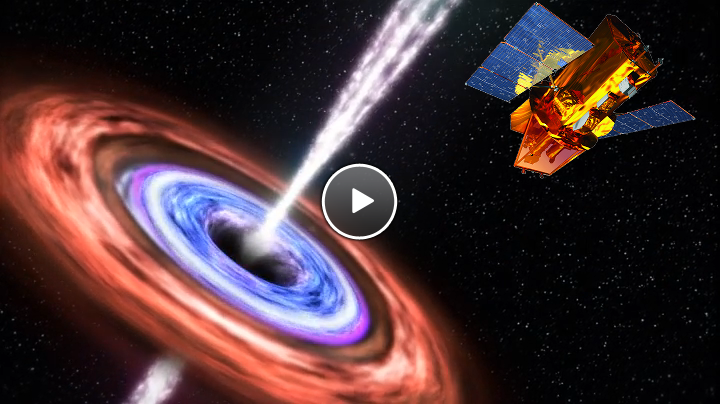 Credits: NASA/Goddard Space Flight Center. Video adapted @ ASDC. For more information see the joint ASI-INAF press release and the INAF dedicated web page (Italian language) |
April 19, 2011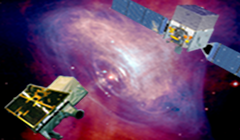 | New Crab Nebula enhanced activity and unprecedented giant flare in gamma-rays A renewed increase of the gamma-ray activity above 100 MeV from the Crab Nebula has been recently reported by Fermi in ATel #3276 (R. Buheler at al.) in the period April 9-11, 2011, and confirmed by the AGILE monitoring in ATel #3282 (M. Tavani et al.). We recall that a gamma-ray flux increase from the direction of the Crab Nebula was reported for the first time by AGILE, and then confirmed by Fermi in September 2010 (ATel #2855 and ATel #2861). Fermi satellite began a pointed mode observation of the Crab Nebula in response to the recent observed increase in gamma-ray activity. A ToO Swift/XRT observation was also promptly performed but no significant X-ray flux variation was detected, as reported in ATel #3279 (G. Cusumano et al.). Chandra was observing the Crab on April 12 and 13, 2011 as part of their monitoring program, which began following the previous surprising gamma-ray flare in September 2010. Chandra observations are reported in ATel #3283 (A. Tennant et al.). A very strong gamma-ray flare was then detected by AGILE on April 16, 2011, see ATel #3286 (E. Striani et al.). The flux above 100 MeV reached the unprecedented value of F = (20.0 ± 3.7) 10^{-6} ph/cm2/sec. The detected gamma-ray flux from the Crab was then twice as bright as the Vela Pulsar. 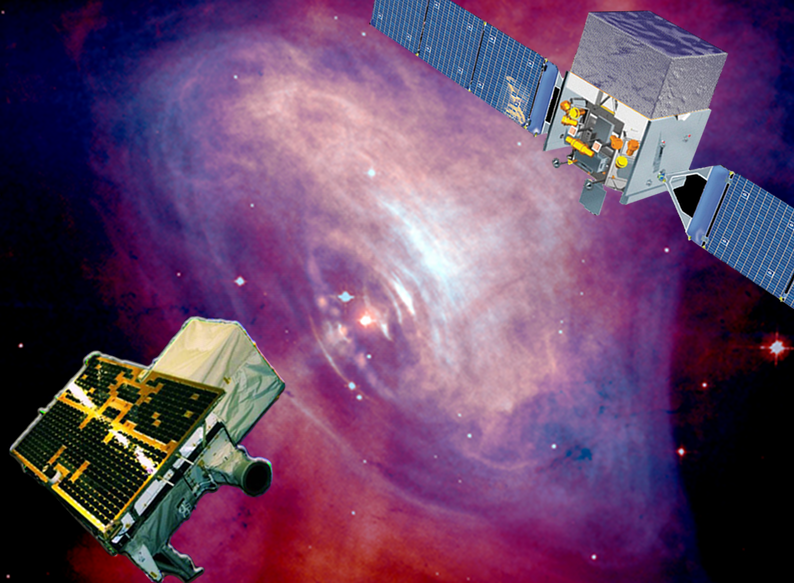 Credits: Image background X-ray: NASA/CXC/ASU/J.Hester et al.; Optical: NASA/HST/ASU/J.Hester et al., AGILE (ASI) and Fermi (NASA) satellites. |
January 21, 2011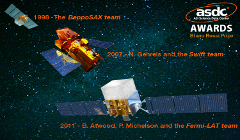 | Fermi Team wins Top High-Energy Prize 'Bruno Rossi' The 2011 Rossi Prize has been awarded to Bill Atwood, Peter Michelson and the Fermi-LAT team "for enabling, through the development of the Large Area Telescope, new insights into neutron stars, supernova remnants, cosmic rays, binary systems, active galactic nuclei, and gamma-ray bursts". The American Astronomical Society (AAS) High Energy Astrophysics Division (HEAD) awards the Rossi Prize in recognition of significant contributions as well as recent and original work in high-energy astrophysics. The prize is in honor of Professor Bruno Rossi, an authority on cosmic ray physics and a pioneer in the field of X-ray astronomy. The winners of the Rossi Prize will give a joint lecture at the 219th AAS meeting in Austin, Texas in January 2012. The Fermi Gamma-Ray Space Telescope, formerly GLAST, is an international and multi-agency space observatory that studies the cosmos in gamma-rays, the most energetic form of light. The LAT is one of two instruments onboard Fermi and is the most sensitive and highest-resolution gamma-ray detector ever launched. The ASDC is actively involved in the Fermi collaboration playing an important role in the development of the LAT scientific and data analysis software, especially for the automatic data processing, developing the software for the publication of LAT catalogues and the distribution of high level data products. ASDC staff is also contributing to many scientific activities within the Fermi LAT collaboration particularly in the fields of AGN, GRB and in multi-frequency data analysis. The Fermi team at ASDC is composed of: P. Giommi: full member, former AGN Science group coordinator in years 2006-2008, E. Cavazzuti: full member, one of the current AGN Science group coordinators and leader of Fermi team in ASDC, S. Cutini: post doc member with main research activity on GRB, AGN and catalog production, D. Gasparrini: post doc member, one of the Flare Advocate team coordinators with main research activity on AGN and catalog production, R. Primavera: technical member with activity on software programming (in particular the 'Quick Look' named Automatic Science Processing), C. Pittori and M. Perri: affiliated members with activity in multi-frequency data analysis. This is the third time that members of the ASDC have been awarded a Bruno Rossi Prize after BeppoSAX in 1998 and Swift in 2007. For more information about Fermi, visit: http://fermi.asdc.asi.it, http://www.nasa.gov/fermi Information on previous winners of the Rossi Prize can be found at http://www.aas.org/head/rossi/rossi.recip.html 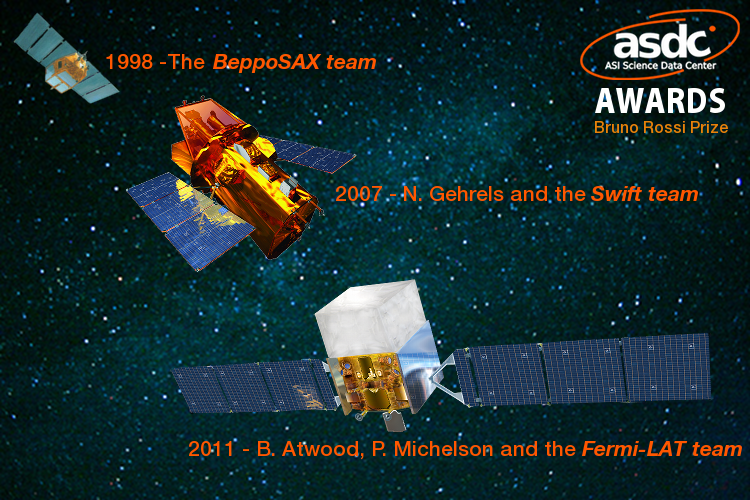 |
October 7, 2010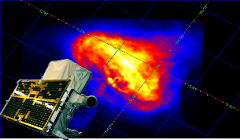 | The Crab "goes wild" in gamma-rays More suprises from sky observations in gamma-rays. The ASI satellite AGILE, thanks to its sky monitoring capability and fast ground segment alert system, has discovered an increased gamma-ray flux above 100 MeV from a source positionally consistent with the Crab Nebula. The unexpected discovery has been promptly reported on September 23, 2010 in ATel #2855 (M. Tavani et al.), and confirmed the next day by the Fermi satellite in ATel #2861 (R. Buehler et al.). Fermi interrupted its all-sky scanning mode and completed a dedicated pointed observation of the Crab Nebula from 2010-09-23 to 2010-09-27 to increase its exposure on the source. Measurements taken starting on 23 September show that the gamma-ray flux is back to normal values, see ATel #2879. The Crab Pulsar and Nebula are the remnants of the explosion of the supernova SN1054, and the spectra containing the diffuse and pulsed emission has always been considered the standard X-ray candle for X-ray and gamma-ray satellites used also for instrument calibration. Following the surprising discovery by AGILE, the results of INTEGRAL observations of the Crab nebula, performed for calibration purpose, and the Swift/BAT team routine monitor of the source were reported in ATel #2856 and ATel #2858 respectively. In these hard X-rays observations, however, no statistically significant increase in the Crab flux was observed. Special ToO observations were then requested and performed by Swift, see ATel #2866, Chandra, see ATel #2882, and Hubble Space Telescope, see ATel #2903. Comparing the current Crab Nebula image with the extensive database available in the HST public archive, an increased emission about 3 arcsec East of the pulsar was noticed. The Chandra exposure, taken a few days before the HST one, reported a brightening from the same region. Gamma-ray data suggests that the origin of the flare is related to the nebula rather than the pulsar emission, and provide evidence for particle acceleration mechanisms in nebular shock regions more efficient than previously expected from current theoretical models. 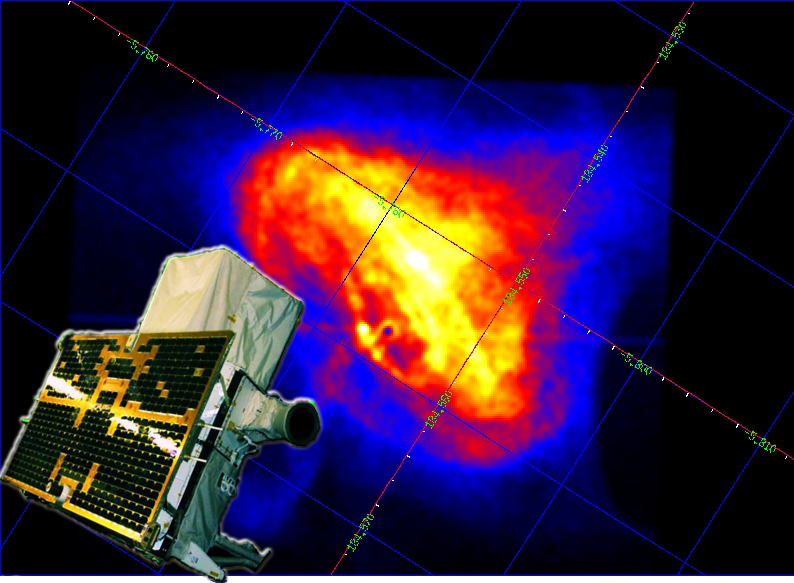 In the image background: Chandra X-ray Observatory data from the ToO observation of Crab on September 28, 2010, following the gamma-ray flare detected by AGILE. |
September 15, 2010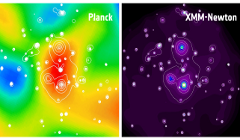 | Planck discovery of a supercluster of galaxies through SZ effect Clusters of galaxies are amongst the largest objects in the Universe. They are filled by a hot gas which interacts with the Cosmic Microwave Background (CMB) photons producing a characteristic distortion in the CMB blackbody spectrum known as Sunyaev-Zel'dovich effect. Thanks to its wide and well designed frequency coverage, the ESA Planck satellite has detected many clusters of galaxies through the S-Z effect during its survey of the microwave sky. A dedicated follow up program carried out with the ESA X-ray mission XMM-Newton has shown that one of the clusters detected by Planck is in fact a supercluster composed by many thousand of galaxies grouped in at least three individual massive clusters. This is the first discovery of a supercluster of galaxies through the Sunyaev-Zel'dovich effect. More information are available on: http://www.media.inaf.it/2010/09/15/il-gigante-dei-giganti/ (italian) http://sci.esa.int/science-e/www/object/index.cfm?fobjectid=47692 (english) 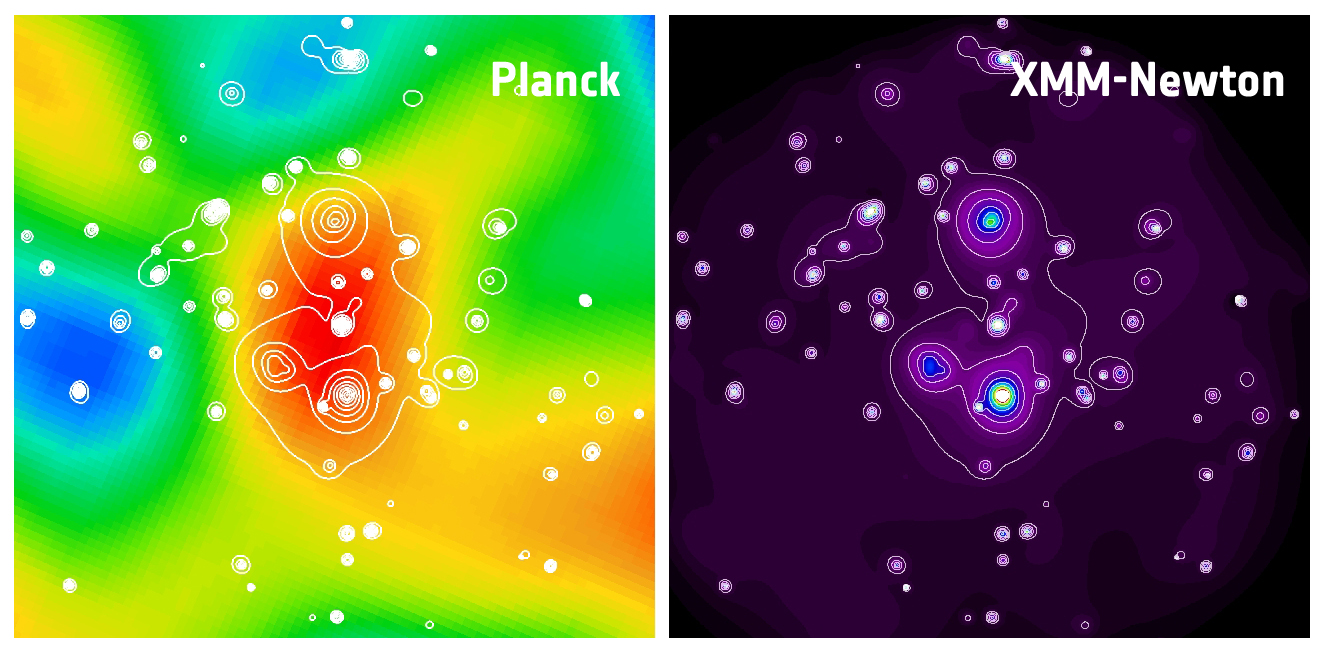 Credit: Planck image: ESA/LFI & HFI Consortia; XMM-Newton image: ESA |
July 26, 2010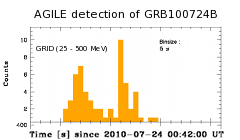 | AGILE-GRID detects its brightest Gamma-Ray Burst On July 24, 2010 AGILE detected the long bright GRB100724B (Bhat et al., GCN #10977) with both MCAL and GRID instruments (Marisaldi et al., GCN #10994, Giuliani et al., GCN #10996). The gamma-ray emission observed by the AGILE-GRID instrument in the energy range 25 - 500 MeV with high statistical significance lasted about 100 seconds. Two main peaks are evident in the lightcurves of both low and medium-high energy gamma-rays, as also observed by Fermi LAT (see Tanaka et al., GCN #10978). GRB 100724B turns out to be the brightest GRB detected by AGILE-GRID during its operations in space and one of the brightest ever detected above ~25 MeV. 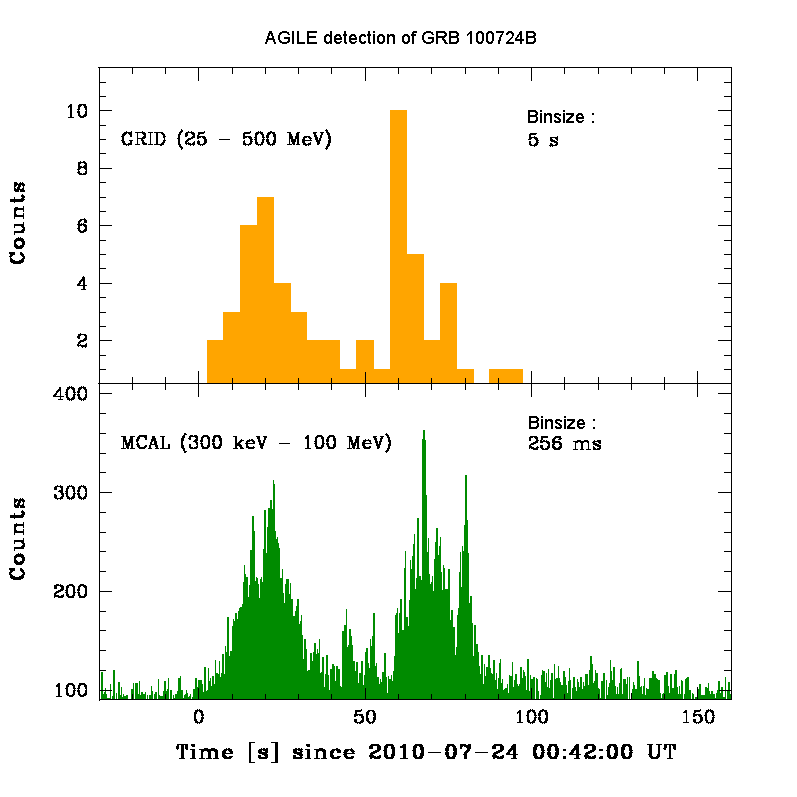 |
July 5, 2010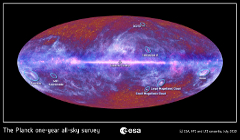 | Planck unveils the Universe � now and then The ESA Planck satellite has recently completed its first survey of the microwave sky. For the first time it has been possible to map the whole sky in frequency bands from 30 to 857 GHz. On July 5 ESA has released a low resolution version of the Planck official maps obtained combining data from all of the Planck channels. The image shows clearly the diffuse emission from the Interstellar Medium in our Galaxy, the tiny background fluctuations of the primeval Universe as well as many extragalactic sources, thus confirming the huge scientific potential of Planck. More information are available on: http://www.asi.it/it/news/planck_svela_luniverso_comera_e_com (italian) http://www.esa.int/esaCP/SEMF2FRZ5BG_index_0.html (english) http://www.media.inaf.it/2010/07/05/universo-di-planck/ (italian) 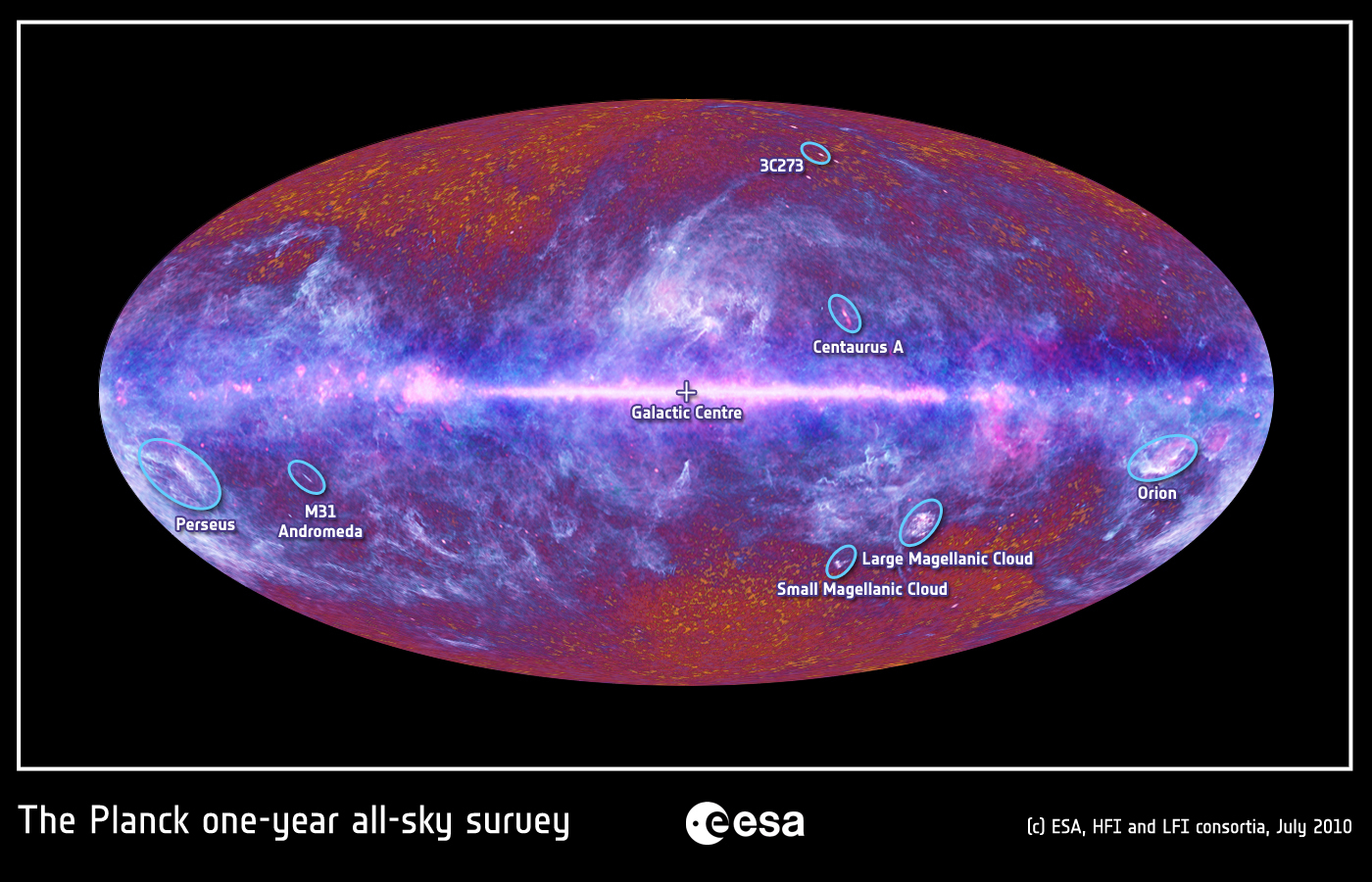 |
April 19, 2010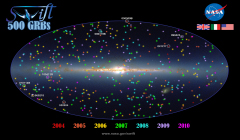 | Swift catches its 500th Gamma-ray Burst! On April 13 Swift discovered GRB 100413B in the constellation Cassiopeia, the 500th burst detected during its five years life. It is a long burst, a type usually associated with the death of a massive star. Swift satellite was launched in November 2004 and primarily studies gamma-ray bursts (GRBs), the biggest and most mysterious explosions in the cosmos. "Each burst has turned over a new piece of the puzzle and a clearer picture is emerging." said Neil Gehrels, Swift's lead researcher at Goddard Space Flight Center in Greenbelt, USA. The figure shows the locations of Swift's 500 gamma-ray bursts, color coded by the year in which they occurred. In the background, an infrared image shows the location of our galaxy. Cick here to view the video showing the GRB highlights of the Swift mission. For more details see the NASA press release, the INAF press release and the news on the ASI site. 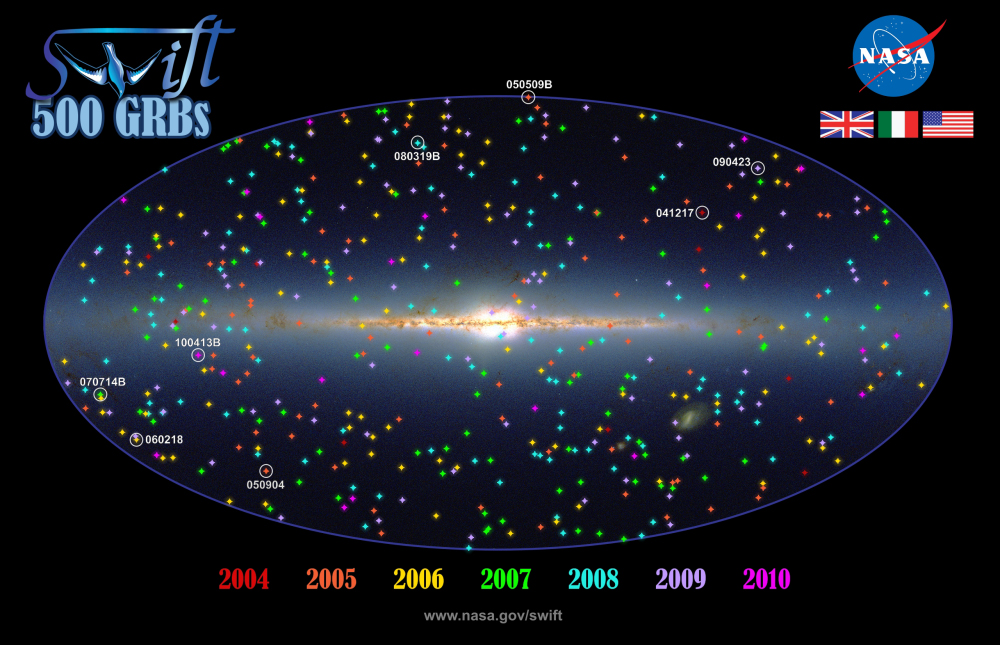 Credit: NASA/Swift/Francis Reddy |
March 25, 2010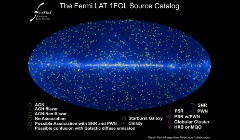 | FERMI 1-year Catalogs now on line! The Fermi Large Area Telescope (LAT) collaboration released a milestone catalog of the high- energy gamma-ray sources detected by the LAT and a study of the active galaxies that make up the majority of gamma-ray sources outside the Milky Way. These catalogs are available on-line along with multifrequency tools and Fermi-LAT data products. The links are https://www.ssdc.asi.it/fermi1lac/ and https://www.ssdc.asi.it/fermi1fgl/ This catalog is denoted 1FGL for first Fermi Gamma-ray LAT.The Fermi observatory completed the first year of its science mission in August 2009, and the 1FGL is based on analysis of most of the first-year data, for the energy range 100 MeV - 100 GeV. The 1FGL catalog is the deepest and most complete catalog of high-energy gamma-ray sources obtained to date. It has 1451 sources, several times more gamma-ray sources than all previous catalogs at these energies. The position determinations are typically accurate to within 10 arcmin and the 1FGL catalog includes measurements of the fluxes in 5 bands and light curves in 11 time intervals for each source (http://arxiv.org/abs/1002.2280v1);. The 1FGL catalog is an important resource for many studies, including discovery and characterization of new populations of GeV gamma-ray emitting sources. The field is young, and the LAT has deepened the sensitivity of the observations enough, that more theoretically plausible populations of gamma- ray sources were known than have been firmly identified in the past. With the first-year results and the 1FGL catalog the LAT team is reporting evidence for several new populations, including millisecond pulsars, 'misaligned jet source' active galaxies, and starburst galaxies as populations. Other potential populations, such as X-ray binaries (including microquasars) and globular clusters, are looking promising. For the established and new populations, the 1FGL catalog also includes a quantitative assessment of potential counterparts (`associations') at other wavelengths. Positional association is not equivalent to identification of a source, but the method defines potential gamma-ray members of the source classes, and as importantly reveals which sources have no obvious counterparts among the established source classes. The LAT collaboration found 631 such unassociated sources, using a conservative definition of positional association. The relatively large fraction of unassociated sources points to the discovery potential still to be realized in the LAT data. More than 100 of the unassociated sources are located in or near the plane of the Milky Way, where the diffuse gamma-ray glow of the Milky Way makes detection and characterization of gamma-ray sources especially difficult. The challenge for many of these 1FGL sources may be as much about understanding the diffuse emission from cosmic-ray collisions with gas and photons as about identifying the sources. By far the largest population of associated gamma-ray sources in the 1FGL catalog are active galaxies, whose gamma-ray emission is powered by jets of plasma accelerated in their nuclear regions, where matter is being accreted onto massive black holes. The First LAT Active galaxies Catalog (1LAC) presents a comprehensive study of the populations of these blazars in the 1FGL data set (http://arxiv.org/abs/1002.0150);. For this statistical study, a lower confidence level for associated sources was acceptable, and 1LAC includes more than 800 1FGL sources. The 1LAC catalog integrates observations from radio wavelengths to TeV energies to characterize the active galaxies, and 3 populations are recognized and characterized in terms of their gamma-ray spectra, variability, and luminosities, together with properties measured at other wavelengths. The 1LAC represents by far the largest sample of gamma-ray active galaxies ever available and is a valuable reference and resource for study of active galaxies and populations of active galaxies. 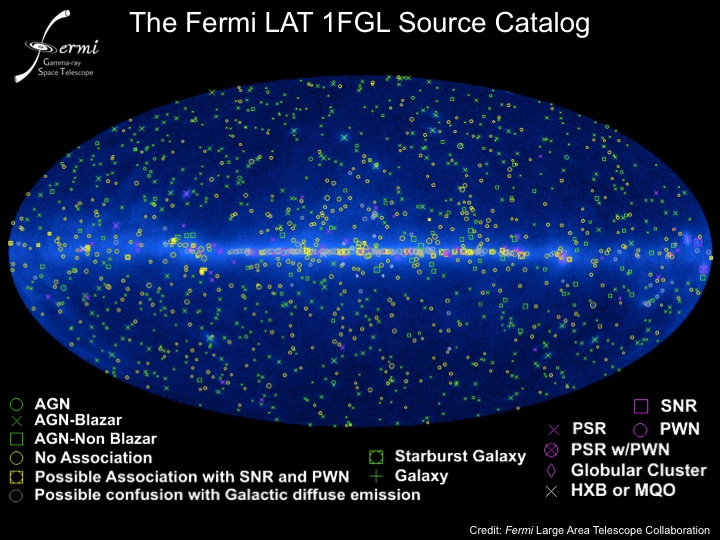 |
February 15, 2010 | The AGILE satellite detects "super-energetic TGFs" that could affect air travel "Terrestrial Gamma-Ray Flashes" (TGF) are phenomena of terrestrial (atmospheric) origin only lasting a few milliseconds that are likely associated to very intense tropical thunderstorms. The AGILE satellites detected several of these events since its first months of operations. The AGILE equatorial orbit, together with its advanced payload capabilities, allowed the discovery of TGFs with gamma-ray energy reaching up to 50 MeV. Such highly energetic radiation must be produced in atmospheric conditions requiring potential differences of 100 Mega Volts or more, hundreds of times larger than that required to produce the usual terrestrial lightning. As announced in a joint press release that can be found on the ASI and INAF websites, the AGILE Team and ASI are collaborating with ENAC (Ente Nazionale per l'Aviazione Civile) to understand the possible hazards to air traffic that these very energetic atmospheric events might cause. THE AGILE paper "Detection of Terrestrial Gamma-Ray Flashes up to 40 MeV by the AGILE satellite" by M. Marisaldi et al. (2009), previously announced on this website on October 29th 2009, is now being published in the Journal of Geophysical research and it is accessible on-line at: https://www.ssdc.asi.it/news/Marisaldi2009_AGILE-TGF.pdf |
November 12, 2009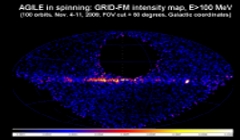 | AGILE science operations resumed on November 4th, 2009 On November 4, 2009 at 12:25:54 the AGILE scientific operations restarted. The instrument is operating nominally, and all detectors are on and acquiring data. The satellite is currently in a safe spinning mode, with the fixed solar panels pointing towards the Sun and the GRID instrument FOV covering a good fraction of the whole sky. In the figure below we show a preliminary 100-orbit gamma-ray intensity map above 100 MeV in the spinning configuration. 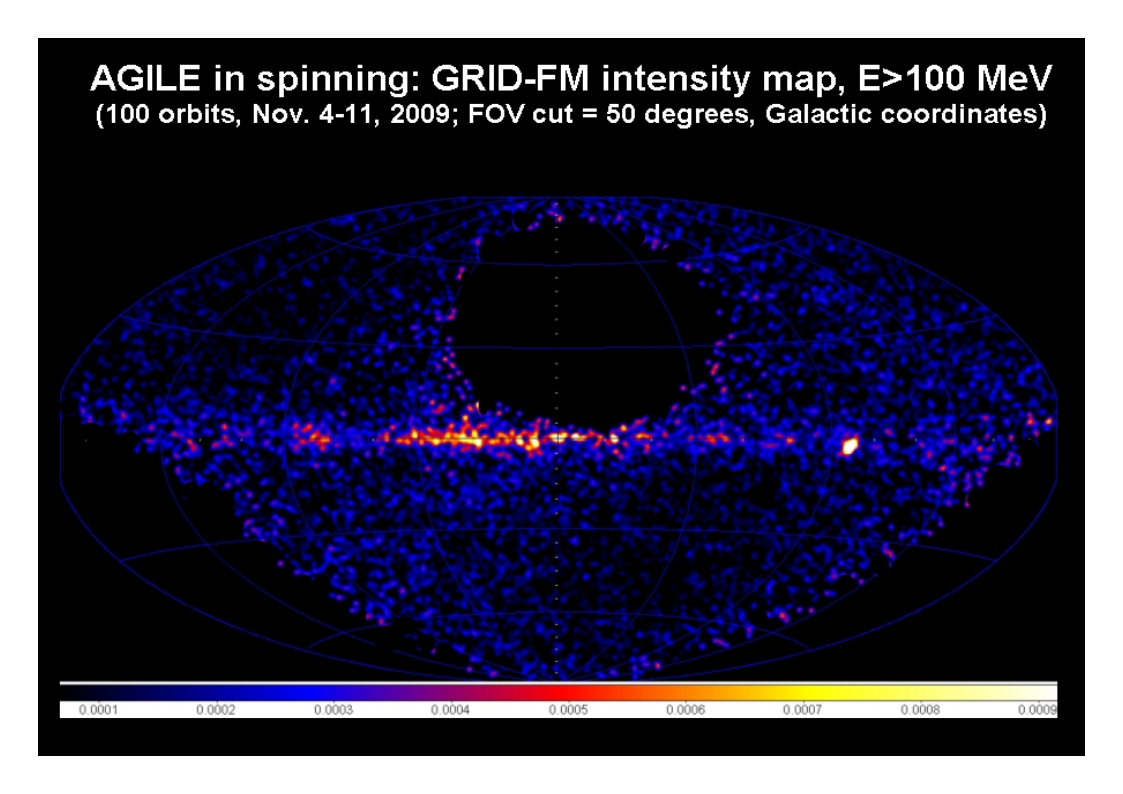 |
September 17, 2009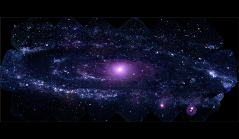 | Swift makes the highest-resolution ultraviolet image of Andromeda Galaxy The Swift satellite has acquired the highest-resolution view ever obtained in the ultraviolet band of the eighboring spiral galaxy M31 also known as the Andromeda Galaxy. The Andromeda portrait is a mosaic of 330 images acquired between May 25 and July 26, 2008, for a total exposure time of 24 hours, by Swift's Ultraviolet/Optical Telescope (UVOT). UVOT observed M31 at three different wavelengths (192.8, 224.6, and 260 nanometers) and revealed about 20,000 ultraviolet sources in a region 200,000 light-years wide. Several features are apparent in the new mosaic like the striking difference between the galaxy's central bulge and its spiral arms. "Swift is surveying nearby galaxies like M31 so astronomers can better understand star-formation conditions and relate them to conditions in the distant galaxies where we see gamma-ray bursts occurring" said Neil Gehrels, the Swift mission's principal investigator at NASA Goddard Space Flight Center. For more details see: http://www.asi.it/it/news/andromeda_in_look_ultravioletto (italian) http://www.nasa.gov/mission_pages/swift/bursts/uv_andromeda.html (english) A video with the data taken by Swift UVOT instrument is available at: http://anon.nasa-global.edgesuite.net/anon.nasa-global/ccvideos/swift_tour_m31.asx |
September 17, 2009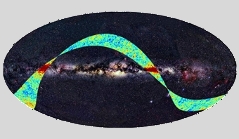 | PLANCK first light survey completed ESA�s Planck mission has completed its first light survey on August the 27th. Preliminary results coming from the two instruments on-board the satellite confirm the excellent quality of the data. Planck has now started routine operations that will last 15 months, and will provide all-sky maps of the microwave sky in 9 frequency bands from 30 to 857GHz. More information are available on: http://www.asi.it/it/news/planck_fa_il_primo_salto_nel_tempo_0 (italian) http://www.esa.int/SPECIALS/Planck/SEM5CMFWNZF_0.html (english) |
May 4, 2009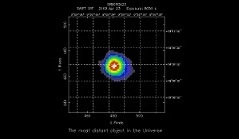 | Swift discovers the most distant object in the Universe At 07:55 UT on April 23 the Swift satellite detected the gamma-ray burst GRB 090423 and promptly slewed to observe it with the X-ray and ultraviolet/optical telescopes. Just after 72 seconds from the trigger, the Swift X-ray telescope began observing the field of the burst and found a fading and uncatalogued X-ray source which allowed a very accurate localization of the burst (~2 arcseconds). Following the Swift detection, several on-ground telescopes observed the event and found that its distance was about 13 billion light-years (corresponding to a redshift of 8.1), making GRB 090423 the most distant object ever seen. At the epoch of the burst, the Universe was less than 5% of its present age when only the earliest generations of stars were present. 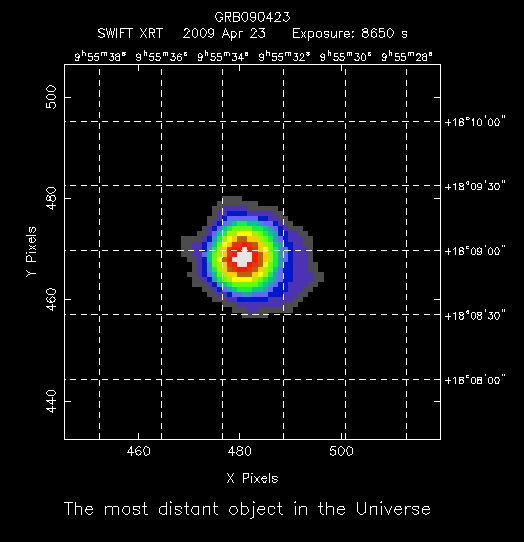 Swift-XRT image of the afterglow of GRB 090423 |
May 4, 2009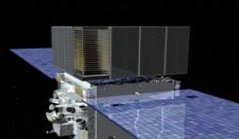 | NASA's Fermi Explores High-energy "Space Invaders" Since its launch last June, NASA's Fermi Gamma-ray Space Telescope has discovered a new class of pulsars, probed gamma-ray bursts and watched flaring jets in galaxies billions of light-years away. Today at the American Physical Society meeting in Denver, Colo., Fermi scientists revealed new details about high-energy particles implicated in a nearby cosmic mystery. For more details see: http://www.nasa.gov/mission_pages/GLAST/news/space_invaders.html |
April 21, 2009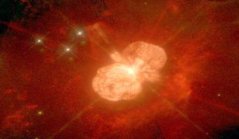 | AGILE Detection of Gamma-ray Emission from the Eta-Carinae Region AGILE Detection of Gamma-ray Emission from the Eta-Carinae Region M. Tavani et al., ApJ 698 No 2 (2009 June 20) L142-L146 During the period 2007 July - 2009 January, AGILE detected a gamma-ray source (1AGL J1043-5931) consistent with the position of the colliding wind binary system Eta-Car. A 2-day gamma-ray flaring episode of the source was also reported on 2008 Oct. 11-13, possibly related to a transient acceleration and radiation episode of the strongly variable shock in the system. If 1AGL J1043-5931 is the eta-Car gamma-ray counterpart, AGILE data show the first remarkable detection of a colliding wind binary system (CWB) at hundreds of MeV energies, confirming the efficient particle acceleration and the highly non-thermal nature of the strong shock in such system. |

